- Spirit 1.0 Plus
- Spirit 1.0 Evo
- Pod Drive Evo
- E-Series Battery
- G102-100 Battery
- Find a Dealer
- Have a Dealer Contact Me
- Product Registration
- Support Center: FAQ & Guide
- Video Tutorial
- Download Center
- Performance Bulletins

Electric Sailboat Motor: Range, Cost, Best Kits for Conversion
Today, owning a completely green sailboat has been made possible with electric sailboat motors.
Imagine cruising with the silence of an electric sailboat motor and the ease of use with a simple press on the start button. What’s better is there are no exhaust fumes at all with significantly less maintenance.
It’s so appealing that a lot of sailing liveaboards have made their electric sailboat motor conversion.
However, some sailors are still on the fence, worrying about the range and price of the electric sailboat motor.
If you are one of them, you are in the right place!
This post will guide you through every aspect you need to know about electric sailboat motors to help you make an informed decision.
Besides, you will get professional insights on how to make the electric sailboat motor conversion for your own boat and learn the best electric sailboat motors (with honest reviews).
Table of contents:
- Electric Sailboat Motors: Confusion Explained
Electric Sailboat Motor or Combustion Motor
- Electric Yacht Motor Conversion: Two Solutions
- How to Size an Electric Sailboat Motor
Best Electric Sailboat Motors (with Reviews)
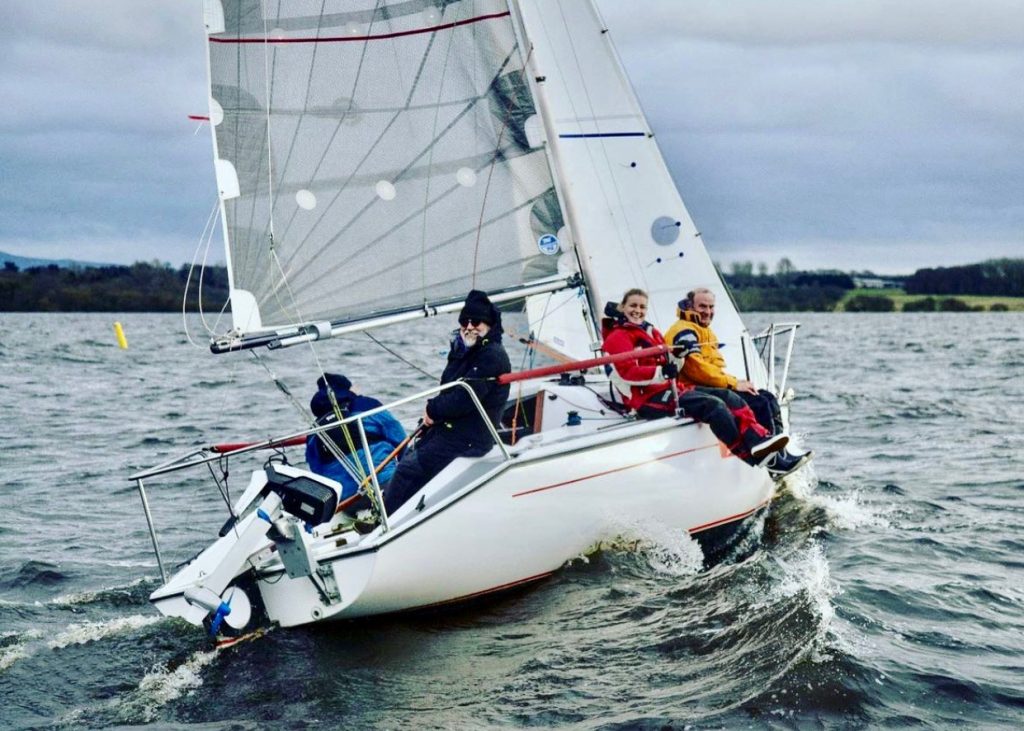
Electric Sailboat Motor: Confusion Explained
Can you go cruising with an electric sailboat motor? Can you put an electric motor on a sailboat? Are there any limitations?
Whether electric sailboat motors are a good fit for your boat is not a YES or NO question. Here we will explain your top worries with statistics and facts. That way, you can make a wise decision according to your situation.
You may hear some complaints about the batteries and range of the electric propulsion.
However, their experience may not suit electric sailboat motors.
In fact, even small electric engines work pretty well in many sailboats. That’s because most of the time, the wind can power the boat, and the motor is just used for docking or in rare times when there is no wind.
Therefore, it makes more sense to learn electric sailboat motor performance in real-world applications.
Here is a test report of a 3 HP electric sailboat motor on an RS21 racing sailboat:
| Power (W) | Speed (mph / kph) | Runtime (hh:mm) | Range (mile / km) |
| 50 | 2.2 / 3.5 | 20:00 | 43.5 / 70 |
| 150 | 3 / 4.8 | 6:50 | 19.3 / 31 |
| 300 | 4 / 6.4 | 3:20 | 12.4 / 20 |
| 500 | 4.2 / 6.8 | 2:00 | 8.5 / 13.6 |
| 700 | 4.8 / 7.7 | 1:30 | 6 / 9.7 |
| 900 | 5 / 8 | 1:05 | 5.6 / 9 |
| 1000 | 5.5 / 8.8 | 1:00 | 5.5 / 8.8 |
As you can see, the small electric sailboat motor can run at 5.5 mph top speed for one hour continuously.
And there is a big difference in terms of range vs speed for electric sailboat motors:
If you lower the speed, the range and runtime can be greatly extended. The slower you go, the further you’ll get. For example, if you cut your speed in half, the electric sailboat motor can last 7 hours and go 20 miles within one charge.
That’s pretty sufficient if you use the electric yacht motor mostly for docking or as an auxiliary engine.
Faster top speed (and more range) is available with higher power electric sailboat motors depending on your specific requirements. Contact a specialist to design your electric sailboat motor solutions.
Also, don’t forget to get the electric sailboat motor with regeneration (See recommendations below).
That’s to say, when there is a lot of wind and you’re moving rapidly via your sails, they regenerate and store electric power on the batteries to keep you moving at other times. Solar recharging is also a plus.
Essentially, the range depends on how many batteries you have, so it’s not a limitation of electric sailboat motors but energy and batteries.
If you are still worried, you can offset this by getting a diesel generator, which is more efficient than a diesel engine. And it is a range extender when you need it, but for 90% of your motoring that you don’t need the range, you can rely on the electric sailboat motor.
Some of you might be concerned about the extra weight of the batteries.
In fact, an electric sailboat motor with lithium batteries weighs less than a diesel engine, particularly if you include the fuel weight.
If you want a lightweight electric sailboat motor solution, make sure you get one with LiFePO4 batteries . Compared with other marine batteries, they are more compact in design with much less weight and higher energy density.
Some more advanced electric motors for small sailboats (such as Spirit 1.0 Evo) feature an integrated lightweight battery. So you don’t need to worry about the complex wiring to hook it up or extra space to store the battery.
This is a huge plus if you want to use the electric sailboat motor on a tender or dinghy.
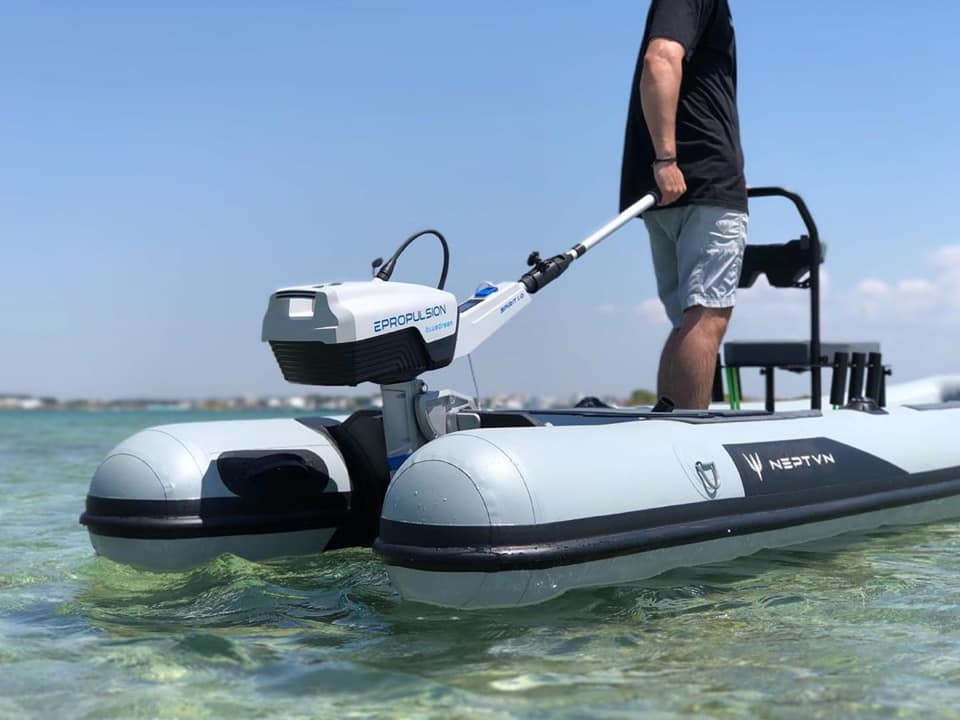
Here is also a chart that collects the weight of some popular electric sailboat motors for your reference:
| Model | HP | Motor Weight | Battery Weight | Note |
| Spirit 1.0 Evo | 3 HP | 11.3 kg / 24.9 lbs | 8.7 kg / 19.2 lbs | 1276 Wh Integrated Battery |
| Navy 3.0 Evo | 6 HP | 24.3 kg / 53.6 lbs | 48 kg / 105.8 lbs | 4096 Wh E80 Battery |
| Navy 6.0 Evo | 9.9 HP | 36 kg / 79.4 lbs | 87 kg / 191.8 lbs | 8960 Wh E175 Battery |
For many people, another big problem with electric sailboat motors is the cost.
It’s true that a gasoline outboard with similar power is a lot cheaper to buy. However, the electric sailboat motor eventually wins in long-term operating cost. That’s especially the case if you are going to do a lot of motoring.
Electric sailboat motors save on fuel and maintenance costs, which can build up to a large amount over time.
Here is a chart that compares the cost of a 3HP electric sailboat motor (coming with a built-in battery) with its combustion counterpart:
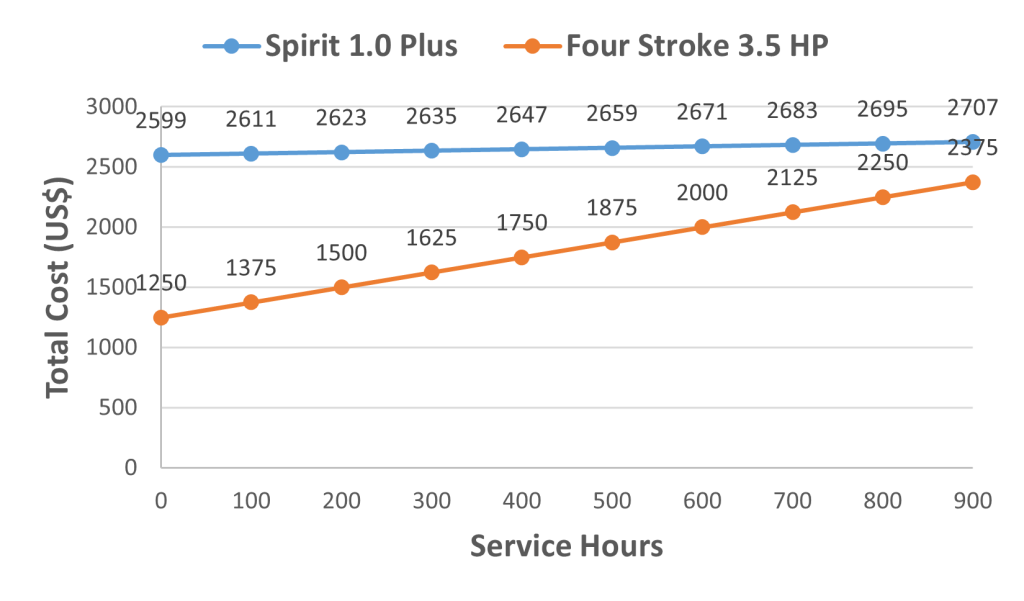
That’s to say, you will cover the price difference for electric yacht motors eventually as long as you use it long enough. Click to check the details of the calculation .
What makes the electric sailboat motor even more worthwhile is it saves you a lot of hassles, especially for sailors who only use the engine in and out of the harbor. Dealing with the maintenance of the gas outboard for a 10 minute motor out of and into the harbor is disproportionate and painful.
*The higher horsepower electric sailboat motor may be different in terms of the cost calculation. Check out the outboard motor pricelist by HP for more information.
As you may have already noticed, electric propulsion has already been widely used in the marine industry:
It’s quiet while motoring, clean to handle, environmentally friendly, with less maintenance and operation costs.
The electric sailboat motors are easier to use with dramatically fewer moving parts to break and no worries about being a diesel mechanic to deal with the hard pulling start. You can have it always on, so it is ready whenever you need it.
And it makes even more sense in sailing applications:
You don’t really need to motor much if your plan is to actually sail. If you are completely becalmed, you will probably just need to motor at 2 knots to keep making way, which is easy for electric sailboat motors.
If you mostly use the motor to get into and out of the harbor, the electric sailboat motor also works great for you.
You can always charge up at the dock, motor out of the marina (or even motor to your sailing area or race start), then hoist the sails and when you’re through, the batteries are charged again.
The electric sailboat motor is also useful as a backup (kicker) motor in case your system goes down. That’s why you can see people pushing a lot of big boats with small electric motors. (Click to learn more information about kicker motors .)
Personally, it’s really nice to have an electric auxiliary in the boat – no smelly, messy diesel and motor oil to deal with, a much simpler system with less maintenance, and much, much quieter operation.
However, powerboats tend to have much higher requirements in terms of both power output and runtime. In that case, an electric sailboat motor can be hard to satisfy your needs.
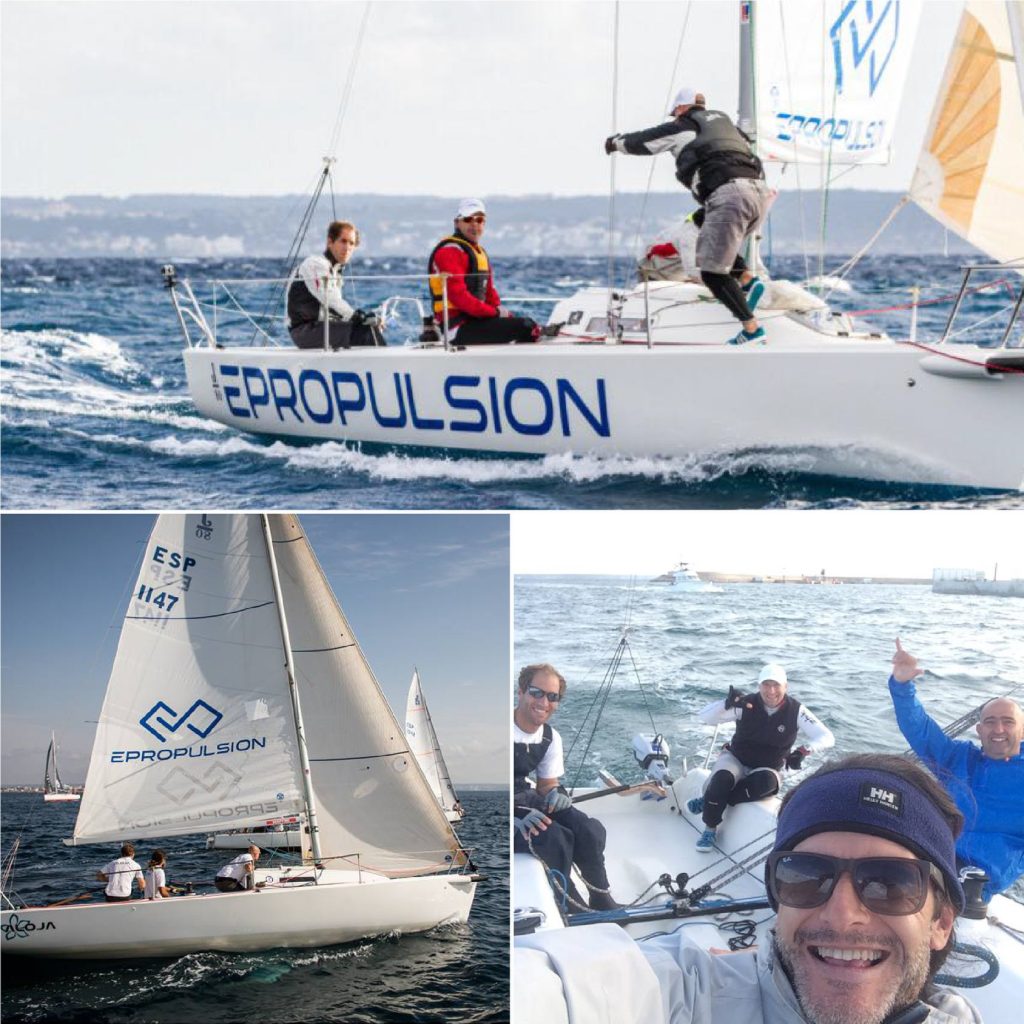
How Do You Size an Electric Motor for a Sailboat?
As a rule of thumb, you will need approximately 1 HP per 550 lb of the displacement of your boat.
Generally speaking, a 3 HP electric sailboat motor can push a sailboat up to 25 ft and a 9.9 HP motor is sufficient for a 30 ft sailboat to motor at a satisfying speed.
However, bear in mind the horsepower you need always depends on your needs and applications.
It’s better to check the data from real-world tests to decide whether the electric sailboat motor is suitable for your specific needs.
For example, the 9.9 HP electric sailboat motor Navy 6.0 allows you to go at 6.9 mph (11.1 kph) on a 30 ft sailboat, and the range can be extended to 46.4 miles if you decrease your speed to 2.9 mph (4.6 kph).
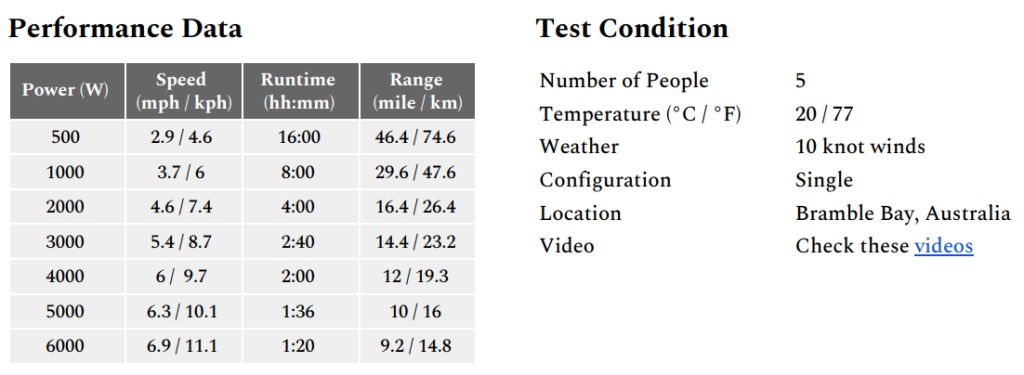
Click to see more test reports with other electric motor and sailboat combinations, and find the electric sailboat motor that suits you best.
If you are still not sure about the size of the electric sailboat motor for you, feel free to leave us a comment and we will get back to you ASAP with professional suggestions.
Electric Sailboat Motor Conversion
Basically, there are two ways for you to convert your sailboat to a clean and quiet electric drive system:
You can either convert your current vessel to electric or buy an engineless yacht and install an electric sailboat motor on your own.
#1. Repower Your Sailboat with Electric Motor
If you decide to replace the diesel engine with an electric motor, you will need to do a lot of preparations:
The DIY approach requires an electric sailboat motor kit (including motor and controller), batteries, a good level of mechanical ability and basic electrical knowledge, as well as some common tools such as a voltmeter.
You will need to take the old engine out for the new electric sailboat motor installation. It’s not an easy task that involves removing the engine mounts and the drive shaft (dealing with the numerous hoses and cables), taking out the engine, exhaust system, fuel tank, and its attendant tubes, etc.
Remember to balance the boat to avoid listing during the electric sailboat motor conversion.
Then in with the new electric sailboat motor. The installation process can be straightforward if you choose the electric sailboat motor kit wisely (See steps below). Furthermore, you can set up solar charging for your electric sailboat motor with solar panels and charger.
Many sailors have recorded their electric sailboat motor conversion process and experience. Be sure to check them out to get some inspiration. For example, Ed Phillips has documented everything which can serve as a guide for newbies to get started.
Mind you there can be a whole heap that can go wrong in designing and maintaining the electric sailboat motor systems. You really need to be totally on top of it if you want decent performance or reliability.
If you are not that technically inclined, it’s better to talk to a specialist first to discuss your plan for a smooth electric sailboat motor conversion.
#2. Install an Electric Motor in a Sailboat
If you own an enginless sailboat, the electric sailboat motor conversion is much easier for you.
All you need to do is to find a reliable electric sailboat motor and install it in simple steps. The whole process can be easily done, even for beginners. Here we take the popular 6 HP electric sailboat motor Navy 3.0 as an example to show you the installation process:
- Step 1 : Rotate the clamps or use the screws to fix the outboard onto the sailboat.
- Step 2: Mount the steering system in the proper position.
- Step 3: Install the tiller on the electric sailboat motor.
- Step 4: Connect the batteries to the electric sailboat motor system.
Click to check the video tutorial that guides you through each step of the installation.
If you are worried about aesthetic issues and want higher horsepower options, an electric inboard motor can be a better suit for your sailboat. If you prefer an inboard motor for your sailboat, contact our OEM team to get an electric propulsion solution tailored to your needs.
Note : You might find some electric trolling motors rated by #s of thrust on the market. Actually, those electric trolling motors for sailboats can only provide limited speed and range. If you are heading into the wind, the trolling motors for sailboats are definitely not an ideal solution.
Once you’ve evaluated if electric sailboat motors are right for you, there are a lot of options for electric systems.
Here are some popular electric sailboat motors with positive reviews from customers worldwide. Fast charger is available for all the models recommended to reduce your charging stress.
#1. 3 HP Spirit 1.0 Evo
If you are looking for an electric motor for a small sailboat, be sure to check out the ePropulsion Spirit 1.0 Evo. It’s suitable for large daysailers or small cruising sailboats under 25 ft.
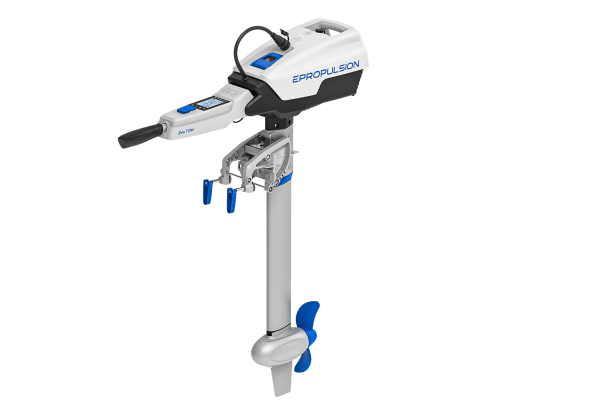
With the Spirit 1.0 Evo electric sailboat motor, you can go 5.5 mph (8.8 kph) at top speed on the 21 ft RS21 sailing boat, or troll for 20 hours continuously at 2.2 mph (3.5 kph) according to our test .
This electric sailboat motor with regeneration allows you to recover energy from the prop while under sail. It will start to generate power automatically when the sailing speed reaches 2 knots.
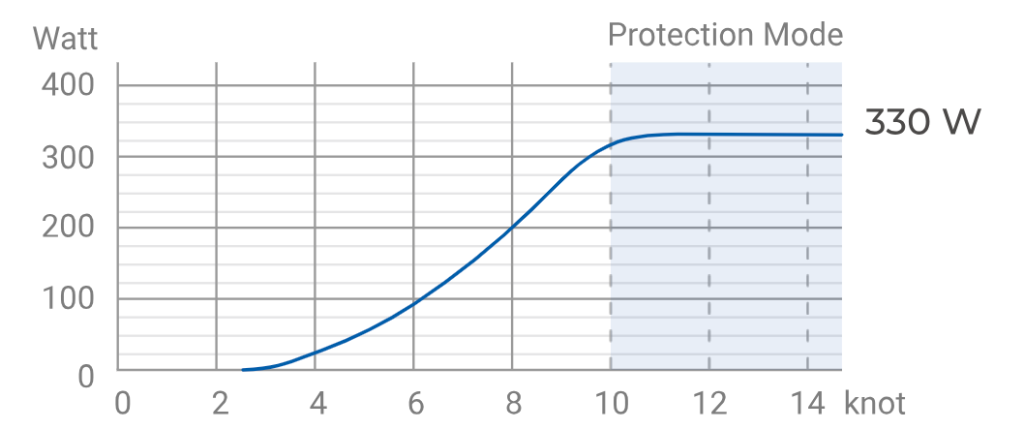
As an electric auxiliary sailboat motor, it can also be easily installed on your tender boats or yacht dinghies since it’s portable and easy to transport (with a lightweight integrated battery).
Features You Will Love:
- Come with the industry-first hydrogeneration capability
- Direct-drive technology makes it maintenance-free
- Portable with a 1276Wh large integrated lithium battery for long range
- Safety wristband keeps you safe in case of MOB
- Digital operation keeps you informed of the battery status
Spirit 1.0 Evo Electric Sailboat Motor Reviews:
“Great weekend with my 17′ sailboat powered by the Spirit Evo. This is great. Quiet and reliable. Went at 3/4 throttle for about 1.5hrs when taking it back to boat ramp.” – Robert Taylor
“Very happy with our Spirit Plus. Pushing our Kolibri 560 a 750 Kg sailboat, with ease. Doing about 5.8 km/h at 500W.” – Frank van Asten
#2. 6HP/9.9 HP Navy Evo Series
If you want a little more juice on the electric sailboat motor, check out the ePropulsion Navy Series. It offers 6 HP and 9.9 HP models for your selection and it provides sufficient power for sailboats up to 30 ft.
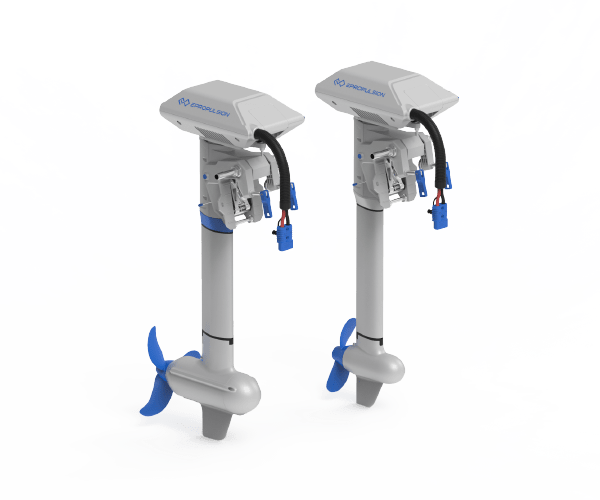
According to our test , the 6 HP electric motor Navy 3.0 can push the Catalina 25 sailboat (25 ft) at 6 mph (9.6 kph) top speed, while the Olga 33 sailboat (33 ft) can go at 7.5 mph (12 kph) with the 9.9 HP Navy 6.0 motor.
The Navy series electric sailboat motor also comes with regeneration features which can be recharged with hydrogeneration, wind turbine, and solar panel.
- Four controls to fit your sailboat installation and your boating style
- Accompany LiFePO4 batteries (need separate purchase) are more energy efficient
- Digital display offers real-time monitoring of the power and battery
- Magnetic kill switch and safety wristband keep you safe on the boat
- Electric start saves you trouble pulling the cord to start
Navy Series Electric Sailboat Motor Reviews:
“I have a Navy 3.0 with E80 on a Catalina 25 sailboat. It is working well. Currently I am using about 4% battery to go in/out of the marina by boat.” – Aaron Young
“Just finished my 8 weeks sailing journey in the Baltic Sea. The two Navy 3 outboards provide enough power for my 33ft catamaran. The 400W solar panels provided enough energy for engines and all other energy consumed on board with 2-6 persons. The two Navy Batteries provide power for engines and all other on-board electric devices. I never had to use shore power, so totally self-sufficient electric system.” – Martin Hildebrand
Recent Posts

ePropulsion Launches New Business Unit – ePropulsion Commercial

Outboard Motor Battery: What Size Do I Need & What’s Best for My Boat?

ePropulsion Partners with 37th America’s Cup to Supply Sustainable Electric Power for Autonomous Race Marks
Join the discussion cancel reply.
Save my name, email, and website in this browser for the next time I comment.
Notify me via e-mail if anyone answers my comment.
This site uses cookies to personalize your experience and analyze site traffic. By clicking accept or continuing browsing the site, you are agreeing to our use of cookies. See our Privacy Policy here .
View the Serial Number
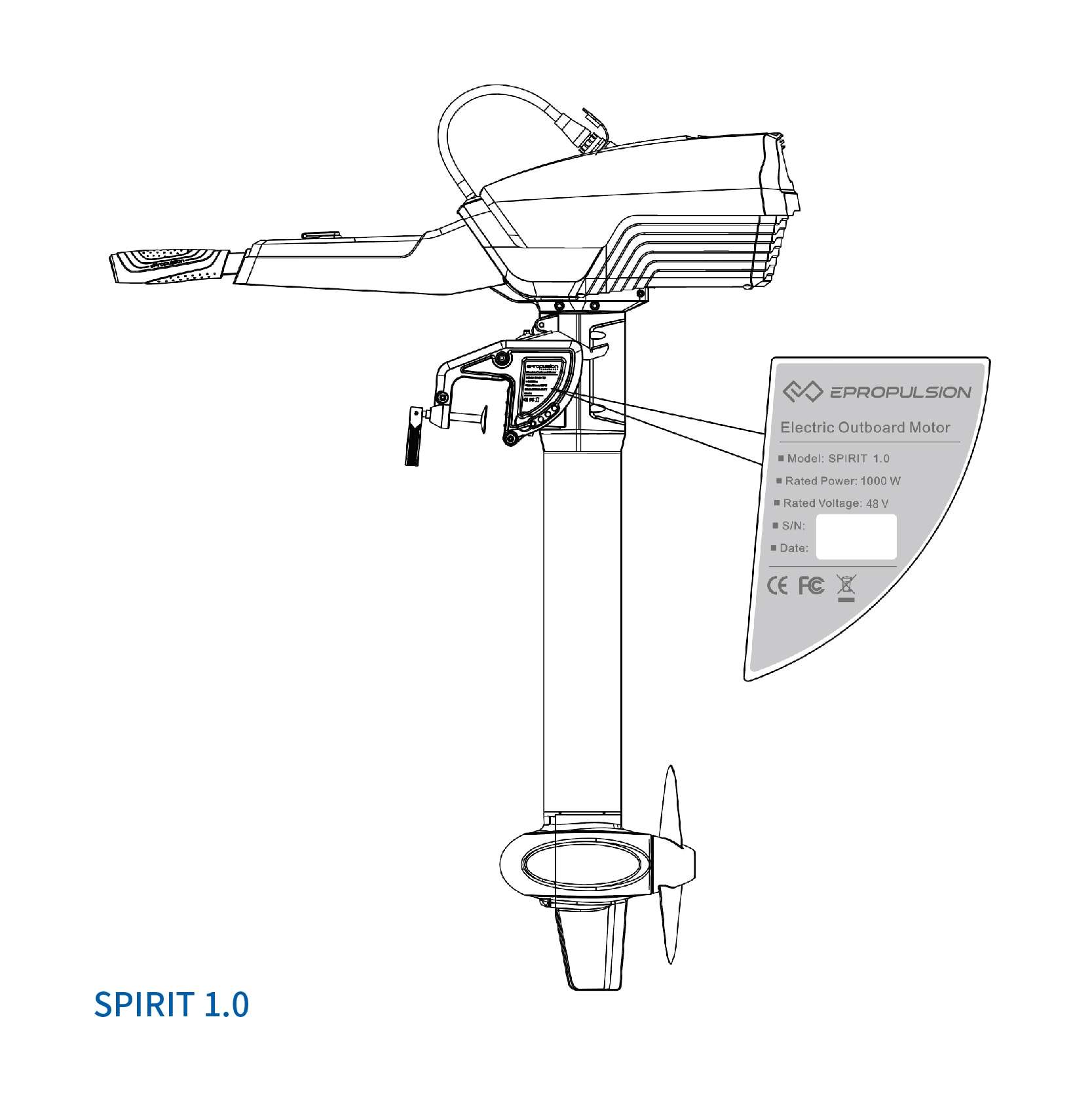

- AMERICA'S CUP
- CLASSIFIEDS
- NEWSLETTERS
- SUBMIT NEWS
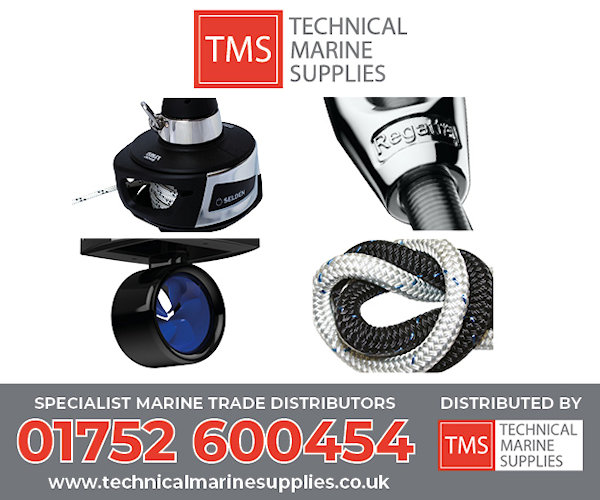
How to convert a small blue water, sailboat to an electric vessel on a budget
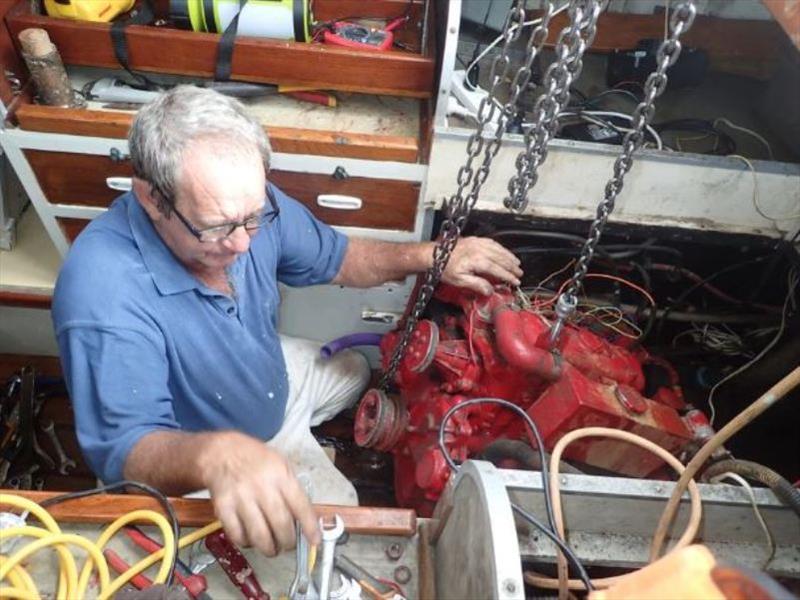
Related Articles
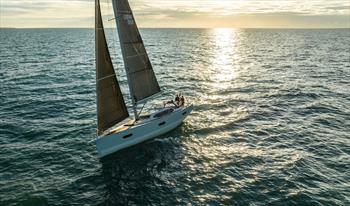

Propulsion Systems for Monohull
The silence of an Oceanvolt electric propulsion is a skipper's dream. Whether quietly maneuvering through a harbor or motor-sailing on low-wind days to create your own apparent wind, our electric solutions will enhance and extend your sailing enjoyment.
Oceanvolt offers Hybrid or Electric systems as a power & propulsion option in partnership with many leading monohull boat builders - adding new partners continuously. We also offer repowering solutions for converting away from legacy diesel engines – removing the diesel engine, fuel tanks and exhaust system - cleaning up greasy, smelly engine compartments and freeing up both weight and space below deck.
Oceanvolt systems are scaled and configured to achieve maximum efficiency - taking into consideration boat length, beam and displacement as well as system weight and placement within the boat. Range, beyond battery capacity, is extended through hydro generation while sailing above 6kn. This can be complemented with either a portable AC generator or a DC generator (in larger boats or for long distance cruising).
All Oceanvolt systems are engineered to operate at 48 volts for passenger safety and ease of repair. Oceanvolt systems are extremely low maintenance and do not require winterizing (no annual engine maintenance/storage costs).
system & price examples
Owner testimonials.
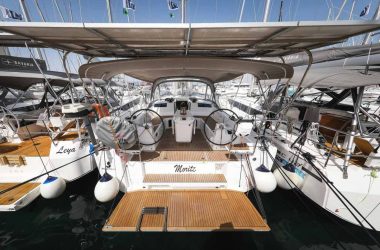
Electric Beneteau Oceanis 40.1 “Moritz”
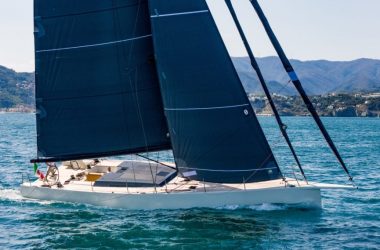
Maxi Dolphin MD55
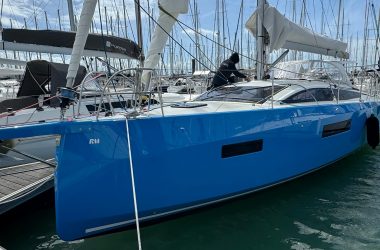
RM Yachts RM 1180

1410 Angler Ct
Ventura CA. 93001
- (805) 774-0637
Call for a Free Quote
Mon - Sat: 6am - 6pm
By phone after hours
Electric Sailboat Conversion
Electric Sailboat Conversion, repowering your sailboat or yacht with skilled professionals here at SB Marine Mechanic can take you through the entire process of converting your diesel engine driven sailboat or yacht to electric propulsion. Installing an electric motor on your Sailboat or Yacht can be a great way to reduce your environmental impact while still enjoying the benefits of boating. However, it’s important to ensure that the motor is installed correctly to avoid any safety hazards or performance issues.

NEW OCEANVOLT AXC – MODULAR SHAFT DRIVE MOTOR SYSTEMS
Step 1: choose the right motor.
Before you begin the installation process, it’s important to choose the right electric motor for your boat. Consider factors such as the size of your boat, the weight of the motor & batteries, and the power output of the motor. Be sure to choose a motor that is appropriate for your boat’s specifications to ensure optimal performance. later in the article we will show you some of our best suggestions.
Step 2: Prepare the Boat
The next step is to prepare your boat for the electric motor installation. This may involve removing any existing diesel engine or equipment that will no longer be needed. exhaust system , wire harness, plumbing. fuel tanks, and then degreasing and painting the space.
Step 3: laying out the setup of all the components.
More space is needed for your Electric Sailboat Conversion than its diesel counterpart. space for battery banks, chargers, cooling system, monitors, lots more wiring & the electric motor. laying out were everything is going to go ahead of time. will insure a smoother installation.
Step 4: Install the Motor
Once your boat is prepared, you can begin the installation process. Start by mounting the motor to the boat using the appropriate brackets and hardware. alignment of the shaft couplings is crucial to have the propeller turn as smoothly as possible.
Step 5: Installing the batteries
The batteries needed to power the engine must then be installed. Make sure to connect the batteries in the proper sequence and adhere to the manufacturer’s instructions for proper battery installation.
Step 6: Connect the wiring & chargers
It’s time to connect the wiring after the motor and batteries have been fitted. This may entail connecting the batteries to the engine as well as any additional electrical devices, such as a controller or charger . To guarantee proper wiring connections, be sure to carefully follow the manufacturer’s instructions.
Step 7: Engine inspection
After installing everything, the engine should be tested. Start the engine and listen for unusual vibrations or noise. Make sure the engine is running efficiently, and the electrical system is in good condition.
there are many different sailboat – motor yacht electric motors and horsepower ratings to choose from. here is some of the favorites.

Elco 100HP electric yacht motor . Elco Motor Yachts has been at the forefront of marine innovation, proudly boasting a rich history spanning over 130 years. The company supplied 55 groundbreaking electric launches at the 1893 Chicago World’s Fair. The vessels, powered by Elco’s electric boat motors, swiftly captured the hearts of boating enthusiasts worldwide. ranging from 6HP – 200HP.

Torqeedo Deep Blue 100i 900 electric yacht motor.
- Inboard system with power electronics and 900 rpm for displacement sailing
- This new addition to the Deep Blue family delivers 100 kW of continuous, emission-free power, ultimate torque, low maintenance.
- Suitable for yachts up to 120 feet long, this robust direct-drive motor delivers the low rotational speeds necessary to efficiently power large sailing yachts and other heavy displacement vessels.
- ranging from 3HP- 135HP.

Electric yacht QuietTorque™ 30.0 LC Electric Motor
Clean, green, and quiet electric propulsion.
Plug-n-Play engineered, tested, and ready for quick installation
Powerful, instant on allows easy maneuverability
Regenerative power while under the sail and motor in neutral
10 years of proven production with 1,000 installations
3 Year Warranty
- 48Vdc safe low voltage
Made in the USA
ranges from 3HP – 60HP.
Share this:
- Click to share on Facebook (Opens in new window)
- Click to share on X (Opens in new window)
- Click to share on LinkedIn (Opens in new window)
- Click to share on Mastodon (Opens in new window)
- Click to share on Nextdoor (Opens in new window)
Marine Diesel Engines We Service

- 1410 Angler Ct. Ventura CA. 93001
- [email protected]
- Marine Diesel Repairs
- Diesel Engine Diagnostics
- Marine Engine Services
Ⓒ 2023 - All Rights Are Reserved
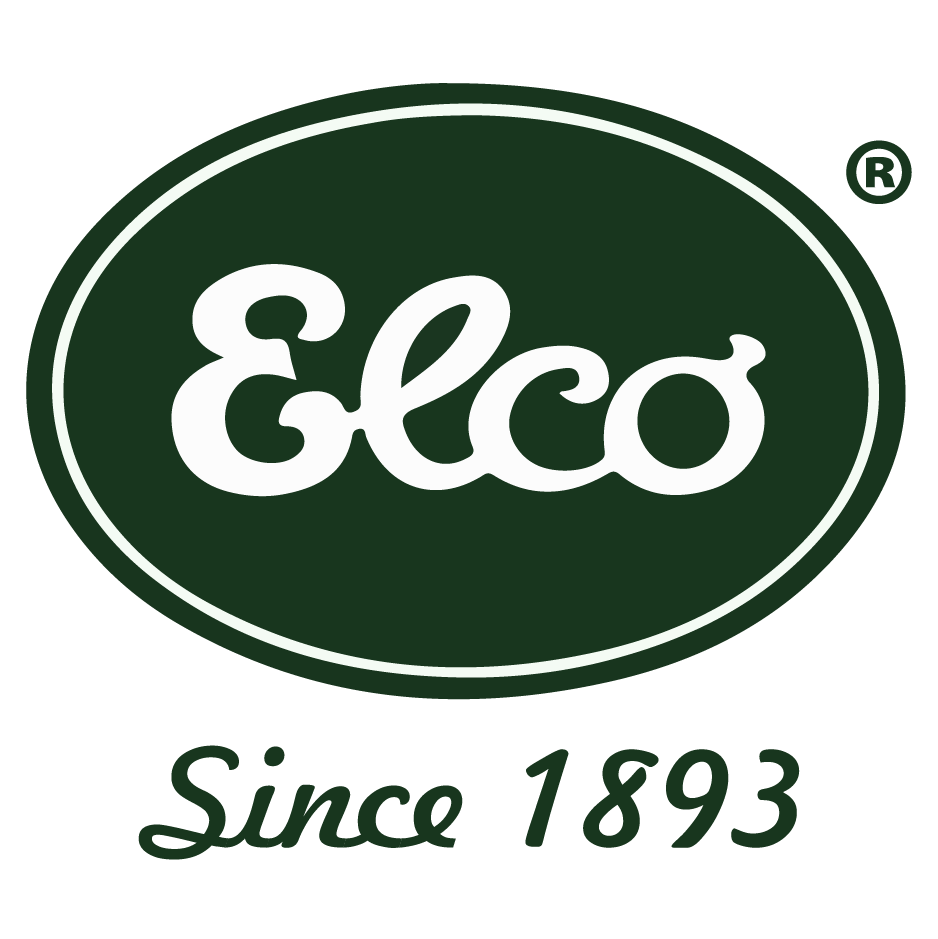
All About Electric Sailboat Motors: Efficiency & Performance
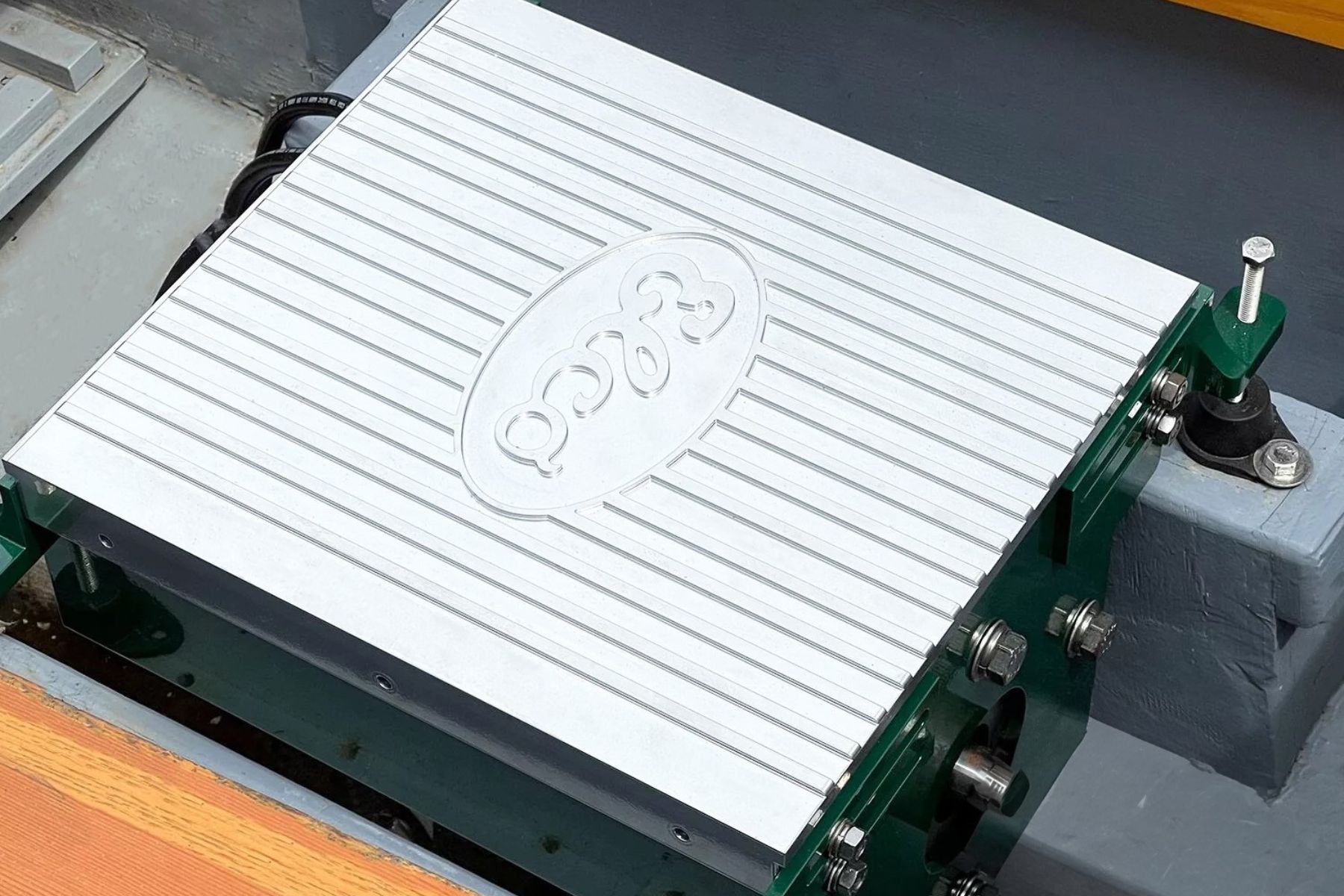
Exploring the Environmental Benefits of Electric Boat Motors
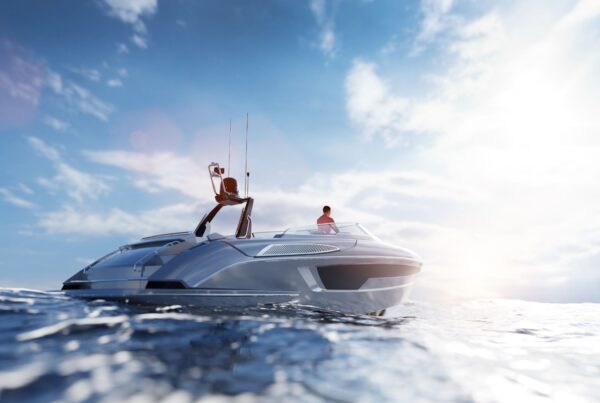
- Privacy Overview
- Strictly Necessary Cookies
This website uses cookies so that we can provide you with the best user experience possible. Cookie information is stored in your browser and performs functions such as recognising you when you return to our website and helping our team to understand which sections of the website you find most interesting and useful.
Strictly Necessary Cookie should be enabled at all times so that we can save your preferences for cookie settings.
If you disable this cookie, we will not be able to save your preferences. This means that every time you visit this website you will need to enable or disable cookies again.

Electric Motor
Please note:.
The following information is in regards to our initial set up. It has been almost 5 years since we wrote this. Many upgrades and improvements have been made since then. All can bee seen on our Youtube Channel. Updated wiring diagrams, specs and photos will be coming soon. In the meantime, much of the below information is still accurate and I’m sure you will find it useful. And the answer to our most asked question is YES, we still love our electric motor!
WHY ELECTRIC?

An electric motor . . .
Is not for everyone..
Lets first take a look back in time when “production” boats became popular in the late 60s early 70s, the intent was to make an inexpensive boat the average family could afford and handle with limited sailing experience and knowledge. As a result, one of their requirements was the ability to move the boat in difficult situations. This is where the “auxiliary engine” was coined. But, for many, it has become the primary means of maneuvering their boat. Yes, there are places in the world you can’t sail, like the Panama Canal. But, there are often alternatives where you CAN sail.
“We have yet to use our motor for more than 30 minutes at a time.”
As of today, November 2016, we have sailed over 3000 miles up the east coast of the United States and through the Bahamas to Haiti. We have yet to use our motor for more than 30 minutes at a time. The majority of use comes when we drop the mainsail and back down on our anchor to set it. Most of our sailing has been offshore. But, we have also sailed on the ICW and recently sailed 25 miles up the Cape Fear River to Wilmington, NC. We have sailed under many bridges, some on set schedules, others open on demand. In all cases, we sailed under. We have found that having a solid plan and the patience to wait for the right weather and tide is the key.After all, we own a sailboat. They are inherently slow. We are not in a rush. We love the idea of being self-sufficient. But, for those who sail with schedules, are short on time, lack the patience to sit out a wind hole, feel the need to power their boat to hull speed, enjoy maintaining a diesel engine, or are just set in their ways, then an electric motor probably isn’t the right choice.
Want to learn even MORE…?
Of course we would love for you to stick around and read this page all the way to the bottom, but, we have tucked in many distractions (i.e. links) along the way. Don’t feel bad if you digress, we know you’ll be back. If you want to just jump feet first into all things “electric sailboat” Electric Seas is a good place to start. It’s a great resources community and features several other electric sailboat stories for you to enjoy.

ANOTHER POTENTIALLY GREAT RESOURCES….
“My Electric Boats” by: Charles Mathys.
Although this book is currently on our Amazon wish list, we have not read it yet. But, it is the only one we could find on the subject and, for only $15, it looks promising. If you read it before we do, let us know what you think!

You don’t need a diesel . . .
For ocean passages..
Many people have written in and commented that an electric motor is only good for day sailors who weren’t going very far each day, and that you need a reliable diesel engine for long distance cruising. But we feel like the opposite is true. Since we don’t have a dock to tie up to and charge our batteries each night, we rely on sailing to recharge our system. The longer we sail and the more sun we get, the more power we make. Because we don’t have a 9-5 to return to at the end of a fun weekend out on the boat, we have no schedules requiring that we make it back to the dock on time, no matter what the wind is doing. So, we feel that an electric motor, depending on your sailing style, can be adapted to any boat. But, you have to be willing to work around the one major draw back, range.
“We have no schedules requiring that we make it back to the dock on time.”
Range is the one major downside to an electric motor. But, with a sailboat, and some adequate sailing skills, we have found we really don’t need a motor as much as we originally thought. For those who do have schedules, the possibility of a hybrid system may work well. It encompasses all the benefits of an electric system with the added back up of a diesel or gas genset rated to supply adequate power for extended motoring. Some companies even offer an electric motor, like this one, that can be installed in parallel to an existing diesel motor. So the majority of motoring is done with the traditional diesel, however for short periods of time, like moving around the marina, the electric drive can be used instead. This also incorporates the added benefit of capturing power from the spinning prop while sailing, often referred to as “regeneration” or “regen”.
Our conversion to electric . . .
Started with our motor..
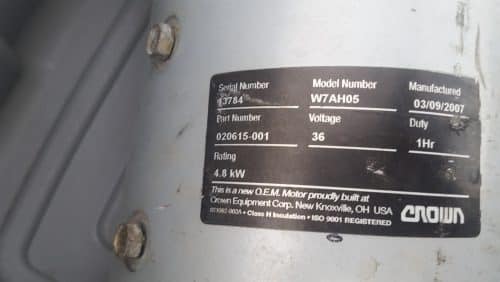
We found the motor on ebay.com, knew it worked and that was about it. We chose this specific motor for three reasons:
- It was rated at 4.8kW at 36v which was adequate for our needs.
- It was overbuilt for an industrial application. This meant it had robust parts and easy to source replacement brushes.
- The motor cost us $125! Since this entire “Electro-Beke” project is just one big experiment, we tried at every corner to keep our expenses minimal.
Our motor weighs 110 pounds, which is quite a bit more than its brushless DC siblings like those used in the existing electric boat market. Although it is probably a little less efficient, its components are much more robust and durable. It is heavy duty, low cost and provides adequate power, with the added bonus of being simple and easy to find parts for. The only parts we will likely ever have to replace are the 8 carbon brushes that transfer electricity to the motor armature (the part that spins on the inside). Depending on use, they can last for many years without wearing out, and for about $80 we can buy a complete replacement set to have onboard. That’s it, virtually maintenance free, with only 1 moving part, the motor itself is relatively simple. On our boat, simplicity is often the defining factor for equipment selection.
This motor happens to be wired with separately excited field and armature (or SEPEX). It just means that we have a lot more control over the motors power output. We can tune it down to have more low end torque, or up to gain high end speed. This will allow us to customize the power output we need for our specific boat. A few other types of motors out there include, Series , and Permanent Magnet that only have one set of coils. Each type has its own benefits and drawbacks. But we won’t get into any of that here. If you would like to know even more about DC motors, click HERE .
we didn’t buy new . . .
Because we received quotes from three different companies:.
- Here’s our quote from OceanVolt for their AX8 motor.
- Here’s our quote from Annapolis Hybrid Marine for a Thoosa 7000HT motor. Read their prediction for power consumption and battery drain.
- Click here to see some data and predictions from Electric Yacht for their Quite Torque 20 motor.
Our entire set up . . .
Cost us just $1,400..
As you can see by the above quotes, The motors and supplementary wiring are all in the $10,000 price range. That doesn’t include a battery bank. Our motor and wiring cost us just under $500. Many of our components were refurbished, used or salvaged from boats being demolished, including some of the wiring. The battery bank and additional tools, like wire crimpers and cutters were another $500. So, for about $1000, we installed our Electro-Beke system. Our charging system ended up costing us only $400 thanks to a few amazing companies who joined our Uma Angels Family and supplied the major components. Find out more about our charging system in the “Charging” section below.
That Breaks down to:
$500 _ for the motor, controller and supplementary wiring. $500 _ for the batteries. $400 _ for the solar charger, panels and bimini modifications.
Power required . . .
To push our boat and yours..
Our motor has an 8hp rating. For those accustomed to gas or diesel engines, this may not seem like much power. But, the rating systems used for gas engines and electric motors are so different that comparing the numbers is almost meaningless. It comes down to the way the two types of motors use their energy and torque curves, which is quite different. According to the research we have done, a 1 hp gas (or diesel) engine can push 500 pounds of displacement to hull speed in calm conditions. Now, the sources disagree a little here, but as a rule of thumb a 1hp electric motor can push about 3 to 3.5 times more displacement than its petrol equivalent. So a 1hp electric motor, drawing 750W, can push about 1500 pounds of displacement.
“Hull speed’ and ‘redundant power’ weren’t something we worried about in our system.”
Our boat displaces 13,500 pounds. so, 13,500 / 1500 = 9hp electric motor., now 1hp (of electric) draws about 750 watts. so, 9hp x 750w = 6.75kw electric motor..
At 48V, our motor should give us 6.3kW, which is slightly less than what we would need to push our boat to hull speed in calm conditions. But that is something we never intend to do. It takes a lot of power to push a displacement boat to hull speed. So the slower you go, the greater your range will be. However, it takes a long time to cover that distance. So, there is a sweet spot right around 4 kts (see graph to the right) where you make good headway, while being conservative with your power consumption. Of course, these are merely suggestions. Real world conditions are rarely perfect and adding 30% redundancy is often recommended by many motor companies.
We only use our motor for close quarter maneuvering where sailing isn’t an option, like a marina, or tight anchorage, so “hull speed” and “redundant power” weren’t something we worried about when designing our system. We often sail on and off the hook and choose places to anchor with few boats around.
Power | Speed | Range
Hover over any point to see exact data. For example, it is estimated that at 2.7 kts our motor will draw 600 watts (blue), giving us a range of 65 nautical miles (grey). This graph is based on a 14kW Lithium battery bank and a high end motor/controller combo.
Here are some great companies . . .
That install, sell, or can help answer your questions..
Thunderstruck-EV and EV-West are staffed by great people who would love to hear from you and help answer any questions you may have. They both offer DIY kits that will suit the needs of any boat. They can also help source adequate battery banks, help with solar and even find local experts to assist with installations as well.
If you’re looking for a more “plug and play” set up, check out the companies below. They represent the best in the industry and will gladly customize a set up for your specific needs and provide a detailed quote.

Elco Motors
elcomotoryachts.com
1 (877) 411-3526
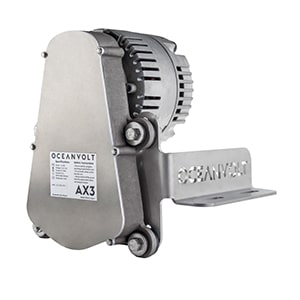
Oceanvolt SEA
oceanvolt.com
+358 10 325 5281
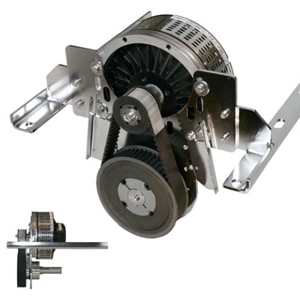
clean-e-marine.com
+1 (410) 353-4348
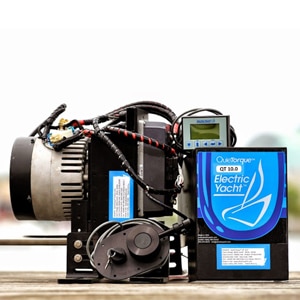
Electric Yacht
electricyachtsocal.com
1 (855) 339-2248
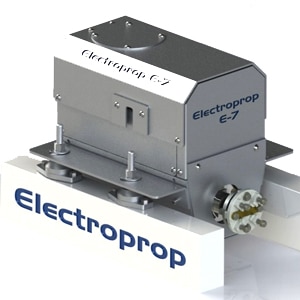
Electroprop
electroprop.com
+1 (805) 455-8444
WANT TO LEARN EVEN MORE…?
Here is another great article about “How much electric power do you really need? !!! !!!
INSTALLATION

Getting down to the Nuts and Bolts
For the complete parts list and wiring diagram, scroll down..
There is a lot to talk about here. Hopefully you can follow along and not fall asleep. Like…I …….am…….right….nowwwww(yawn)www… SLAP !!! Ok! I’m awake. Where was I. Right, wiring.
With no degrees or formal training in electrical engineering (and no, they didn’t teach us this stuff in architecture school), we had a lot of learning to do. Here we were, with a big heavy electric motor we knew nothing about, a boat it could theoretically push and the dream it would all work in the end. Now all we had to do was figure out how to get the motor to spin the prop. Sounded simple enough…right?
“…all we had to do was figure out how to get the motor to spin the prop.”
This step, of course took the longest. Since all our components were used, refurbished or salvaged, we had to test everything. We then started wiring the system in pieces in the salon and testing those. We then modified, adjusted, replaced and fabricated new systems and tested those. In all, it took us 9 months from motor purchase, to moving boat. Granted, not all of that time was devoted to installing the motor. We did have a few other projects on the side.
There are four main sections to our electric motor installation:
- The motor controller
- The batteries
- The wires that connect it all together

The motor we talked about previously. In all honesty, the main concern when sourcing a motor, is that it has enough power (watts) to push your boat to the speed you would like. The second concern is that it will work with the voltage of the components you choose. 12/24/36/48/72/96V are all common. The general rule, is that the higher the voltage, the fewer amps need to be pushed through the system to attain the same wattage. With this in mind, we have found that 72/96V systems tend to be more expensive than similar 48V set ups and, pushing a boat requires much less power that pushing a car. So, we’re not worried about running hundreds of amps through the system. Although rated at 36V, we run our motor at 48V so we can utilize available golf cart components for the rest of our systems, which are also inexpensive and abundantly available. For our boat, we designed the system to handle 150 amps. This would give us a theoretical output of just over 7kW (48V x 150A = 7.2 kW). If you were paying attention earlier, you might notice that our motor is rated for only 4.8kW at 36V. That is a continuous rating however. It can handle more, but cannot sustain it for long periods of time without some external cooling system. But, because there are times when we need all the power we can get, like stopping or backing down on the anchor, we decided to run our system with a higher amperage rating to accommodate that need.
CHECK OUT THESE PHOTOS OF OUR FINAL INSTALLATION.
(As usual, click to enlarge)
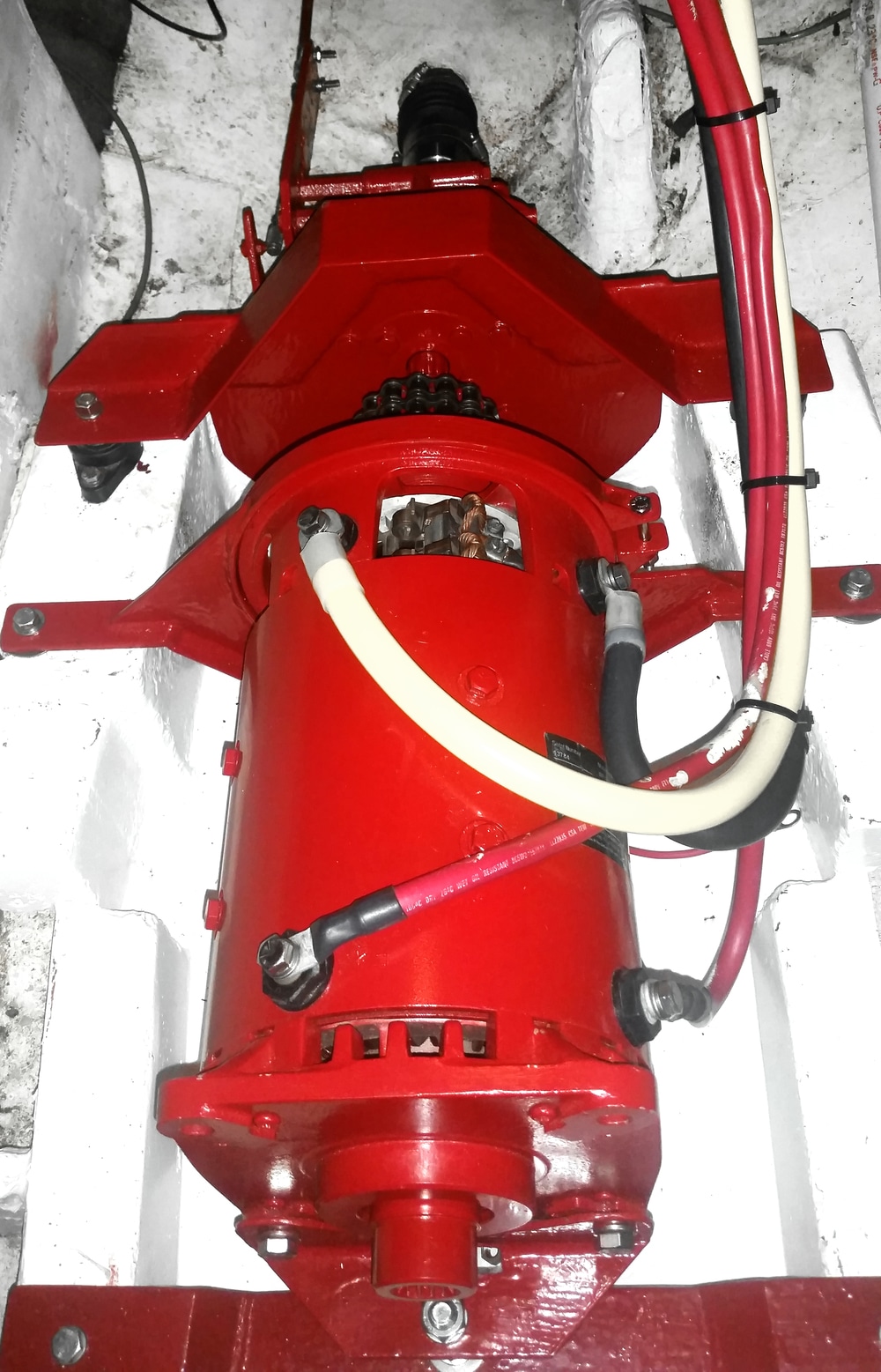
The Motor Controller
This little box is the heart of an electrical conversion. Similar to the head of an ICE (internal combustion engine), it controls the speed at which the electric motor spins. It does this by breaking up the power stream coming in from the batteries into tiny little pulses. This is called Pulse Width Modulation or PWM. There are many different types of controllers out there. In general, if you found a motor with standard voltage range, there is a controller on the market that will work for it. Some are more complex than others. Some offer built in regen capabilities, while other require computer programing and digital displays.
Our controller is a Curtis 1209B. It is designed to run a series motor, but since we got it for such a good deal, we made it work with ours by only using it to power the armature. See the wiring diagram below for more details. This controller is not fancy. It is weather proof, simple and robust. If you haven’t figured it out by now, we love simple and robust.
The Batteries
We will explain more below in the “BATTERIES” section. But for now, as long as you can create a battery bank that can be wired to produce the required voltage for the rest of your system, then you’ll be fine. Also keep in mind how much space and weight the bank will require. Ours fit perfectly where our old fuel tank used to be and helped offset all the weight we lost by removing the tank and the old diesel motor. For typical lead acid banks, at 36V you will need 3 -12v or 6-6V batteries. A 48V bank will require 4 or 8 respectively and so on. Although you can purchase massive deep cycle batteries with equally large aH ratings, we don’t see the value of them since it is very difficult to maneuver them into tight spaces on a boat. Ideally, if you can afford them, a lithium bank would be the best for an electric motor conversion. We’ll talk more about them in the “WHAT”S NEXT” section below.
All our wires our tinned copper or “Marine Grade”, although, we despise that term since it often just means “more expensive.” The majority of which, we scrapped off of boats that were being demolished at the boatyard. What we couldn’t find for free, we purchased from a local discount marine store that sold surplus marine components. This allowed us to spend very little for all the wiring.
For the most part it is all oversized, but when it comes to wire, the bigger the better. There are many useful online calculators that can help give an idea of what size wire will be appropriate for a given application. If your wiring is undersized, the system will lose some efficiency. For the most part this is of no concern. However, in extreme circumstances it will heat the wire to the point of melting things. For example, we undersized the cables connecting the motor controller to the armature, after a 15min full power test at the dock, we melted off the heat shrink tubing on the terminal lugs. It was quickly replaced by something much more beefy and hasn’t been a problem since.
O yeah, One More Thing . . .
The motor mount. .
Oops, almost forgot. Somehow we had to keep the motor inline with the transmission and securely mounted to the boat. We built and re-built 6 different mounting brackets prior to the one we have now. Each being fabricated after hours of sketches and models were developed. We didn’t have to modify the motor any or the transmission itself. However, we did modify the original transmission adapter plate that was used to attach it to the back of our Westerbeke. We then securely attached the transmission to the hull of our boat. This allowed the motor to float in front of it, leaving the transmission to absorb any thrust from the prop.
We fabricated the brackets out of steal since it is easy to work with and weld. Once we settled on a final design, we epoxied and painted the brackets and motor with engine enamel. We’re quite pleased with the final outcome. All the exposed metal is protected from corrosion and it is very securely mounted to the old engine pan.
In tandem to our bracket iterations, were several attempts to connect the motor to the transmission. Our early versions were poorly aligned causing horrible vibrations that in turn produced noise. Noise was something we were trying to avoid by going electric. The final design paired two identical sprockets, connected inline by a #50 double roller chain. This seems to work quite well. It allows for small misalignments and produces the least amount of noise. There are of course many other options out there, and someday we may experiment with them. But, for now, this set up works for us.
Take a look through our Electro-Beke playlist on Youtube for video of the installation process.

WIRING DIAGRAM
Including complete parts list..
Here it is. The schematic you’ve all been requesting. You may notice that it is drawn for a direct drive system, where the motor is used to electronically shift from forward to reverse. We have since installed our motor in front of our old transmission and no longer need the Fwd/Rev circuit. However, since the majority of set ups out there use the motor to achieve Fwd/Rev, we wanted to show our diagram depicting a similar set up. If you end up with a Series or PM motor, you should be able to modify this diagram by excluding the 12V bank to motor connections. However, many of the components, like the contactors, require a 12V supply to operate their solenoids. So you will still need a 12V accessory bank. This is often the house bank of a boat, since many smaller boats run 12V house banks anyway.
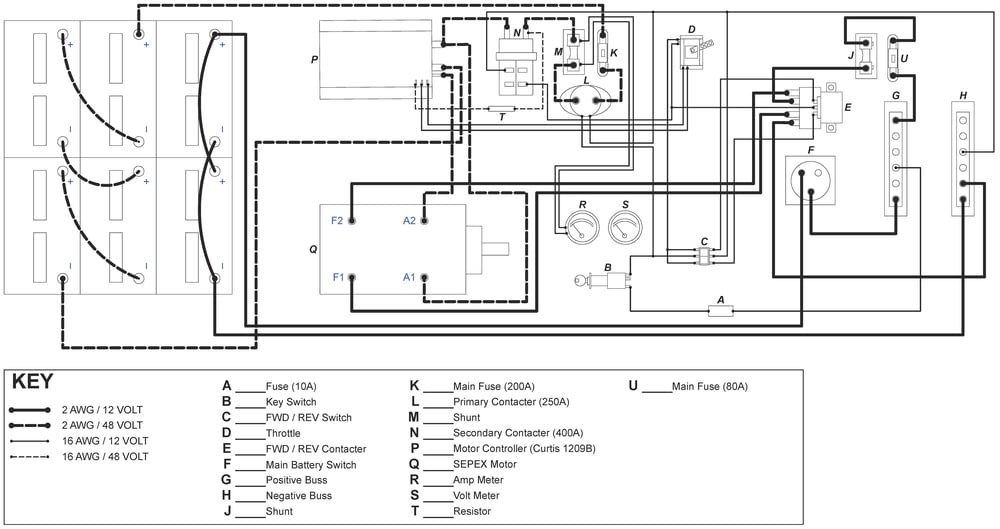
Below are the components we used, why we chose them, where to buy them and pictures of them installed in our boat. If you didn’t figure it out already, their letters correspond to the diagram above.
(A) – 10A FUSE
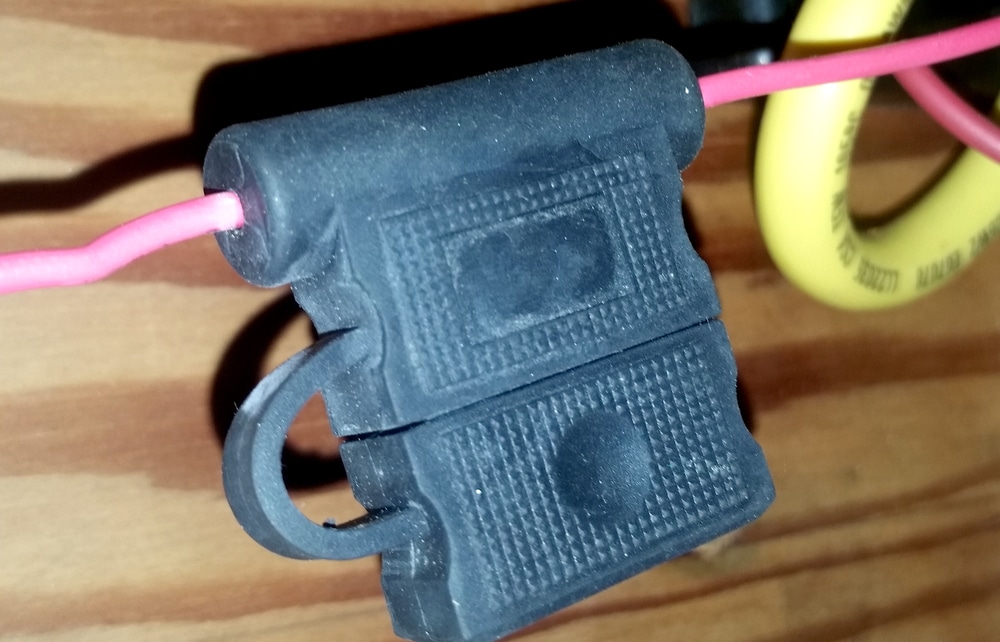
Buy one HERE .
This is a simple automotive fuse held in an inline fuse holder. It protects the ignition circuit wiring from drawing too much amperage in the event of a short.
(B) – Key Switch
Buy one here . .
The key switch is mainly for security. It can be replaced by a simple on/off switch, but taking the key out will slow down someone trying to leave with your boat, without your permission.
(C) – FWD/REV Switch
This switch is only needed if you are planning a direct drive system. We no longer have need for it, but also have yet to rewire our system after we installed the transmission. It is a basic rocker switch with an on/off/on rocker and 6 pins on the back. This allows both positive and negative wires to be switched. We also wired ours so that it will shut off the contactors if switched accidentally while the throttle was engaged. That way it wouldn’t cause any damage to the motor.
(D) – Throttle
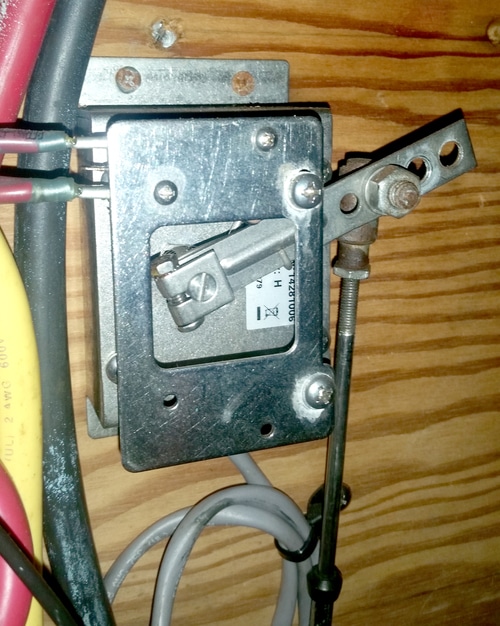
The throttle tells the motor controller how much power to send the motor. We chose this one because it allowed us to keep our existing throttle lever and cable mounted on the steering pedestal. It also has a micro switch that we use to close the secondary contactor (N) on the 48V side and the Fwd/Rev contactor (E) on the 12V side when the throttle is pushed forward. This ensures no voltage is going through the system until the throttle is actually engaged.
(E) – FWD/REV Contactor
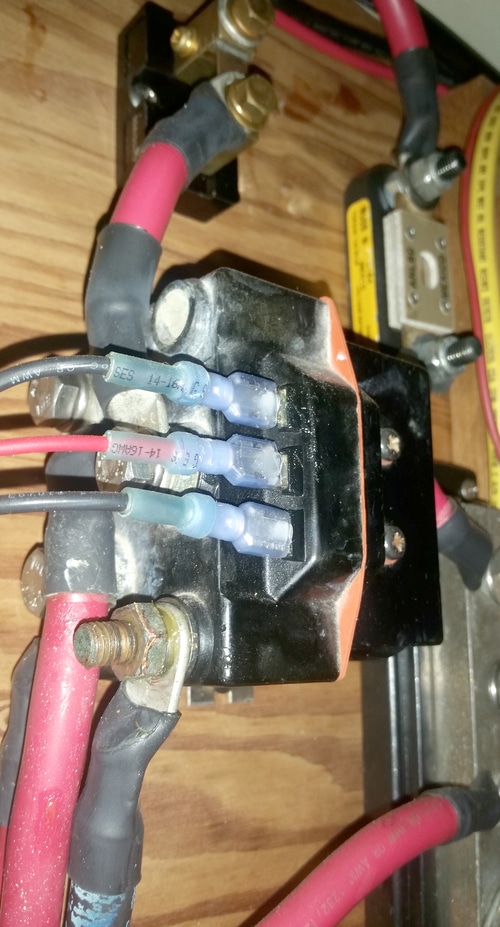
This, again, is not needed if you, like us, install the motor with a transmission that handles Fwd/Rev. However, if you are planning a direct drive set up, and the controller you chose doesn’t have a Fwd/Rev circuit, then this is a necessary evil. The one we used, we scrapped off an dead windlass. It works great for the 12V circuit and are easy to find.
(F) – Main Battery Switch
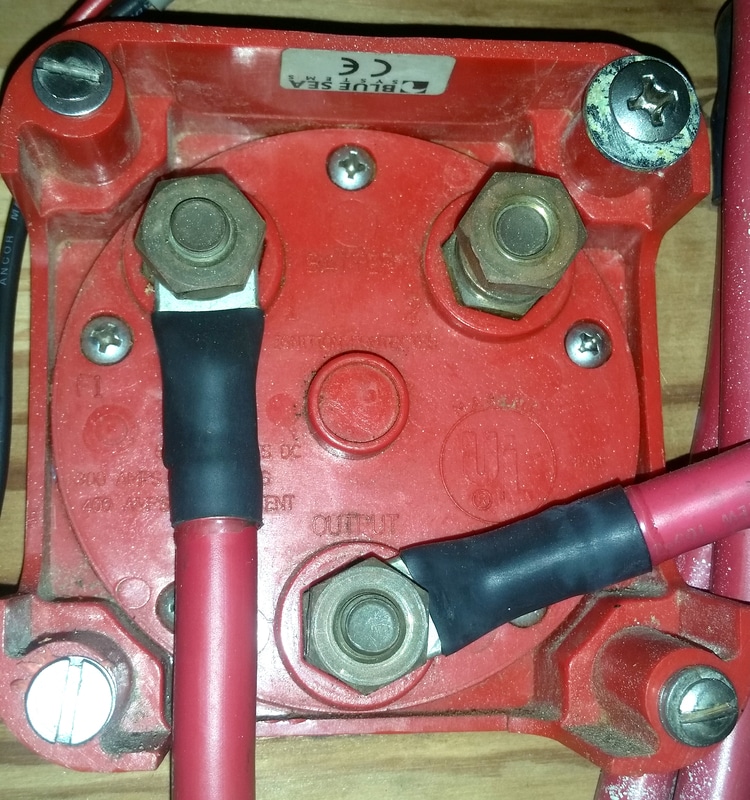
Our boat came with this switch installed already. We simply rewired it slightly to accommodate our systems. For now we only use the “Battery 1” and “off” settings. However, if we eventually install a DC-DC converter to bring our 48V bank down to 12V we could wire it to the “battery 2” position as a back up battery bank.

(G) – Positive Buss Bar
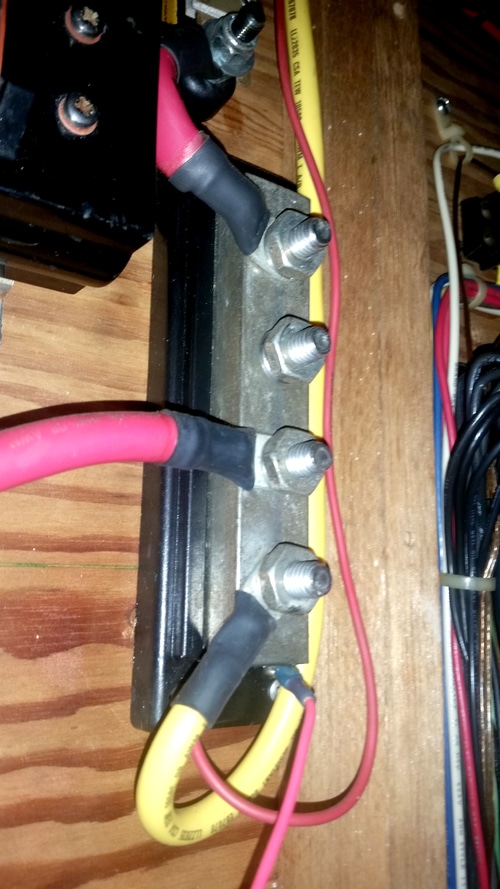
Pretty basic here. A buss bar is used to connect multiple leads to the same source. This one is beefy to handle high amperage on the positive side of the 12V circuit.
(H) – Negative Buss Bar
Same as the Positive buss bar above. However this one is tied into the 48V circuit.
(J & M) – Shunt
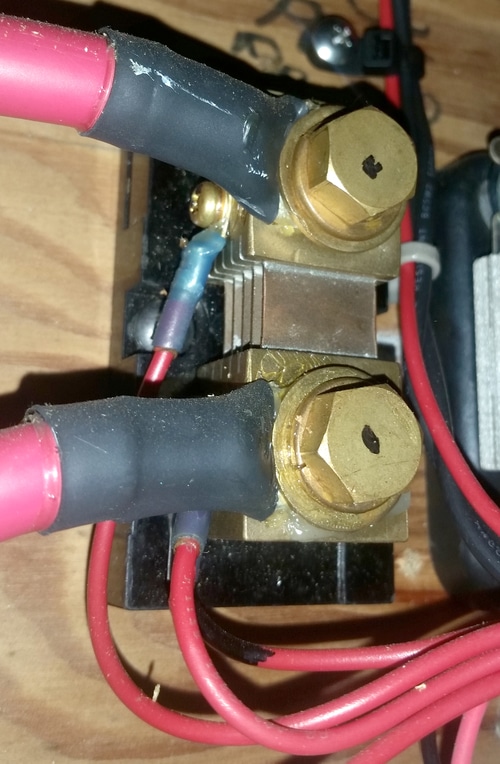
These are pretty standard. They are required to hook up an amp meter and measure how much amperage is running through your system. Often an amp meter will come with its own shunt. They sample the current so that not all 100+ amps are running through a meter. That would be very dangerous. Just make sure the shunt and meter are rated for the same mV, usually 50mV or 100mV.
(K & U) – Main Fuse
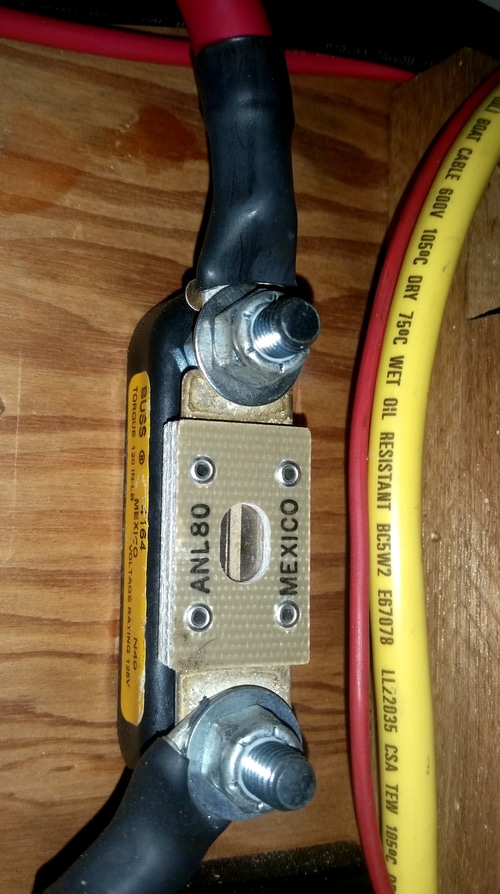
These fuses protect the wiring in the system. The closer to the battery bank the better. The fuse on the 48V side is rated for 200A and the 12V fuse is rated for 80A. These are rated for amperage only and can usually take a variety of voltages. Both fuses and holders are identical. They just have different ratings.
(L) – Primary Contactor
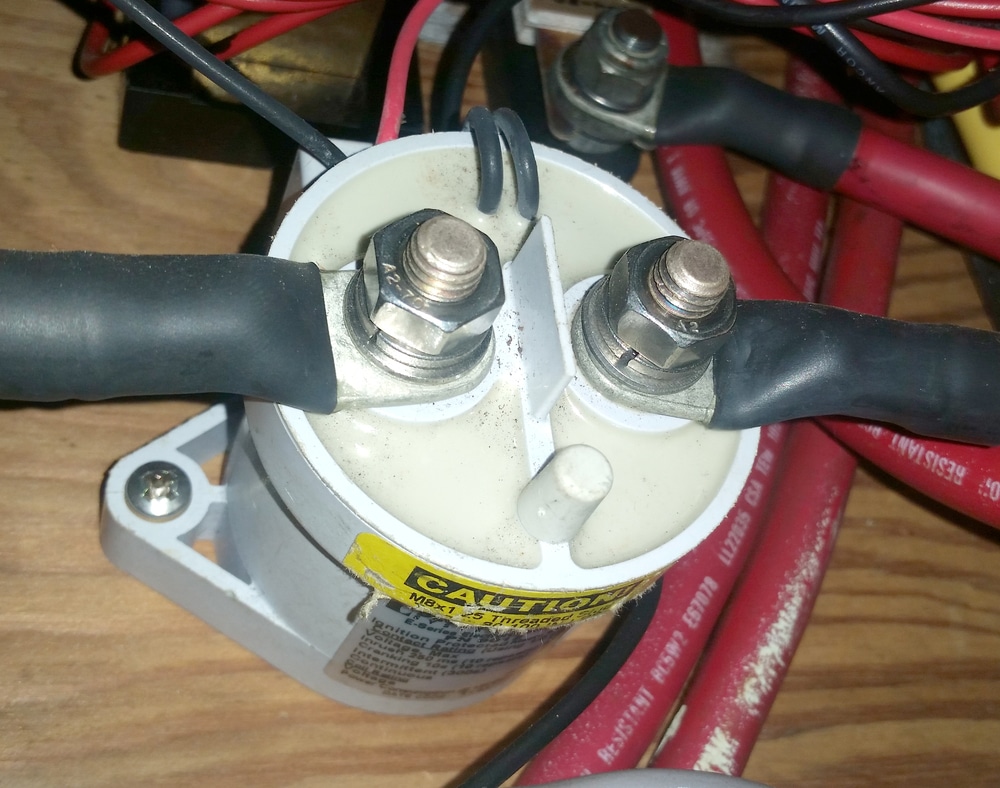
This contactor is wired to the main key switch. It is a bit redundant but shuts off any power from the controller, motor and gauges. It acts more like a battery shut off.
(N) – Secondary Contactor
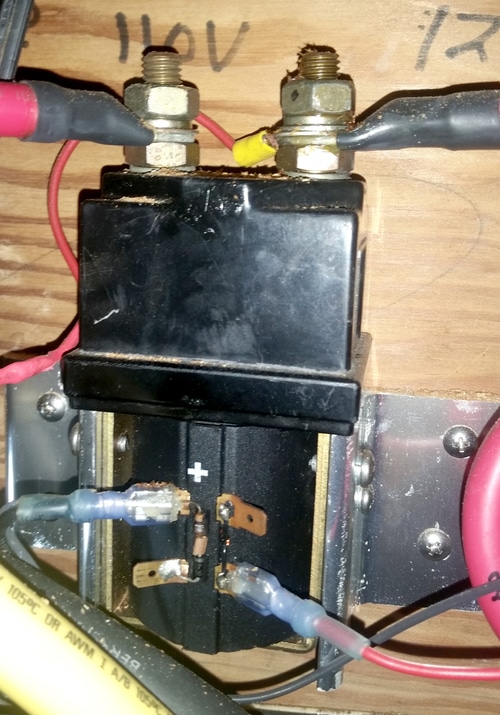
This contactor supplies the motor controller with the power it needs to run the motor. It is also the one that is bypassed by (T) the pre-charge resistor. Contactors are just big remote activated switches. Like breakers, they activate very fast to eliminate high amperage arching.
(P) – Motor Controller
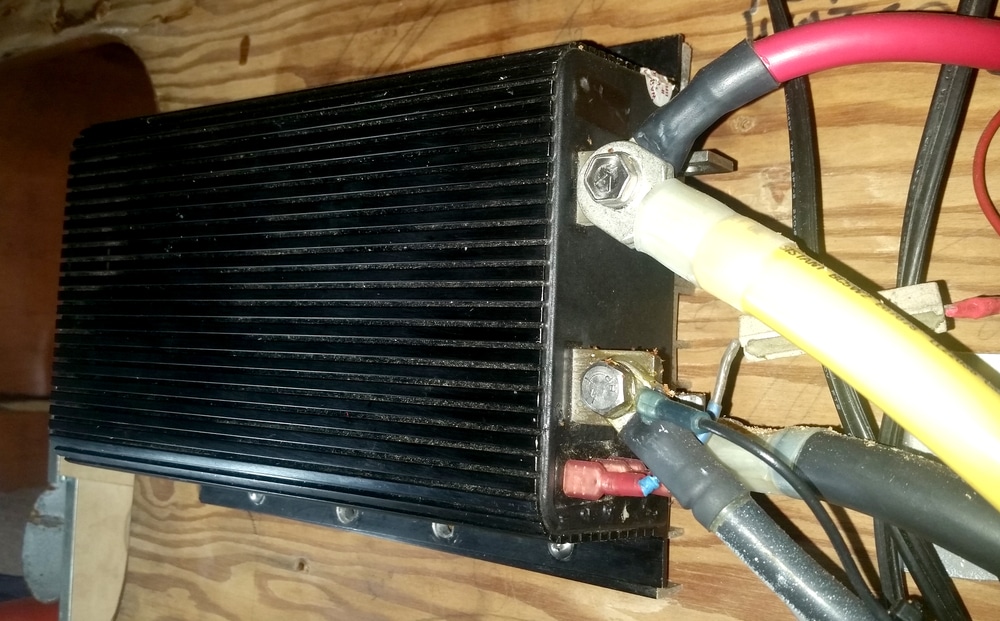
The motor controller we chose works for our application, but there are many out there to choose from. Do your own research here before deciding on what motor you will use. We happened to get a sweet deal on ours so we made it work with our motor. Our system would be less complicated if we used a controller designed for a SEPEX motor. The Curtis 1209B that we have is designed for a Series motor, but we make it work.
(Q) – DC Motor (SEPEX)
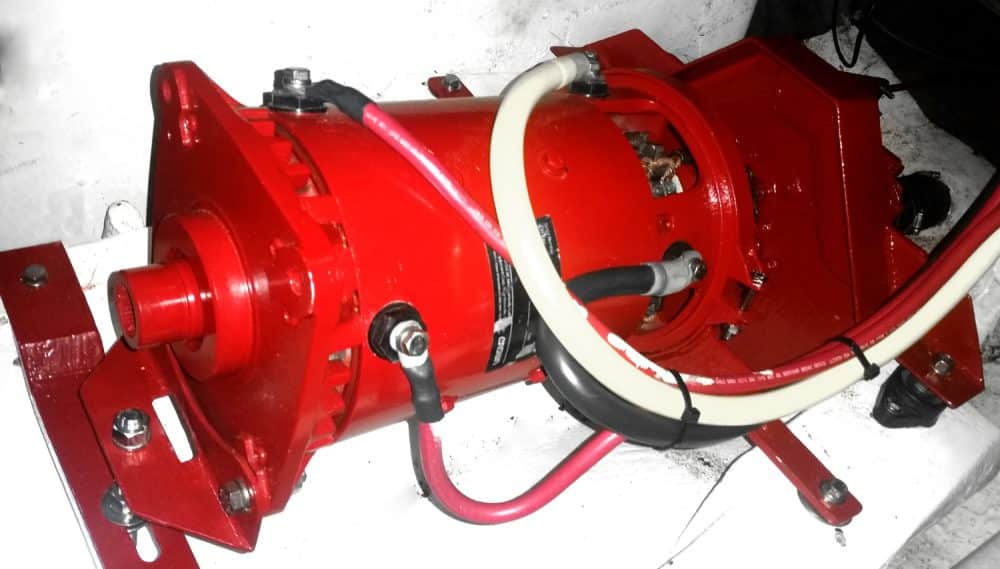
Sorry, you’ll have to find this one on your own.
Since another motor like ours has yet to show up again for sale online, we can’t really recommend the same one. However, the basic idea is finding a motor with the appropriate wattage to push your boat. Refer to our “Power Requirements” section to get an idea of what that might be. Then just make sure it will produce the desired power at a voltage that you would like to work with. We recommend 48V for most applications for reasons described previously.
(R) – Amp Meter
These attach to the shunt (J & M) and show you how many amps are running through the system. Depending on where it is placed it can either read the amps being drawn from the battery bank or the amps going to the motor. We decided to read the amps being drawn from our batteries.
(S) – Volt Meter
This meter does not require a shunt. As long as the negative lead makes its way back to the negative buss bar, the positive lead can be attached at any point along the circuit. We chose again to read the battery bank voltage with ours. However, it can also be place on the motor to read the voltage there instead.
(T) – Pre-charge Resistor
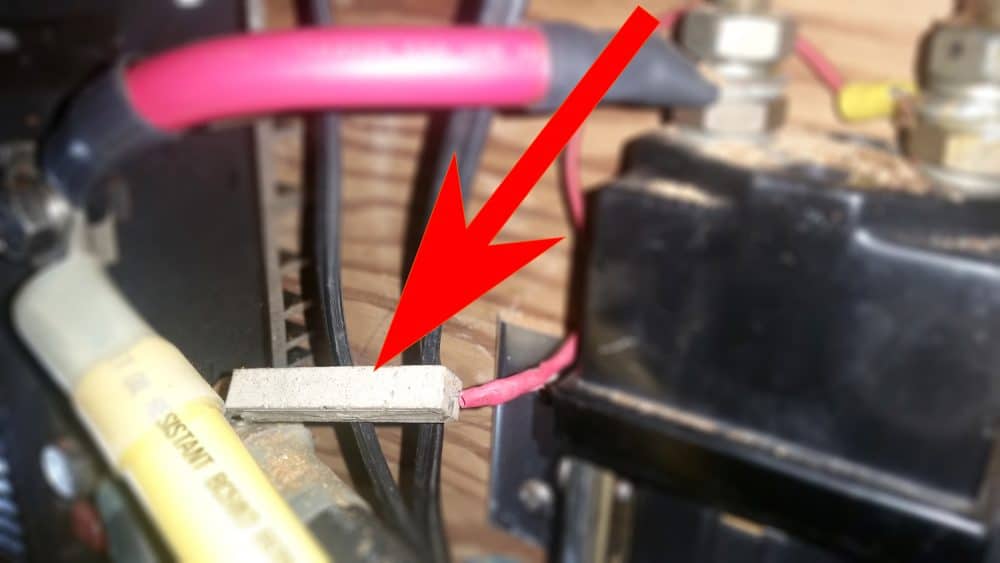
They look like THIS .
There is no specific item to show you here. Each controller and each set up is different. But, I can tell you that the pre-charge resistor is very important. It by-passes the main contactors and supplies the motor controller with the power it needs to pre-charge, so its ready when the main contactor is switched on and all that amperage comes rushing in.
Make sure you check out SV Bianka’s page for another detailed blog about his electric motor installation.For another great article about all the other stuff that goes into a motor installation,
you might want to read “Balance of System” . The article is for an electric motorcycle set up, but the basics are similar enough.

One thing we learned very early on was that . . .
Volts (v) x amps (a) = watts (w) or v x a = w.
At first we thought (please don’t laugh we were total newbies) that if we took 4 – 12V batteries with 125aH, and wired them in series, we would get a 48V bank with 500aH capacity. Obviously we forgot everything we learned in high school algebra. We soon resolved our mistake and learned that this formula is at the heart of everything electrical. As you can see, Watts are the thing you need to pay attention to. Remember high school physics? W=Work. Many appliances in your house, often things that produce heat, are rated in Watts, but marine stuff tends to rate things in Amps. Well, for our sake Watts are king. No matter what boat you have, it requires a certain amount of work (Watts) to push it through the water at any given speed. So, your job is to charge, store and supply to the motor a similar amount of wattage in order for your boat to move. The more watts you can store, the longer you can push your boat.
“The more watts you can store, the longer you can push your boat.”
As mentioned before, our motor is a SEPEX motor. This meant that the field and armature needed 2 separate voltages in order for the motor to spin. The way we solved this problem was with two separate battery banks. The field is powered by the house bank at 12V. This bank consists of two deep cycle batteries wired in parallel giving us about 250Ah at 12V. So far, it has held up great. It powers everything onboard including the inverter and laptops. We use about 30Ah on a slow day at anchor, and around 70Ah when sailing or when we’re both using our laptops all day at anchor. The nice part, is that even on a cloudy day, our 480W solar bank can replenish that before dinnertime. But we’ll talk more about that in the next section, “CHARGING” below.
The motor bank consists of 4 – 12V deep cycle batteries wired in series giving us about 125Ah @ 48V. This may not seem like much, but in the last month of sailing, we have logged over 1000 miles, including sailing 25 miles up the Cape Fear River, and have never depleted the motor bank more than 35%. That works out to drawing only 44Ah used. We’ll talk more about range and testing below in the “TESTING” section.
There are many types of lead acid batteries on the market. Don’t get too invested in brand. Most of the batteries on the market today are made by the same two companies. Trojan seems to be the brand of choice for many. We found batteries for sale locally and for $100 each, including delivery, we couldn’t pass them up. We also knew that the flooded lead acid bank we installed is only temporary. Like we’ve said before, this whole “Electro-Beke” thing is really one big experiment. We have plans to install a LiFePO4 bank soon enough. But we’ll tell you all about that in the “WHAT’S NEXT” section below.
There are many inefficiencies in electrical systems, like heat. However, don’t worry about them too much. If you budget 30% power redundancy into your system, it will more than cover any losses from heat, or mechanical friction and so on.
Check out www.batterystuff.com . They have useful calculators for battery banks and solar, along with great information on different types of batteries and what they are used for.
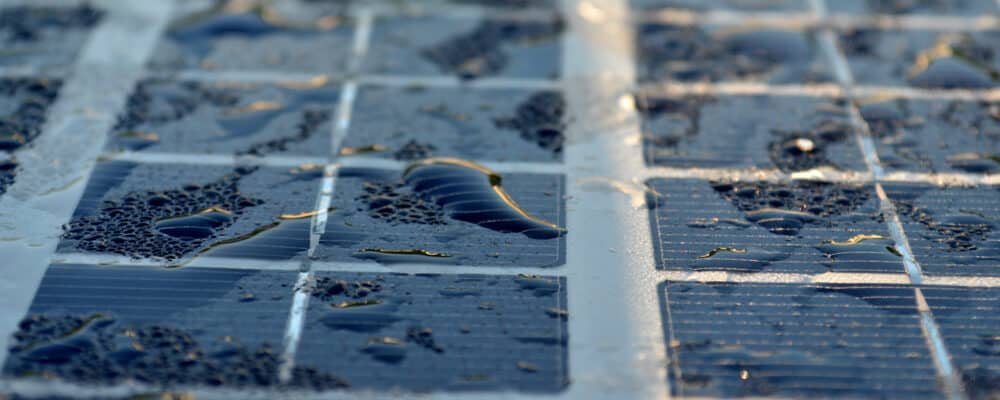
Our Solar System . . .
Also doesn’t include pluto..
We have 480 watts of solar. Broken down into 2 – 240W panels at 24v wired in series to give us a nominal voltage of 48V. Did you get all that? Great! Steven, from Solar EV Systems , gave us a great deal on them, landing him a spot in our Uma Angels Family . There are a several types of solar panels, but as far as we can tell, any modern panel is efficient and well made. None are much more efficient that others, it’s more about the size of your mounting space, and the size of your wallet. The ones we have are made by Trina, They are not expensive, look well made and perform exactly as promised.PV (Photovoltaic, aka solar panel) modules have three different voltage ratings that are handy to understand:
- The nominal voltage of a panel could also be called the “conversational voltage.” When we talk about the voltage of the panels and the other components of the system, we’ll most often use the nominal voltage. Nominal voltage actually refers to the voltage of the battery that the module is best suited to charge; the term is a “leftover” from the days when solar panels were used only to charge batteries. The actual voltage output of the panel changes as lighting and temperature conditions change, so there’s never one specific voltage at which the panel operates. Nominal voltage allows us, at a glance, to make sure the panel is compatible with a given system without having to look at the exact voltage. Our panels have a nominal voltage of 24V. We wired them in series which gives us 48V. It reality, they put out about 75V on a sunny day. But our charge controller allows us to charge a battery bank from 48V all the way down to 12V with the same solar panel set up. We’ll talk more about our charge controller later.
- The second voltage rating is the maximum power voltage (Vmp). This is the highest voltage the panel can produce while connected to a system and operating at peak efficiency. As mentioned above, the max our panels will produce is around 75V, even though we talk about them as a 48V panel system.
- The third voltage is open circuit voltage (Voc). This is the maximum voltage that the panel can produce when not connected to an electrical circuit or system. Voc can be measured with a meter directly contacting the panel’s terminals or the ends of its built-in cables.
Panels also have two different current ratings: current at maximum power (Imp) and short circuit current (Isc), both listed in Amps. The maximum power current is similar to Vmp: it’s the maximum current available when the panel is operating at peak efficiency in a circuit. Ours can produce 35Amps at max efficiency, They consistently produce 30A on a sunny day and we’ve seen as much as 32A. Similar to Voc, the short circuit current is the current measurement your meter would show when in contact with the positive and negative terminals of the panel while not connected to a system or load.All these voltage ratings and current ratings are often found on the back of a panel. Use them to estimate how much power they will be able to produce.
Two rules of thumb:
- 1kW or solar will produce 4kWh/day
- Rated Watts / 3 will get you approximate Ah/d @ 12V.
So, according to this, our 480W panels should give us 160aH on an average day, which we’ve found to be quit accurate. Although, we’ve only ever needed more that 100Ah of charge on one occasion. So usually, our batteries are charged back up before lunch, and we spend the rest of the day on “float” charge.
Types of Panels
Monocrystalline.
These are single silicon cells grown into larger crystals, then cross-section cut into small wafers to form individual cells that are later joined together to form a solar panel. This cell type has high conversion efficiency which means it takes up less space on deck. These cells are generally not shadow protected and are often more expensive per watt.
Multicrystalline (Polycrystalline)
These cells are also single silicon cells constructed by utilizing multiple amounts of smaller crystals to form a cell. This cell type has very high conversion efficiency but is also not shadow protected. Although, you should really be installing any panel so it doesn’t get blocked by shadows throughout the day. It will drastically increase the output if you install them in a proper location.
Amorphous silicon
These are the most inexpensive to manufacture. They are produced by depositing an active silicon material on various substrates like stainless steel sheet. The conversion efficiency is not as good as the single crystal type, but Uni-Solar panels are this type of panel and are shadow protected. Shadow protected means that a panel continues to charge when part of the cells are in a shadow, like a stay, which is a great advantage on a sailboat.
Our Charge Controller . . .
Is at the heart of it all..
The next, and possibly most important component in our charging circuit, is our Midnite Solar KID charge controller. This thing is amazing. Midnite also joined our Uma Angels Family when we asked them to send us a controller and they agreed. We spent a lot of time researching solar charge controllers and learning all about PWM vs MPPT. Bottom line is, if you can afford it, get the MPPT controller. We chose the Kid because it’s just the most efficient at collecting power from your panels. It is also easy to program and understand. We currently run it at 12V and just rewire our motor bank to 12V when we need to charge it. However, we will soon be adding a smaller, simple 12V charger to the “load” circuit of the Kid. This will allow the Kid to be permanently charging the 48V house bank. But, when it is full, switch over to the “load” circuit and charge our house bank through the smaller controller. It may all sound too complicated now, but once it’s installed and working, we’ll be sure to share everything with you in more detail.
“We have never gone 24hrs without fully charged batteries.”
On a boat, where space is at a premium, you need all the efficiency you can get. Right now, I’m sitting on the boat, it is overcast and raining outside, it’s noon and we’re getting around 100W of power in from our panels (about 8-9A @ 12V). Our house bank will be charged back up by dinnertime, same as the last few days, and we haven’t seen the sun all week. When it is sunny, our house bank is usually charged back up before we wake up in the morning. No we don’t wake up THAT early, usually around 10am, but seriously, if it’s sunny in the morning, we put 30+aH into our batteries before 10am. The charge controller runs silently, however it makes a tiny click when it switches from “resting” to “BulkMPPT”. Since on a boat, we’re attuned to every tiny sound, we usually here it click on and off a few times before the sun even rises. Mind you, it’s only putting in 0.5aH then, but still, the sun isn’t even over the horizon yet and we’re already charging our batteries.
Check out “Step 26” when we install our solar panels and charge controller.
The rule of thumb we used when designing our system is that 1 – 100W panel can charge a single deep cycle battery from 50% discharged in a single sunny day. So we have 6 batteries, so ideally we would have 600W of solar. Now, that just wasn’t practical for us, so we settled for 480W and it keeps up just fine. However, if we discharged our motor and house bank down 80% we would need about two sunny days to get them both topped back up fully. Or, about 4 rainy days. For us, this isn’t an issue since we typically use the motor for very short periods of time right before anchoring or when setting off for a multi day passage. So, by the time we need them again, their both fully charged and ready to go. If not, we’ll just hang out and drink a beer. So far it’s never been an issue or even come close to it. We have never gone 24hrs without fully charged batteries.
Many have suggested we have a small generator on board as a back up, just incase there is no sun for many days and our batteries are dead. So far, we have gone a full week without sun and our solar has kept up just fine. Although, we may design a system with the ability to be hooked up to a genset for extending motoring, like say the Panama Canal, so that if we ever needed to, we could just set a generator on deck for a few days and then get rid of it as soon as we’re done. But, for now the whole point was to get away from petrol dependance.
So far, solar is our only means of power production. We do have plans to get working regeneration from the prop while sailing. The possibility is definitely there, and we have tested for voltage while sailing. But as of today, we haven’t hooked up a charge controller to it. Mainly because we just don’t need it…yet. Our power requirements are so minimal and we use the motor so little, that we haven’t bothered to hook it up yet. But, it is on our short to-do list. So stay tuned for future updates.
HERE is a link to a great forum talking about solar systems, battery banks and how to balance them.

How far can you motor?
Maybe the most asked question we receive..
It’s a valid question for sure, and one that many have asked us. But, we have yet to find out. We are still early on in our testing phase of the experiment. We’ve used the motor many times but rarely for more than 10-15 min and never more than 30. It is also hard to find “ideal conditions” to test in. There either isn’t enough space, time or light. Or the tide and wind aren’t in our favor. Sounds like excuses we know, but it’s the truth.
“We are in no hurry to go anywhere, ever.”
From what we have done, we can tell you this. Our max speed has been right at 4kts. but it was against a slight current, maybe 1kt max. So, that would mean our theoretical top speed is closer to 5kts.
Here again, we haven’t actually found out. Mostly because without a tow boat right beside us, it would be dangerous to run out of power in the middle of a channel or bay where there are “calm conditions”. But, we’ve motored for 2 nautical miles at 3kts (with a 1kt tide in our favor) and it drained our batteries down to 70%. So, that would mean that in “ideal conditions” we could motor at 2kts for 6 nautical miles. Doesn’t sound like much, we know. But, with a favorable tide and even a slight favorable wind, we can extend that tremendously. We also wait for the wind and tide to be favorable and then just sail to where ever we need to go.
With limited area to mount solar panels and without a genset, we knew if we used more power that we could generate, we would always have dead batteries. So, from the beginning, we focused more on how much power we could consistently generate, and base our system off of that. To us, the meant using less, not necessarily making more. Our solar has kept up great so far, but our power needs have also been minimal. We have autopilot and a chart plotter that are always on when sailing. We also use our laptops constantly and run a small inverter for tools and small cooking appliances like blenders. We have all LED lights too. We don’t have a refrigerator yet or windlass. But they are on the short list. We also have yet to capture any power from the prop while sailing. So there is still room to capture more power if we need it.
As we continue to sail further and upgrade and modify our system, we will also continue to update you on how it all works here. So keep a look out for updates on our Facebook page and in future videos.
WHAT’S NEXT

We may have a spinning Motor . . .
But the fun has just begun..
Well, our motor works. It pushes our boat reliably. The Electro-Beke experiment is a success, at least in our eyes. Now the real fun begins. We’ve proven to ourselves that we can sail further that we thought and use the motor less than we originally planned. So, what’s next?
“We have a few more project on the list of upgrades and modifications.”
We have a few more projects on the list of upgrades and modifications. The first thing on the list is to rewire our system and remove the redundant components left over from the direct drive phase. After that, installing some better gauges and monitoring systems would be really nice. There is a “fuel gauge ” we would like to install for the motor bank and house bank. It is simple and relatively smart. It will give us an accurate state of charge in a quick glance.
Next on the list will be installing a charge controller or developing a similar system to allow us to capture power from the spinning prop while under sail. Technically our motor is capable of it, and early tests have augmented this theory. We are currently working with a few companies to figure out what the best system will be.
We also need to install a larger heat sink for our motor controller. The one that came with it is designed for air movement across its fins and is therefore undersized for our needs. However, we may be upgrading to a true SEPEX motor controller before long, so it will handle regeneration and would require a different heat sink anyway.
The big ticket item on the list is to install a large LiFePO4 battery bank. We have our eyes out for a salvaged Nissan Leaf or Chevy Volt that still has its battery bank intact. We’ve seen them for sale before and would love to get our hands on one. LiFePO4s are much more stable than other types of Lithium Ion batteries. But, we’ll talk about that if and when we actually get our hands on some.

- Forums New posts Unanswered threads Register Top Posts Email
- What's new New posts New Posts (legacy) Latest activity New media
- Media New media New comments
- Boat Info Downloads Weekly Quiz Topic FAQ 10000boatnames.com
- Classifieds Sell Your Boat Used Gear for Sale
- Parts General Marine Parts Hunter Beneteau Catalina MacGregor Oday
- Help Terms of Use Monday Mail Subscribe Monday Mail Unsubscribe
Converting from diesel engine to electric motor
- Thread starter jr22553
- Start date Mar 4, 2021
- Hunter Owner Forums
- Ask A Hunter Owner
Has anyone converted from diesel engine to an electric motor? If so, what are your thoughts on the conversion?
Doing a Conversion from Diesel to Electric

To do it right will take many many and lots of boat bucks. Unless your thing of using a small outboard motor like Torqeedo 20 hp.
Check out Sailing Uma on utube. They converted to all electric. Tim
Tim22 said: Check out Sailing Uma on utube. They converted to all electric. Tim Click to expand
Perhaps in a lake to use to get in and out of the dock. Would not think about in the Potomac River or out in the Chesapeake Bay. You need and sustainable power source to fight the currents and foul weather that may develop. At this time a Diesel Auxiliary is still the best option in performance and cost by far.
Crazy Dave Condon
Which boat mfg &model? Smith mountain Lake or VA coastal area?
take a look at this (270) Diesel to Electric Sailboat Re-Power, Part One: Installation - YouTube
Electric Yacht sells electric engines for $5k, equivalent to 25 hp diesel engine for up to 34’ sailboats. Has anyone experienced this engine, and thoughts please? Thanks.
Bash said: Electric Yacht sells electric engines for $5k, equivalent to 25 hp diesel engine for up to 34’ sailboats. Has anyone experienced this engine, and thoughts please? Thanks. Click to expand
Batteries and installation are extra. But I suspect the entire package is still more economical than a new Diesel engine, and better for the environment.
jr22553 said: Has anyone converted from diesel engine to an electric motor? If so, what are your thoughts on the conversion? Click to expand
Bash said: ... and better for the environment. Click to expand
And without the diesel smell.
SBO Weather and Forecasting Forum Jim & John
Bash said: And without the diesel smell. Click to expand
rgranger said: And silent Click to expand

So is the world ready to have a conversation about population control? I’m not sure we are there yet????
rgranger said: population control? Click to expand
I did see an interesting new application of an older technology being applied to electric motored sailboats that essentially uses the rotating prop shaft under sail to generate electricity and recharge the batteries. Prop shaft generators have been around a long time, but this promises increased efficiency and essentially allows a way for wind to generate power via the sails (the other being a wind generator on the boat). Add solar to that in favorable climes and you have three sources of power that don't burn carbon-based fuel. The boat had do be moving at something like 4 kts for the generation to take place, but for long voyages that could be a significant source of power. Of course, that's at the expense of speed that you might gain with a folding or feathering prop.
Yes, that concept or "Regeneration" is one of the driving forces used by the French group associated with he Elcano Challenge. In theory and in calm water testing, by Oceanvolt, the marketing numbers appeared successful. Sail a boat at 5.5 knots generate the power and charge the battery. Just like the Wright Brothers with their magic flying machine. The real world cruising attempt Our 1000-mile maiden voyage from La Grande Motte to Seville showed up some of the weaknesses of the regeneration system when it failed to keep up with the overall consumption on a proper voyage, identified the differences between marketing and performance. In summary the following was reported: "the barriers to getting a lot more out of regeneration are formidable since, as Jimmy found out, they are running into basic physics here: drag balanced against regeneration and the need to sail efficiently." Granted that science and engineering merge as start someplace. I understand that the " The Elcano Challenge " started by Jimmy Cornell (an experienced world class sailor) was fired to abandon his project of sailing around the world on an all electric catamaran. What was clarified by his ambitious attempt are the engineering barriers of balancing the drag on a boat, the energy costs of regeneration, and the electrical demands involved living on a boat in the ocean. What is the phrase? An intriguing idea - not ready for prime time! But it may be just a brilliant idea away from possibility. Such creativity has given us all sorts of new concepts. From the Wright Brothers at Kitty Hawk we now fly in Space.
- This site uses cookies to help personalise content, tailor your experience and to keep you logged in if you register. By continuing to use this site, you are consenting to our use of cookies. Accept Learn more…

The top of this web page is an Illustrated Guide with photos of the motors and specifications to the right. At the bottom of the page is a Sortable/Searchable Table that lets you compare motors easily. If you are going to be using the table extensively the page is best viewed on a computer rather than smartphone or tablet.
- Illustrated Guide
The motors are organized in alphabetical order by manufacturer, then by model line. For the specifications we have tried to make it a user friendly as possible. If there are 3 models in the line, we will give the specs for each model with a comma in between. If there are many models, we give a range from without lining the specs up with specific models.
- Sortable/Searchable Table
The table can be searched with any keyword – manufacturer, for instance, or can be sorted by any of the columns: Peak kiloWatt power, Continuous kiloWatt power, estimated HP equvalent, Voltage, Dimensions (Length, Width, Height), Weight, RPMs, Type of motor and cooling system (air, liquid, water), and whether it is regenerative – capable of recharging when the boat is under sail propulsion.
All specifications are taken from the manufacturers’ websites or brochures without any independent verification. There is a lot of variety in the way manufacturers detail the attributes of their products, particularly when it comes to ‘Power’. Some use peak power as the measurement, some use continuous power, and there are other variations. Some quote minimum RPMs for their motors, others quote maximum RPMs. There is also no set standard for ‘horsepower equivalent’. We have tried to present the information as close as possible to an ‘apples to apples’ comparison.
The photographs and drawings are from the manufacturers’ websites and are not shown in any consistent scale.
Power Ratings – measured in kiloWatts kW power rating quoted is taken from the manufacturer website. Some quote only peak power or continuous power, some quote input power and output power. We have indicated what the measurement is, although in the table we have used peak power as equal to input power and continuous as equal to output. power. HP is ‘HorsePower equivalent’ so that you can get an idea of the power of the motor in comparison to a HP rating you might be more familiar with. As noted above, there is a lot of leeway in how this is interpreted. When manufacturers have provided an HP equivalent we have used that.
- IN THE TABLE , when no HP equivalent has been provided, we have used the continuous power and multiplied it by 1.3 to indicate HP equivalent. We have noted it with an asterisk * when we have done this.
Voltage is most often referred to on the sites as simply ‘Voltage’. Some indicate nominal or peak, we have used nominal and indicated if peak is also referenced.
Current is noted when the manufacturer supplies the information. It is not included in the table.
Torque is shown in Newton metres, Nm. A Nm is about 3/4 of a foot-pound, or conversely, a foot-pound is about 1 and 1/3 Nm.
Dimensions of the motors and shaft are shown in millimetres – mm. There are about 300 mm in 1 foot, or about 25 mm in 1 inch.
Weight is in kilograms. A kilogram is 2.2 pounds.
Motor Types There are advantages and disadvantages to each kind of electric motor. Some manufacturers use abbreviations to describe their motors, others use the full words. We have used whatever the manufacturer prefers, but when abbreviations are used, this is what they mean:
BLDC: BrushLess Direct Current
PMAC: Permanent Magnet Alternating Current
Information on this page updated August 12, 2024
You may also want to check our Directory of Electric Boat Motor manufacturers, dealers and distributors around the world, or the Plugboats Marketplace of electric boat motors for sale.

Manufacturers in this Buying Guide: Bellmarine • Combi • Damoto • Elco • Electric Yacht • Electrine • EPTechnologies • ePropulsion • E-TECH • Fischer Panda • GreenStar Marine • Huracan • Krautler • Lynch • Mitek • Molabo • NT Systems • Oceanvolt • Piktronik • Synapseo • TEMA • Thoosa • Torqeedo • waterworld
Click on the Manufacturer’s name or red cross on right hand side to open and close window with information and links for that company’s electric electric inboards
Click »» here to see Bellmarine motors for sale from vendors in the Plugboats Market
»» Bellmarine website (EU) »» Bellmarine website (USA) »» Bellmarine catalogue (EU) »» Bellmarine catalogue (USA)
Bellmarine is a very well established electric boat motor company with a history going back to 1999. They have now been purchased by and are merged with Transfluid, a large scale industrial motor manufacturer. Bellmarine offers a wide range of electric inboard motor configurations, both direct drive shaft and reduction geared. They range from 2 kW to 130kW and come in four model lines: the straight drive Drivemaster, dual motor ModularMaster, geared Thrustmaster and high power Shaftmaster. They are sold as complete systems with optional extras available.
Bellmarine DriveMaster Air Cooled Series 9 Models: DriveMaster 2A, 5A, 7A, 8A, 10A, 15A, 25A, 35A, 50A

- kW : Peak: From 2kW – 50kW | Continuous: From 1.5kW – 40kW • Voltage : 48V – Models 2A, 5A, 7A, 10A | 96V – Models 8A, 15A | 144V – Models 25A, 35A, 50A
- Motor Type : Permanent Magnet AC (PMAC)
- Cooling : Air cooled
- RPM : 1500
- Includes : Motor with mounting brackets and silent blocks • Motor with integrated thrust bearing • Vector control inverter IP65 • NMEA2000 compatible (Apply Transfluid) • Main switch and main fuse • DC-DC converter 12 Vdc • 5m cable for display, lever, key • Quick install / easy connect / plug and play
- Available : Regeneration (with upgrade to battery monitor), Control throttle, display, cooling kit, coupling, shaft with propeller
- Country of Manufacture : Netherlands/Italy
- Price : NA on website
Bellmarine DriveMaster Liquid Cooled Series 9 Models: DriveMaster 3W, 7W, 10W, 15W, 20W, 20W-EVO, 30W, 45W, 55W

- kW : Peak: From 3kW – 55kW | Continuous: From 2.5kW – 45kW • Voltage : 48V – Models 3W, 7W, 10W, 15W, 20W-EVO | 96V – Model 20W | 144V – Models 30W, 45W, 55W
- Cooling : Liquid cooled
- Includes : Motor with mounting brackets and silent blocks • Motor with integrated thrust bearing • Vector control inverter IP65 • NMEA2000 compatible (Apply Transfluid) • Main switch and main fuse • DC-DC converter 12 Vdc 5m cable for display, lever, key • Quick install / easy connect / plug and play • Inlet and outlet liquid connections
- Available : Control throttle, display, cooling kit, coupling, shaft with propeller
Bellmarine ModularMaster Series 3 Models: ModularMaster 40W-EVO, 40W, 60W

- kW : Peak: 40, 40, 60 | Continuous: 30, 30, 50 • Voltage : 48V – 40W-EVO | 96V – 40W | 144V – 60W
- Includes : True redundancy in case of one motor failure • Aluminum made split power drive • Mounting brackets and silent blocks • Live PTO available • Vector control inverter IP65 • NMEA2000 compatible (Apply Transfluid) • Main switch and main fuse • DC-DC converter 12 Vdc • 5m cable for display, lever, key • Quick install / easy connect / plug and play • Inlet and outlet liquid connections• Closed loop liquid cooling size XL mounted aboard
- Available : control throttle, display, cooling kit, coupling, shaft with propeller
- Country of Manufacture : Netherlands / Italy
Bellmarine TorqueMaster Series 2 Air cooled Models: TorqueMaster 20A, 25A 7 Liquid cooled Models: TorqueMaster 20W-EVO, 25W, 35W, 45W, 65W, 100W, 130W

- kW : Peak: 20 – 130 | Continuous: 15 – 100 • Voltage : 48V – 20W-EVO | 96V – 20A, 25W | 144V – 25A, 35W | 288V – 65W, 100W | 384V – 130W
- Cooling : See above
- RPM : 20W-EVO – 1500, all other Models 3000
- Includes : Motor with mounting brackets and silent blocks • Drop Box with integrated thrust bearing – 225 mm offset • Vector control inverter IP65 • NMEA2000 compatible (Apply Transfluid) • Main switch and main fuse • DC-DC converter 12 Vdc • 5m cable for display, lever, key • Quick install / easy connect / plug and play • Dropbox aluminum made – no cooling needed – low noise and low vibration • Oil temperature sensor • Elastic coupling between motor and Dropbox • DIN120 output (SAE 1410 upon request) – “U” drive possible
Bellmarine ShaftMaster Series 6 Models: ShaftMaster 25W, 35W, 45W, 64W, 100W, 130W

- kW : Peak: 25kW – 130kW | Continuous: 20 – 100 • Voltage : 96V – 25W | 144V – 35W | 288V – 45W, 65W, 100W | 384V – 130W
- Motor Type : Motor Type : Permanent Magnet AC (PMAC)
- RPM : 3000
- Includes : Motor with mounting brackets and silent blocks • Live Pto available • Marine gear with integrated thrust bearing (up to 130 kW) • Oil temperature sensor • Output offset 103 mm • Elastic coupling between motor and transmission • Vector control inverter IP65 • NMEA2000 compatible (Apply Transfluid) • Main switch and main fuse • DC-DC converter 12 Vdc • 5m cable for display, lever, key • Quick install / easy connect / plug and play • Inlet and outlet liquid connections • Throttle lever (TFC) • Self priming pump (mechanical) mounted aboard • Oil-water cooler mounted aboard • Closed loop liquid cooling size XL mounted aboard
»» Combi website
Combi Outboards was founded in 1979 in Giethoorn (‘the Dutch Venice’) to supply rental boats with clean electric power. It is now a leading international supplier of electric propulsion solutions for the maritime market. Combi inboards have all of the operating components in one housing, ready to plug in to batteries, throttle and monitoring systems. Motors are available both AC asynchronous (induction) and BLDC Permanent Magnet. The two larger inboards are dual motor, and can be operated on the Master / Slave principle but can also sail on a single motor.
Combi Inboard 5 Models: CI-3.5, CI-5, CI-7.5, CI-10, CI-16, CI-20

- kW : From 3.5kW to 20kW • Voltage : 48V • Current : From Nominal –73 / Cruising speed – 50 to Nominal – 417 / Cruising – 240 • HP : From 9HP to 33HP
- Motor Type : Brushless AC asynchronous • OR • Brushless DC Permanent Magnet (PMDC) Cooling : CI-3.5 Air cooled, all others liquid cooled
- RPM : From 1200 to 1500
- Shaft (cm) : Can be connected to all common propeller shaft sizes
- Includes : Our systems are constructed in such a way that all components are used in a motor housing. You just need to connect only the power cables. The engine foundation is prepared so that it is easy to install.
- Country of Manufacture : Netherlands
»» Damoto website
Damoto is a Dutch developer, manufacturer and distributor of an extensive range of premium electric inboard motors from 2kW to 40kW nominal. The first model dates from 2005 with more than 3000 boats equipped with it, including recreational sloops, charter and rental boats. The motors are now released under the name Damoto eFLOW but have been well known in the international maritime industry for many years.
Damoto eFLOW Original Series 5 models: eFLOW 2.0 Air, eFLOW 2.5 Air, eFLOW 3.0 Air, eFLOW 6.0 Air, eFLOW 11.0 Air

- kW : Nominal: 2kW to 11kW | Peak: 3kW to 15kW max
- Motor Type: Brushless 3 Phase Asynchronous • Cooling: Air cooled
- IP : IP66
- Includes : stainless steel motor frame with silent blocks, motor, thrust bearing, controller in stainless steel casing incl. marine software & PC/handheld connector for motor tuning, main power contactor & fuse, controller cable with connectors (Plug-n-Play)
- Available : Displays, throttle levers, shaft couplings
- Country of Manufacture : Netherlands / Europe
- Price : Not available on website
Damoto eFLOW Liquid Original Series 8 models: eFLOW 3.0 Liquid, eFLOW 5.0 Liquid, eFLOW 10.0 Liquid, eFLOW 15.0 Liquid, eFLOW 20.0 Liquid, eFLOW 30.0 Liquid, eFLOW 40.0 Liquid Dual Motor, eFLOW 14.0 Liquid 4Hybrid Dual Shaft

- kW : Nominal 3kW to 40kW | Peak: 6kW to 80kW
- Motor Type: Brushless 3 Phase Asynchronous • Cooling: Liquid cooled
- Includes : stainless steel motor frame with silent blocks, motor with liquid inlet & outlet, thrust bearing, controller in stainless steel casing incl. marine software & PC/handheld connector for motor tuning, on-board power converter (12V) integrated in controller casing, main power contactor & fuse, controller cable with connectors (Plug-n-Play)
- Available : Displays, throttle levers, cooling kits, shaft couplings
Damoto eFLOW Air All-in-One Series 3 models: eFLOW 2.0 Air AiO, eFLOW 3.0 Air AiO, eFLOW 6.0 Air AiO

- kW : Nominal 2kW to 6kW | Peak: 6kW to 80kW
- Includes : stainless steel housing, motor with silent suspension, thrust bearing, controller module incl. marine software & PC/handheld connector for motor tuning, main power contactor & fuse, connectors on box front (Plug-n-Play), wired & tested
- Available : throttle levers, shaft couplings
»» Elco website
Elco (Elco Motor Yachts) is the oldest electric boat motor company in the world, having been started in 1893 as the the Electric Launch Company to supply electric boats for the Chicago World’s Fair. It offers a full range of outboards, inboards and hybrids. Their Plug n Play system has all wiring and active power components in a marine grade aluminum casting rated IP-65. Can be purchased from the Elco website along with batteries, options and accessories, leading to a one-price checkout. They also have a ‘ Find My Motor ‘ calculator on the site.
Elco Inboards 6 Models: EP-6, EP-12, EP-20, EP-40, EP-70, EP-100

- kW : Peak: From 4.4kW – 73.5kW | Continuous: From 2.5kW – 42.5k • Voltage : From 36Vdc to 144 Vdc • Amps : 70A – 295A • HP : 6HP – 100 HP
- Dimension s: From L: 17” / W: 16.22” / H: 15.8” to L: 35” / W: 18.82” / H: 19.25”
- Includes : Motor and controller.
- Available : Motor mounts, shaft couplers, batteries, battery monitor, chargers, cables, and other accessories
- Country of Manufacture : USA
- Price (does not include options) : $US 7,000 – 21,000
Electric Yacht
Electric Yacht is one of the premier US suppliers of electric motors for sailboats with a Plug-n-Play system designed for DIY installation by “ a competent boat owner using simple tools and the easy to mount Electric Yacht system “. Their systems offer regenerative power while under the sail. 10 years of proven production with over 450 installs. 3 Year Warranty.
Electric Yacht QuietTorque single motor inboards 3 Models: QT5, QT10, QT10 Sport

- kW : Input – 2.5kW – 30kW, Continuous 2kW – 8kW • Voltage : 24, 36 or 48V for Quiet Torque 5.0, all others 48V • Current : 100A – 200A • HP : 10-25
- Motor Type : PMAC (Permanent Magnet Brushless AC) • Cooling : Air cooled • IP :
- RPM :
- Dimensions : L: 432mm, W: 245mm, H (with mountings): 342mm Adjustable mountings • Weight : 40 lbs, 70 lbs
- Includes : The motors are sold as systems with everything included except the battery, which can also be purchased from the company. The systems can be purchased directly from the website.
- Price : $US 5,000 – 9,000
Electric Yacht QuietTorque dual motor inboards 6 Models: QT20, QT30-Air-Cooled, QT30-Liquid-Cooled, QT40, QT45, QT60.0

- kW : Input – From 20kW – 60kW Continuous – From 16kW – 52kW • Voltage : 48V – QT20, QT30-Liquid-Cooled 72V – QT30-Air-Cooled, QT40 96V – QT45, QT60 • Current : NA • HP : From 25 – 80
- Motor Type : PMAC (Permanent Magnet Brushless AC) • Cooling : Air cooled – QT20, QT30-Air-Cooled, Liquid cooled – QT30-Liquid-Cooled, QT40, QT45, QT60 • IP : NA
- RPM : NA
- Torque : NA
- Dimensions : L: 673mm, W: 534mm, H (with mountings): 534mm Adjustable mountings • Weight : From 135 lbs to 200 lbs
- Price : $US 14,500 – 18,000
»» ELECTRINE website
ELECTRINE is a Korean manufacturer which has focused on maritime electrification since 2010, when the idea of electric mobility was still relatively uncommon. The company was known as LGM until 2020 and has had a consistent R&D effort for many years. They manufacture electric outboards, inboards and saildrives as well as accessories and Lithium-ion batteries using a Carbon Nano Tube heat exchanger technology. There are 7 models in the eINBOARD Line, the ZI40, ZI60, ZI90, ZI115, ZI180, ZI270 and ZI350
E-ELECTRINE e-INBOARD line 7 Models: ZI40 (shown), ZI60, ZI90, ZI115, ZI180, ZI270, ZI350

- kW : (Max): 43, 60, 110, 150, 173, 200, 250 • Operating Voltage (Vdc): 72~96, 288~384, 288~384, 288~384, 288~384, 500~738, 500~738, 500~738
- Motor Type : N/A
- RPM (Max): 8006, 7160, 10,250, 8000, 6204, 3500, 3375
- Torqu e (Max) Nm: 72, 167, 255, 251, 555, 2100, 2700
- Weight | Dimensions (kg | mm) N/A | 390 x 360 x 323, N/A | 390 x 360 x 323, 93.5 | 665 x 468 x 476, 93.5 | 665 x 468 x 475, N/A | N/A, 500 | 902 x 1200 x 733, 500 | 902 x 1200 x 733
- Country of Manufacture : Korea
EPTechnologies
»» EPTechnologies website
EPTechnologies is a complete marine propulsion provider for electric and hybrid vessels. The company specializes in custom electric and hybrid systems, but also has ‘off the shelf’ motors, including the drop-in Stern Drive unit below. The company delivers complete systems including batteries designed and built by EPTechnologies.
EPTechnologies Drop In Unit

- Voltage: 400
- Other: This motor system has been designed by EPTechnologies as a complete drop-in unit for a Mercury Sterndrive. Includes all batteries, controllers and accessories
- Country of Manufacture : Denmark
- Price : Contact EPTechnologies
EPTechnologies Electric Motor

- For boat sizes 60′-250′
- kW (Continuous) : 400 (Peak) : 700
- Torqu e (Max) Nm: 7800
- Other : Can be stacked together for 800kW or 1400kW peak
ePropulsion
Click here to view motors from ePropulsion dealers in the Plugboats Marketplace
»» ePropulsion website
ePropulsion was established in 2012 and is led by a team of technology entrepreneurs that are focused on developing uncompromising, superior products. It was the first company to launch a brushless, direct-drive electric outboard motor in the market. ePropulsion offers a portfolio of electric outboard motors – some of which offer hydrogeneration – pod drives, and inboard motors. The company is focused on products and services for all kinds of electric boats from dinghies and fishing boat to sailing boats to commercial and leisure motor vessels up to 100-feet and displacement of 200 tons.
ePropulsion I-Series T hree (3) models: I-10, I-20, I-40

- kW : 60kW to 140kW • Voltage : H-100: 540 VDC
- Motor Type : permanent magnet motor technology • Cooling : I-10 Air cooled | I-20 & I-40 Water cooled (air cooling optional) • IP : IP67
- RPM : 1500 all models
- Torque : 56 Nm | 111 Nm | 222 Nm
- Dimensions : I-10: 565 x 295 x 380 mm | I-20: 580 x 330 x 380mm | I-40 860 x 485 x 420mm • Weight : 43kg | 45kg | 75kg
- Includes : Weather & impact resistant metal housing contains integrated motor, gearbox, electronic control system, ECU, thermal management system and suspension, Smart 5” Display, ePropulsion Smart System Architecture (eSSA), Advanced driver assistance system (ADAS), Wired & tested, plug & play installation to new boat or retro-fit to existing shaft, NMEA 2000 compatible, CAN Bus communication, Fault diagnosis system & full redundancy design
- Available : Smart throttle, G102-100 battery, propeller, air-cooling, HVAC System, shaft and coupling, charger, remote data access & fleet management with IoT connectivity service
- Country of Manufacture : China
- Price : On application
ePropulsion H-Series Four (4) models available: H-60, H-85, H-100, H-140

- kW : 10kW | 20kW | 40kw • Voltage : 86~115 VDC all models
- Motor Type : permanent magnet motor technology • Cooling : Water cooled • IP : IP67
- RPM : H-100: 1150
- Torque : 797 Nm
- Dimensions : H-100: H 433mm x W 433mm x D 315mm • Weight : H-100: 190kg
- Includes : Weather & anti-corrosion metal housing contains integrated motor and gearbox, high torque density (max 2000Nm), modular design to extend range and power with extra motors, batteries and controllers, high accuracy position feedback, Boating IoT system enables remote monitoring and integrated management, Customised data for speed, power, track, mileage, safety alarm etc., NMEA 2000 compatible
- Available : Controller, remote control and display – single & dual controls, custom batteries
»» E-TECH website
E-TECH is a subsidiary of boatbuilder Starboats that was started in 2008 because they were dissatisfied with other electric motor offerings in the market at the time. The company has developed fixed pods, steerable pods and outboard motors that all utilize an in-water BLDC (BrushLess DC permanent magnet) pod motor in a watertight aluminum casing. The inboard motors are designed to fit any engine bed and any propeller shaft. For in-line hybrid applications, there are shaft endings on both ends of the engine to make an easy and quick in-line installation.
Click here to view motors from E-TECH dealers in the Plugboats Marketplace
E-Tech Standard Inboards 6 Models: 4WG, 7WG, 13WG, 18WG, 23WG, 35WG

- kW : From 4.3kW, 7.1, 11.9, 16.7, 21.5, 33.7 (power measured on the shaft) • Voltage : 48V, 48V, 48V (4WG, 7WG, 13WG) | 72V – 18WG | 96V – 23 WG, 144V – 35WG • HP : 6, 9.5, 16, 23, 30, 45
- Motor Type : Brushless permanent magnet BLDC • Cooling : Water cooled • IP : 67
- RPM : (min) From 1100, 1200, 760, 1140, 1520, 2500
- Shaft : 25mm (4WG, 7WG) or f 30mm (10WG, 15WG, 20WG), 8mm spline
- Includes : Controller, battery monitor / display, cabling, joystick (side or top mounting), integrated cooling circuit for controller with Quick-Click connections, main switch, main fuse.
- Country of Manufacture : Poland
E-Tech High Torque Inboards 4 Models: 13 Pod, 18 Pod, 23 Pod, 35 Pod

- kW : From 11.9 kW, 16.7 kW, 21.5 kW, 33.7 kW (power measured on the shaft) • Voltage : 48V, 72V, 96V, 144V • HP : ≈ 16, 23, 30, 45
- RPM : (min) From 760, 1140, 1520, 2500
- Shaft : f 30mm, 1:10 conic
Fischer-Panda
»» Fischer-Panda website
Fischer Panda is one of the world’s best known manufacturers of marine generators but are also manufacturers of high quality electric boat motors, sometimes marketed under the ‘Whisperprop’ name. They have an “EasyBox” system that is intended to take the guesswork and complication out of purchasing electric boat motors. There are various sample configurations on their website displaying how the EasyBox system is laid out in different boats.
Fischer Panda Easybox DE-Shaft systems 5 Motors: A06-140-6-SH, A50-160-6-SH, B00-150-8-SH 10 kW, B00-150-8-SH 20 kW, B00-300-8-SH 20 kW

- kW : (continuous) 3.5kW – 20kW • Voltage : 48V • Current : • HP :
- Motor Type : PMAC • Cooling : Water
- RPM : 600 – 2500
- Torque : 28Nm – 320Nm
- Dimensions : L: 400mm – 560mm W: 270mm H: 270mm • Weight : 15kg – 96kg
- Includes : EasyBox control, GD2 control panel, throttle
- Available : Battery bank, charger, shore power connection, 230V adaptor
- Country of Manufacture : Germany
GSM Electric (formerly Greenstar Marine)
»» GSM Electric website
GreenStar Marine was founded by a group of Swedish engineers in the 1990s to develop a series of electric propulsion systems, including a patented regenerative technology. All of the company’s systems are direct drive one-gear and complete except for batteries. The website has an interactive tool that shows approximate run times for different sized boats and battery/motor configurations.
GreenStar E-Line 2 Models: E-10, E-20

- kW : Peak – 3.5kW, 5.5kW | Nominal – 2.1kW, 4.2kW • Voltage : 24V, 24V • HP : 10, 20
- Motor Type : Brushed DC • Cooling : Air cooled
- RPM : 1000, 1000
- Torque : Nominal: 20 Nm, 40Nm | Peak: 40Nm, 50Nm
- Includes : Motor mountings, control system, basic system monitor, battery charger, monitoring, speed control, shore power system, cables, propeller shaft with low friction bearings, fixed propeller
- Available : Hydrogeneration, folding propeller, extra DC/DC
- Country of Manufacture : Sweden
GreenStar P-Line 3 Models: P-10, P-20, P-35

- kW : Peak – 10kW, 10kW, 30kW | Nominal – 2.5kW, 5.5kW, 11kW • Voltage : 48V, 48V, 48V • HP : 10HP, 20HP, 35HP
- Motor Type : Brushless AC • Cooling : P-10 – Air cooled | P-20, P-35 – Water cooled • IP : 65 or higher classed components
- RPM : 1250, 1250, 1250 •
- Torque : Nominal: 20 Nm, 45Nm, 85Nm | Peak: 75Nm, 85Nm, 130 Nm
- Includes : Hydrogeneration, motor mountings, advanced control system, system monitor, battery charger, monitoring, speed control, shore power system, cables, propeller shaft with low friction bearings, fixed propeller
- Available : Folding propeller, extra DC/DC
»» Huracan website
Huracan was founded at the beginning of 2012 in Venice with the goal of building entirely electric marine motors with the highest reliability of any on the market. The Thor motor is sold in a housing that includes the controller, with throttle, displays, monitors and other accessories sold separately.
Huracan Thor NOTE : The information for Huracan is presented in a different format from other manufacturers because the Thor is the only model, which provides different power ratings at different motor speeds.

- kW : 10kW at 3000 rpm | 20kW at 4000 rpm | 30kW at 5000 rpm | 40kW at 5500 rpm • Voltage : 220V • Current : NA • HP : NA
- Motor Type : NA • Cooling : Water cooled • IP : 69
- RPM : 3000 – 5500
- Torque : (at axles): 30Nm at 3000 rpm | 49Nm at 4000 rpm | 56Nm at 5000 rpm | 70Nm at 5500
- Dimensions : L: 543 mm H: 300mm W: 191mm • Weight : 40 kg
- Available :
- Country of Manufacture : Italy
»» Kräutler website
Kräutler is a long-established Austrian manufacturer of industrial electric motors. They began construction of electric boat motors in the 80’s mainly because they could not find a product that would live up to the standards of founder Oswald Kräutler. They make motors for industrial and ship use as well as recreational boats and offer a wide range of inboards for any size boat or usage. Krautler has 3 lines of electric inboard motors. The WAd and WAz lines are direct drive and run from powers of 2.0kW to 25kW (WAd) and 6kW to 37kW (WAz). The WA line is made up of motors from 30kW to 100kW, for high speed / planing boats.
Krautler WAd and WAz line WAd – 11 Models WAd 2.0AC, WAd 3.0AC, WAd 4.3AC, WAd 5.0AC, WAd 6.0AC, WAd 8AC, WAd 11.0AC, WAd 15.0AC (48V, Air), WAd 15.0AC (96V, Water), WAd 18.5AC, WAd 20.0AC WAz – 10 models WAz 6,0AC, WAz 8,0AC, WAz 11,0AC, WAz 15,0AC (Air), WAz 15,0AC (Water), Waz 18,5AC, WAz 20,0AC, WAz 25,0AC, WAz 30,0AC, WAz 37,0AC

- kW : (Output) From 2.5kW – 37kW • Voltage : 24V – 144V • Current : 104A – 292A • HP : 3.5 – 50 HP
- Motor Type : • Cooling : Air – 6,0 models to 15,0 models (WAd and Waz), Water for 18,5 models to 37,0 WAz model
- RPM : NA
- Dimensions : • Weight :
- Includes : Controller, throttle, monitor, display, cables
- Country of Manufacture : Austria
Krautler WA High Speed line 6 Models: WA 100/30, WA 150/40, WA 350/50, WA 350/60, WA 500/80, WA 500/100

- kW : (Output) From 30kW – 100kW • Voltage : 100V – 500V • Current : NA • HP : 45 – 130 HP
- Motor Type : • Cooling : Water
- Includes : Battery, controller, throttle, monitor, display, cables
»» Lynch website
The Lynch motor was invented by Cedric Lynch in 1979 – a unique axial gap permanent magnet brushed DC motor with high efficiency. The company offers three lines – the direct drive Yellowtail, geared drive Marlin and dual motor Swordfish. Motor systems include motor in mounting frame, controller, electronics, throttle and basic battery monitor and control cables. (options available on throttles and monitors) Lynch has 3 lines of electric inboard motors: the Yellowtail, Marlin and Swordfish, although the Yellowtail ‘line’ is only one motor.
Lynch Yellowtail

- kW : Peak – 6.0kW, Continuous – 2.5kW • Voltage : 24 • Current : 120/Peak 250A • HP : 5 – 10
- Motor Type : • Axial Flux ‘Pancake’ Permanent Magnet DC • Cooling : NA • IP : NA
- RPM : 1080 • Efficiency : 88%
- Torque : 16/Peak 35Nm
- Dimensions : NA • Weight : Motor: 14 kg Control box: 12 kg
- Includes : motor in mounting frame, controller, electronics, throttle and basic battery monitor and control cables.
- Available : options on throttles and monitors
- Country of Manufacture : UK
Lynch Marlin : Marlin 5 Single, Marlin 8 Single, Marlin 13 Single

- kW : Peak – 14kW, 14kW, 26kW • Voltage : 48V, 48V, 72VDC • Current : 140/Peak 350A, 180/Peak 350A, 200/Peak 400A • HP : 10-20, 17-25, 35-50
- RPM : 2160, 2160, 3240 • Efficiency : 90%
- Torque : 18/Peak 38Nm , 36/Peak 44Nm, 36/Peak 72/Nm
- Dimensions : NA • Weight : Motor: 21 kg • Controller: 12 kg (14kg on model 13 Single)
Lynch Swordfish : Swordfish 16V Twin, Swordfish 26V Twin

- kW : 16kW/Peak 30, 26kW/Peak 53 • Voltage : 48VDC, 72 VDC• Current : 180A/350 Peak, 200A/400 Peak • HP : 48-60, 60-75
- RPM : 2160, 3240 • Efficiency : 90%
- Torque : 72Nm/144 Peak,
- Dimensions : NA • Weight : Motor: 27 kg Controllers: 14.5 kg X 2 (29kg)
- Includes : motors in mounting frame, controller, electronics, throttle and basic battery monitor and control cables.
»» Mitek website
Mitek Srl manufactures permanent magnet synchronous electric motors that can be used both as propulsion engines and generators according to the highest quality standards for industrial and marine markets.With more than 10 years of experience, it is a flexible partner that provides competitive products and services for sustainable mobility. Its activities focus on the design, engineering and production of innovative high torque electric motors, which are lighter, smaller and more efficient.
Mitek Inboards : 6 Models: 200015, 200020, 260038, 260054, 260061, 260115

- kW (Continuous / Peak) : 10 / 15 to 85kW/Peak 115 • Voltage : 48V, 96V, 192V, 384V• Current : From 200A/310 max to 320A/600max • HP Continuous / Peak : From 14 / 20 to 114-154
- Motor Type : NA
- RPM : From 1700 to 2200
- Torque : From 88Nm/Peak 205 to 380Nm/Peak 540
- Dimensions : L: 388mm – 588mm W: 370mm H: 370mm • Weight : 32 – 69 kg
- Includes : Standalone
Click »» here to see Molabo motors for sale in the Plugboats Market
»» Molabo website
Molabo was founded in 2016 with the goal of providing safe-to-touch low-voltage e-solutions to enable sustainable mobility worldwide. To achieve this they developed the ISCAD (Intelligent Stator Cage Drive) motor technology and have been granted 10 patents worldwide with automotive and marine OEM (Original Equipment Manufacturer) partners in Europe and China.
Molabo ISCAD V50

- kW : Peak: 80 | Continuous: 50 • Voltage : 48V
- Motor Type : PM-SynRM (Permanent Magnet Synchronous Reluctance Motor) ISCAD (Intelligent Stator Cage Drive)
- Cooling : Water: 7 l/min, max. 45°C (dual circuit cooling possible) • IP67
- RPM : 4350 • Efficiency : 95.6 % (Motor: 97 %, Controller: 98 %)
- Dimensions : L: 265mm, Diameter: 254mm • Weight : NA
- Includes : Available as components or compete set-up including motor, reduction gear, rubber mounts & brackets, 5″ touch display, throttle top or side mount, molaCONNECT & molaLINK (IOT), communication cable set
- Available : Battery and charger packages: LFP 36kWh, 48kWh and 12kWh additions
- Price : Motor: €19,990 ($US 21,000) • With all components package (excluding battery): €28,400 ($US 29,900)
Click »» here to see NT Systems motors for sale in the Plugboats Marketplace
»» NT Systems website
NT Systems was established in 2018 by a team that includes experts in boating propulsion systems, electric engineering, electric systems development, and development of hybrid propulsion for the biggest 10-20 meter hybrid fleet in the world. They have a range of compact turnkey electric propulsion systems for commercial and leisure applications with high power-to-weight ratio continuous power from 40 kW up to 450 kW. Their system includes top or side mount throttle levers and all-in-one MFD with integrated propulsion interface, navigation, entertainment, and connectivity.
NT Systems electric propulsion inboards 7 models: C40, C80, C120, C160, C200, C320, C450 NOTE : Direct Drive or Gearbox Version s Systems feature a built-in thrust bearing, allowing for direct shaft mounting and use of the propulsion system in a direct drive configuration for simplified installation. Systems are also compatible with various marine gearboxes, allowing you to adjust the output RPM and torque.

- kW : (continuous) – 40, 80, 120, 160, 200, 320, 450 • Voltage : 40, 80, 120: 400Vdc • 160, 200, 320, 450: 700Vdc
- RPM (Nominal): 3200
- Torque [Nm] (continuous / peak) : 128 / 225 • 257 / 450 • 398 / 675 • 530 / 900 • 660 / 1130 • 1060 / 1800 • 1580 / 2680
- Dimensions : Length (mm) : C40, C80: 550 • C120, C160, C200: 665 • C320: 915 • C450: 1030 • Weight (kg) : C40: 79 • C80: 85 • C120: 96 • C160: 104 • C200: 124 • C320: 195 • C450: 240
- Includes : Electric motor with built-in thrust bearing • Motor controller/inverter • Electronic control unit (ECU) • Electrical and water plugs • Cooling system: heat exchangers, pumps for inner and outer circle, water strainer, flow through expansion tank • Frame and engine mounts
- Country of Manufacture : Slovenia
- Price : depends on configuraiton
»» Oceanvolt website
Click »» here to Oceanvolt motors for sale in the Plugboats Market
Oceanvolt is one of the best known names in electric boat motors, especially for sailboats, and is a leader in regenerative / hydrogenerative props systems. There are standard systems available, the motors can be purchased separately, and the company can also do custom installations. Oceanvolt has both all-electric and hybrid systems, we have only included the all-electric systems here, and only the standard preconfigured systems.
Oceanvolt Inboard Systems with AX motors: 3 Models: Shaftdrive 3, Shaftdrive 5, Shaftdrive 8

- kW : (continuous) – 3.7kW, 5.3kW, 8.7kW • Voltage : 48 • Current : • HP :
- Motor Type : Synchronous permanent magnet electric • Cooling : Air
- RPM : 2400
- Dimensions : NA • Weight : 22kg, 28kg, 28kg
- Includes : Controller/battery communication kit, Hydrogeneration feature
- Available : Batteries, charger, propeller
- Country of Manufacture : Finland
- Price : $US 6,500 – 8,000
Oceanvolt Inboard Systems with AX3 motors: 2 Standard Systems: Shaftdrive 10, Shaftrdive 20 NOTE: The AX3 motors are 10kW motors that can be ‘stacked’ to create higher powered system, up to 40kW. i.e. the illustration below shows 1 X 10kW AX3 in the diagram but 2 X 10kW AX3s coupled to form a 20kW motor in the photograph .

- kW : 10kw, 20kW • Voltage : NA • Current : • HP : 20 – 60
- Motor Type : PMAC • Cooling : Liquid
- Includes : Battery, controller/battery communication kit, Hydrogeneration feature
- Price : $US 36,000 – 59,000 (includes Lithium battery pack – 13.3kWh/26.6kWh)
»» Piktronic website
Piktronik is an Austrian-Slovenian company working on the research, development and production of components for electrical vehicles (EV) and boats. Their inboards are available as standalones and also as complete systems.
Piktronik Motors : 7 Models: PMSM10, PMSM40 PMSM50 PMSM60 PMSM100 PMSM110 PMSM180

- kW : (continuous) From 10 to 180 • Voltage : From 30V to 307V • Current : From 205A to 370A • HP : From 13.6 to 245
- Motor Type : 3 – Phase Permanent Magnet Synchronous ( PMSM ) • Cooling : Water cooled • IP :
- RPM : From 1200 to 3600
- Torque : From 80Nm – 555Nm
- Dimensions : From L: 431mm W: 220mm H: 220mm to L: 565mm W: 396 H: 396mm • Weight : From 45kg to 171kg
- Includes : See Piktronik systems below
- Country of Manufacture : Austria/Slovenia
Piktronik Systems : All of the motor power sizes above are available as complete systems. System includes:

- Display, control and battery monitoring unit
- DC-DC converter
- Battery chargers
- Wire harness, Distribution box, battery fuses and contactors, FI-Box, Ignition switch, User guide
»» Synapseo website
Synapseo was founded by a group of passionate sailors who have a common interest in making our oceans, seas and rivers great again. They have developed the KYWAT, an adaptive in-board solution to easily replace old diesel or gasoline engines. It is available in five models with power outputs from 4kW to 20 kW. The have output shaft diameter of 25mm to 30mm and mounting brackets hat adapt to all standard engine cradles. All motors have hydrogeneration / regeneration.
Synapseo Motors : 5 Models: AE-10, AE16, AE24, AE36, AE60

- kW : 4kw, 6kW, 10kW, 16kW, 20kW • Voltage : AE-10 – AE36: 48V, AR60: 72C • HP : 10, 16, 24, 26, 60
- Dimensions (mm): • AE-10 – AE24: W: 400 L:630 H: 440, AE 36 and AE60: W: 448 L:742 H: 512
- Includes : Control panel, digital throttle, power cables, coupling, four silencing blocks.
- Country of Manufacture : France
»» TEMA website
TEMA was founded in 1989 by Branimir Ruzojcic, Dr.Sc, who is still GM of the company. Its goal was to merge academic and scientific researches and engineering practical resources for offering sophisticated industrial automation products to the market. Today TEMA offers advanced motors/generators using Permanent Magnet technology ranging from 10KW to 1500KW and offers complete electric propulsion systems for all-electric, serial hybrids and parallel hybrid boats, from small leisure yachts to large commercial boats.
TEMA Motors : 5 Models: SPM132-1, SPM132-12, SPM132-2, SPM132-22, SPM132-3

- kW : 10kW – 60kW • Voltage : 48 – 450Vdc • Current : • HP :
- Motor Type : PMAC • Cooling : Air – either natural or forced air/fan
- RPM : Nominal – 3600
- Torque : (Nominal): 70 – 205Nm
- Dimensions : • From L:275mm, H: 260mm, W: 260mm to L: 552mm, H: 260mm, W: 260mm Weight : 70 – 148kg
- Includes : motor controller, marine throttle, information display, Plug and Play easy wiring
- Country of Manufacture : Croatia
»» Thoosa USA website
The Thoosa design has been in production in Denmark since 1998, originally by ASMO Marine, which became Clean eMarine in 2012. They manufacture the AC Triton motor and the DC Thoosa line, which includes four models with power ratings from 5kW to 12kW. All are geared motors. Motor and controller are sold together, with mounting brackets. Throttles and monitors are also available from the company.
Thoosa DC Motors : 4 Models: Thoosa 5000, Thoosa 7000HT, Thoosa 9000, Thoosa 12000

- kW : (continuous) – 5kW, 7kW, 9kW, 12kW • Voltage : Thoosa 12000 is 72V, others are 48V • Current : (Peak) 300A – 400A • HP : 10 – 50
- Motor Type : Axial Flux ‘Pancake’ Permanent Magnet DC • Cooling : Air cooled
- RPM : 1080 – 1270
- Torque : (Peak) 59.5Nm – 73.3Nm
- Dimensions : NA • Weight : (System) 37kg – 47.5kg
- Includes : Motor, controller
- Available : Throttle, battery monitor
- Country of Manufacture : Denmark / US Assembly for US models
»» Torqeedo website
Torqeedo is the world’s leading manufacturer of electric outboards. The company was founded in 2004 by Dr Christoph Ballin and Dr Friedrich Böbel when they decided they could build a better electric motor than the one on the boat Dr. Ballin had just purchased. The inboards are sold as a complete system, including batteries, and each is designed for different usage: the 1400 (RPM) models for displacement sailing with heavy boats, the 1800 (RPM) models for for planing with fast boats and the 100kW 900 for large sailing yachts and heavy displacement vessels.
Torqeedo Deep Blue Inboard Line – 25i and 50i models 4 Models: Deep Blue DB25i 1400, Deep Blue DB50i 1400, Deep Blue DB25i 1800 , Deep Blue DB50i 1800

- kW : 25i models – 27.6kW/33 Peak, 50i models – 55kW66 Peak • Voltage : 360V • Current : • HP : 25i models = 40HP, 50i models = 80 HP
- Motor Type : Permanent Magnet Synchronous (PMSM) • Cooling : Water cooled • IP :
- RPM : Model number1400 and 1800 refer to RPMs
- Torque : <280Nm – 343Nm
- Dimensions : L: 680mm W: 512mm H: 376mm • Shaft sizes : 30, 35, 40mm | 11/8,11/4” • Weight : 80kg
- Includes : Complete integrated system, including on-board touchscreen computer, batteries, shafts and propeller.
Torqeedo Deep 100kW 900

- kW : 100kW continuous • Voltage : 360V • Current : • HP : 135
- Motor Type : Permanent Magnet Synchronous (PMSM) • Cooling : Water cooled
- RPM : 900 (max)
- Torque : 1060Nm
- Dimensions : NA • Shaft sizes : 30, 35, 40mm | 11/8,11/4” • Weight : 450kg (w/o battery, including electronics)
»» WaterWorld website
WaterWorld is a joint venture undertaken by two companies, De Stille Boot, a distributor specializing in electric boating and Water World Electronics, a Dutch specialist in low voltage electronics. WWE develops and produces its own printed circuit boards and complete controllers for various markets such as the building and car industry. They have joined together to “offer boat owners and -users the ultimate joy of a quiet, calm and carefree boat ride.” The company offers four direct drive electric inboard systems, with the motor and controller in one housing with adjustable engine supports as well as monitors and other accessories.
WaterWorld Inboards : 3 Models: 4.0 i , 7.5 i , 10.0 i , 15.0 i

- kW : (continuous) – 4kW, 7.5kW, 10kW, 15kW • Voltage : 48V • Current : 92V (max), 172A, 230A • HP :
- Motor Type : Asynchronous • Cooling : Air cooled • IP :
- RPM : 1450 (max), 1350, 1450
- Torque : 27Nm, 53Nm, 66Nm
- Dimensions : (Motor and controller in frame) 4.0i: L- 558mm x W-225mm x H-221mm | 7.5i and 10.0i – L-681mm x W-290mm x H-271mm • Weight : (Motor and controller in frame) 4.0i: 39kg, 7.5i and 10.0i: 76kg
- Includes : Motor, controller, thrust bearing, relay, digital colour touch screen display, throttle
- Price : $US 3,675 – 5,500 (15.0 i tba)
Table – Searchable and Sortable
| Manufacturer | Model | kW Peak | kW Cont’s | HP equiv | Voltage | Dimensions | Weight | RPM | Motor Type – Cooling | Regen |
|---|---|---|---|---|---|---|---|---|---|---|
| Bellmarine | DriveMaster 2A | 2 | 1.5 | 2 | 48 | L: 328 W: 240 H: 240 | 18 | 1500 | PMAC – Air | √ with upgrade of battery monitor |
| Bellmarine | DriveMaster 3W | 3 | 2.5 | 3.25 | 48 | L: 328 W: 240 H: 240 | 18 | 1500 | PMAC – Liquid | √ with upgrade of battery monitor |
| Bellmarine | DriveMaster 5A | 5 | 4 | 5.2 | 48 | L: 368 W: 240 H: 240 | 18 | 1500 | PMAC – Air | √ with upgrade of battery monitor |
| Bellmarine | DriveMaster 7A | 7 | 5 | 6.5 | 48 | L: 408 W: 240 H: 240 | 35 | 1500 | PMAC – Air | √ with upgrade of battery monitor |
| Bellmarine | DriveMaster 7W | 7 | 5 | 6.5 | 48 | L: 368 W: 240 H: 240 | 25 | 1500 | PMAC – Liquid | √ with upgrade of battery monitor |
| Bellmarine | DriveMaster 8A | 8 | 6 | 7.8 | 96 | L: 408 W: 240 H: 240 | 35 | 1500 | PMAC – Air | √ with upgrade of battery monitor |
| Bellmarine | DriveMaster 10A | 10 | 8 | 10.5 | 48 | L: 460 W: 278 H: 278 | 55 | 1500 | PMAC – Air | √ with upgrade of battery monitor |
| Bellmarine | DriveMaster 10W | 10 | 8 | 10.5 | 48 | L: 408 W: 240 H: 240 | 35 | 1500 | PMAC – Liquid | √ with upgrade of battery monitor |
| Bellmarine | DriveMaster 15A | 15 | 10 | 13 | 96 | L: 460 W: 278 H: 278 | 55 | 1500 | PMAC – Air | √ with upgrade of battery monitor |
| Bellmarine | DriveMaster 15W | 15 | 10 | 13 | 48 | L: 460 W: 278 H: 278 | 55 | 1500 | PMAC – Liquid | √ with upgrade of battery monitor |
| Bellmarine | DriveMaster 20A | – | – | – | L: 543 W: 278 H: 278 | 80 | 1500 | PMAC – Liquid | √ with upgrade of battery monitor | |
| Bellmarine | DriveMaster 20W | 20 | 15 | 20 | 96 | L: 460 W: 278 H: 278 | 55 | 1500 | PMAC – Liquid | √ with upgrade of battery monitor |
| Bellmarine | DriveMaster 20W EVO | 20 | 15 | 20 | 48 | L: 460 W: 278 H: 278 | 55 | 1500 | PMAC – Liquid | √ with upgrade of battery monitor |
| Bellmarine | DriveMaster 25W | 25 | 20 | 25 | 144 | L: 543 W: 278 H: 278 | 80 | 1500 | PMAC – Air | √ with upgrade of battery monitor |
| Bellmarine | DriveMaster 30A | – | – | – | L: 543 W: 278 H: 278 | 80 | 1500 | PMAC – Liquid | √ with upgrade of battery monitor | |
| Bellmarine | DriveMaster 30W | 30 | 25 | 32 | 144 | L: 543 W: 278 H: 278 | 80 | 1500 | PMAC – Liquid | √ with upgrade of battery monitor |
| Bellmarine | DriveMaster 35A | 35 | 30 | 40 | 144 | L: 602 W: 360 H: 360 | 135 | 1500 | PMAC – Air | √ with upgrade of battery monitor |
| Bellmarine | DriveMaster 45W | 45 | 35 | 45 | 144 | L: 602 W: 360 H: 360 | 135 | 1500 | PMAC | √ with upgrade of battery monitor |
| Bellmarine | DriveMaster 50A | 50 | 40 | 52 | 144 | L: 702 W: 360 H: 360 | 185 | 1500 | PMAC – Air | √ with upgrade of battery monitor |
| Bellmarine | DriveMaster 55W | 55 | 45 | 58 | 144 | L: 702 W: 360 H: 360 | 185 | 1500 | PMAC | √ with upgrade of battery monitor |
| Bellmarine | ModularMaster 40W EVO | 40 | 30 | 40.0 * | 48 | L: 460 H: 278 W: 278 X 2 Motors | 110 | 1500 | PMAC – Liquid X 2 Motors | |
| Bellmarine | ModularMaster 40W | 40 | 30 | 40.0 * | 96 | L: 460 H: 278 W: 279 X 2 Motors | 110 | 1500 | PMAC – Liquid X 2 Motors | |
| Bellmarine | ModularMaster 50W | 50 | 40 | 55.0 * | 96 | L: 543 H: 278 W: 278 X 2 motors X 2 Motors | 160 | 1500 | PMAC – Liquid X 2 Motors | |
| Bellmarine | ModularMaster 60W | 60 | 50 | 65.0 * | 144 | L: 543 H: 278 W: 278 X 2 motors X 2 Motors | 160 | 1500 | PMAC – Liquid X 2 Motors | |
| Bellmarine | ShaftMaster 25W | 25 | 20 | 25.0 * | 96 | L: 460 H: 278 W: 278 | 55 | 3000 | PMAC – Liquid | |
| Bellmarine | ShaftMaster 35W | 35 | 30 | 40.0 * | 144 | L: 460 H: 278 W: 279 | 55 | 3000 | PMAC – Liquid | |
| Bellmarine | ShaftMaster 40W | 40 | 35 | 45.0 * | 288 | L: 543 H: 278 W: 278 | 80 | 3000 | PMAC – Liquid | |
| Bellmarine | ShaftMaster 45W | 45 | 40 | 53.0 * | 144 | L: 702 H: 360 W: 360 | 185 | 3000 | PMAC – Liquid | |
| Bellmarine | ShaftMaster 65W | 65 | 50 | 65.0 * | 288 | L: 602 H: 360 W: 360 | 135 | 3000 | PMAC – Liquid | |
| Bellmarine | ShaftMaster 100W | 100 | 75 | 100.0 * | 288 | L: 702 H: 360 W: 360 | 185 | 3000 | PMAC – Liquid | |
| Bellmarine | ShaftMaster 130W | 130 | 100 | 130.0 * | 384 | L: 702 H: 360 W: 361 | 185 | 3000 | PMAC – Liquid | |
| Bellmarine | TorqueMaster 20A | 20 | 15 | 20.0 * | 96 | L: 460 H: 278 W: 278 | 55 | 3000 | PMAC – Liquid | |
| Bellmarine | TorqueMaster 20W EVO | 20 | 15 | 20.0 * | 48 | L: 460 H: 278 W: 278 | 55 | 1500 | PMAC – Liquid | |
| Bellmarine | TorqueMaster 25A | 25 | 20 | 25.0 * | 144 | L: 543 H: 278 W: 278 | 80 | 3000 | PMAC – Liquid | |
| Bellmarine | TorqueMaster 25W | 25 | 20 | 25.0 * | 96 | L: 460 H: 278 W: 279 | 55 | 3000 | PMAC – Liquid | |
| Bellmarine | TorqueMaster 35W | 35 | 30 | 40.0 * | 144 | L: 460 H: 278 W: 280 | 55 | 3000 | PMAC – Liquid | |
| Bellmarine | TorqueMaster 40A | 40 | 30 | 40.0 * | 144 | L: 702 H: 360 W: 360 | 185 | 3000 | PMAC – Liquid | |
| Bellmarine | TorqueMaster 40W | 40 | 35 | 45.5 * | 288 | L: 543 H: 278 W: 278 | 80 | 3000 | PMAC – Liquid | |
| Bellmarine | TorqueMaster 45W | 45 | 40 | 53.0 * | 144 | L: 702 H: 360 W: 360 | 185 | 3000 | PMAC – Liquid | |
| Bellmarine | TorqueMaster 65W | 65 | 50 | 65.0 * | 288 | L: 602 H: 360 W: 360 | 135 | 3000 | PMAC – Liquid | |
| Bellmarine | TorqueMaster 100W | 100 | 75 | 100.0 * | 288 | L: 702 H: 360 W: 360 | 185 | 3000 | PMAC – Liquid | |
| Bellmarine | TorqueMaster 130W | 130 | 100 | 130.0 * | 384 | L: 702 H: 360 W: 361 | 185 | 3000 | PMAC – Liquid | |
| Combi | CI3,5 | 3.5 | – | 9 | 48 | – | – | 1500 | AC asynchronous/induction OR BLDC – Air | |
| Combi | CI5 | 5 | – | 13 | 48 | – | – | 1200 | AC asynchronous/induction OR BLDC – Water | |
| Combi | CI7,5 | 8 | – | 18 | 48 | – | – | 1400 | AC asynchronous/induction OR BLDC – Water | |
| Combi | CI10 | 10 | – | 23 | 48 | – | – | 1500 | AC asynchronous/induction OR BLDC – Water | |
| Combi | CI15 | 15 | – | 28 | 48 | – | – | 1400 | AC asynchronous/induction OR BLDC Dual drive – Water | |
| Combi | CI20 | 20 | 2.88 | 33 | 48 | – | – | 1500 | AC asynchronous/induction OR BLDC Dual drive – Water | |
| Elco | EP-6 | 4.4 | 2.5 | 6 | 36 | L: 17” • W: 16.22” • H: 15.8” | 170 lbs | brushless AC induction | ||
| Elco | EP-12 | 8.8 | 5.1 | 12 | 48 | L: 21” W: 16.22” H: 18.32” | 260 lbs | brushless AC induction | ||
| Elco | EP-20 | 14.1 | 8.5 | 20 | 72 | L: 21” W: 16.22” H: 18.32” | 260 lbs | brushless AC induction | ||
| Elco | EP-40 | 29.4 | 17 | 40 | 108 | L: 29” • W: 18.82” • H: 18.83″ | 400 lbs | brushless AC induction | ||
| Elco | EP-70 | 51.5 | 29.75 | 70 | 108 | L: 35” • W: 18.82” • H: 19.25″ | 650 lbs | brushless AC induction | ||
| Elco | EP-100 | 73.5 | 42.5 | 100 | 144 | L: 35” • W: 18.82” • H: 19.25” | 740 lbs | brushless AC induction | ||
| Electric Yacht | Quiet Torque 5.0 | 2.5 (24V), 3.6 (36V), 5.0 (48V) These are Input kW | 2.0 (24V), 3.0 (36V), 4.0 (48V) | 10-18 | 24 – 36 – 48 | L: 432, W: 245, H (with mountings): 342 Adjustable mountings | 40 lbs | PMAC – Air | √ | |
| Electric Yacht | Quiet Torque 10.0 | 10 (Input) | 8 | 15-25 | 48 | L: 432, W: 245, H (with mountings): 342 Adjustable mountings | 32 | PMAC – Air | √ | |
| Electric Yacht | Quiet Torque 10.0 Sport | 10 (Input) | 8 | 15-25 | 48 | L: 432, W: 245, H (with mountings): 342 Adjustable mountings | 32 | PMAC – Air | √ | |
| Electric Yacht | Quiet Torque 20.0 | 20 (Input) | 16 | 25-40 | 48 | L: 678, W: 470, H (with mountings): 418 Adjustable mountings | 135lbs | PMAC (Permanent Magnet Brushless AC) – Dual drive – Air | √ | |
| Electric Yacht | Quiet Torque 30.0 | 30 (Input) | 25 | 35 – 60 | 48 | L: 673, W: 534, H (with mountings): 534 Adjustable mountings | 195lbs | 2 motors – PMAC (Permanent Magnet Brushless AC) – Dual drive – Liquid | √ | |
| Electric Yacht | Quiet Torque 30.0 Air Cooled | 30 (Input) | 26 | 40 – 60 | 72 | L: 673, W: 534, H (with mountings): 534 Adjustable mountings | 150lbs | 2 motors – PMAC (Permanent Magnet Brushless AC) – Dual drive – Air | √ | |
| Electric Yacht | Quiet Torque 40.0 | 40 (Input) | 32 | 85 – 110 | 96 | L: 673, W: 534, H (with mountings): 534 Adjustable mountings | 150lbs | 2 motors – PMAC (Permanent Magnet Brushless AC) – Dual drive – Air | √ | |
| Electric Yacht | Quiet Torque 45.0 Liquid Cooled | 45 (Input) | 38 | 80 – 105 | 72 | L: 673, W: 534, H (with mountings): 534 Adjustable mountings | 195lbs | 2 motors – PMAC (Permanent Magnet Brushless AC) – Dual drive – Liquid | √ | |
| Electric Yacht | Quiet Torque 60.0 Liquid Cooled | 60 (Input) | 52 | 90 – 120 | 96 | L: 673, W: 534, H (with mountings): 534 Adjustable mountings | 200lbs | 2 motors – PMAC (Permanent Magnet Brushless AC) – Dual drive – Liquid | √ | |
| E-Tech | 4WG | – | 4.3 | 5.5 * | 48 | L: 350 W: 160 H: 160 | – | 1100 | BLDC – Water | |
| E-Tech | 7WG | – | 7.1 | 10.0 * | 48 | L: 430 W: 200 H: 200 | – | 1200 | BLDC – Water | |
| E-Tech | 10WG | – | 10 | 13.0 * | 48 | L: 570 W: 200 H: 200 | – | 1200 | WaterBLDC – Water | |
| E-Tech | 15WG | – | 15 | 20.0 * | 72 | L: 770, W: 270, H: 270 | – | 1400 | BLDC – Water | |
| E-Tech | 20WG | – | 20 | 25.0 * | 96 | L: 770, W: 270, H: 270 | – | 1600 | BLDC – Water | |
| E-Tech | 15WGH | – | 15 | 20.0 * | 72 | L: 770, W: 270, H: 270 | – | 1000 | BLDC – Water | |
| E-Tech | 20WGH | – | 20 | 25.0 * | 96 | L: 770, W: 270, H: 270 | – | 1300 | BLDC – Water | |
| E-Tech | 25WGH | – | 25 | 33.0 * | 144 | L: 770, W: 270, H: 270 | – | 1500 | BLDC – Water | |
| E-Tech | 28WGH | – | 28 | 36.5 * | 96 | L: 880 W: 270 W: 270 | – | 1400 | BLDC – Water | |
| E-Tech | 35WGH | – | 35 | 45.5 * | 144 | L: 880 W: 270 W: 270 | – | 1600 | BLDC – Water | |
| Fischer Panda | A06-140-6-SH | – | 3.8 / 7.5 | 50 – 100 | 48 | – | 15 | 1/2 | ||
| Fischer Panda | A50-160-6-SH | – | 10 | 13 | 48 | – | 44 | 1200 | ||
| Fischer Panda | B00-150-8-SH 10 kW | – | 10 | 13 | 48 | L: 400 W: 270 H: 270 | 58 | 600 | ||
| Fischer Panda | B00-150-8-SH 20 kW | – | 20 | 25 | 48 | L: 400 W: 270 H: 270 | 58 | 1200 | ||
| Fischer Panda | B00-300-8-SH 20 kW | – | 20 | 25 | 48 | L: 560 W: 270 H: 270 | 96 | 600 | ||
| GreenStar Marine | E-10 | 3.5 | 2.1 | 10 | 24 | – | 1000 | Brushed DC – Air | √ | |
| GreenStar Marine | P-10 | 10 | 2.5 | 10 | 48 | – | 1250 | Brushless AC – Air | √ | |
| GreenStar Marine | E-20 | 5.5 | 4.2 | 20 | 24 | – | 1000 | Brushed DC – Air | √ | |
| GreenStar Marine | P-20 | 10 | 5.5 | 20 | 48 | – | 1250 | Brushless AC – Water | √ | |
| GreenStar Marine | P-35 | 30 | 11 | 35 | 48 | – | 1250 | Brushless AC – Water | √ | |
| Huracan | Thor @ 3000 RPM | 10.0 @ 3000 RPM | – | 13 | 220 | L: 543 mm W: 191mm H: 300mm | 40 | 3000 | Water | |
| Huracan | Thor @ 4000 RPM | 20.0 @ 4000 rpm | – | 25 | 220 | L: 543 mm W: 191mm H: 300mm | 40 | 4000 | Water | |
| Huracan | Thor @ 5000 RPM | 30.0 @ 5000 rpm | – | 40 | 220 | L: 543 mm W: 191mm H: 300mm | 40 | 5000 | Water | |
| Huracan | Thor @ 6000 RPM | 40.0 @ 5500 rpm | – | 52 | 220 | L: 543 mm W: 191mm H: 300mm | 40 | 6500 | Water | |
| Kräutler | WAd 2,0 AC | 2.5 | 2.0 | 3.5 * | 24 | L: 473 W: 404 H: 258 | 35 | Air | ||
| Kräutler | WAd 3,0 AC | 3.6 | 3.0 | 4.5 * | 36 | L: 473 W: 404 H: 258 | 35 | Air | ||
| Kräutler | WAd 4,3 AC | 5.1 | 4.3 | 6.5 * | 48 | — | 35 | Air | ||
| Kräutler | WAd 5,0 AC | 6.0 | 5.0 | 8.0 * | 48 | L: 528 W: 404 H: 258 | 35 | Air | ||
| Kräutler | WAd 6,0 AC | 7.2 | 6.0 | 9.5 * | 48 | L: 578 W: 404 H: 258 | 44 | Air | ||
| Kräutler | WAz 6,0 AC | 7.2 | 6.0 | 9.5 * | 48 | L: 578 W: 404 H: 258 | 44 | Air | ||
| Kräutler | WAd 8,0 AC | 9.4 | 8.0 | 12.0 * | 48 | L: 578 W: 404 H: 258 | 44 – 74 | Air | ||
| Kräutler | WAz 8,0 AC | 9.4 | 8.0 | 12.0 * | 48 | L: 578 W: 404 H: 258 | 44 – 74 | Air | ||
| Kräutler | WAd 11,0 AC | 13 | 11.0 | 17.0 * | 48 | L: 578 W: 404 H: 258 | 69 | Air | ||
| Kräutler | WAz 11,0 AC | 13 | 11.0 | 17.0 * | 48 | L: 578 W: 404 H: 258 | 69 | Air | ||
| Kräutler | WAd 15,0 AC | 17 | 15.0 | 22.0 * | 96 | – | 69 | Air | ||
| Kräutler | WAz 15,0 AC | 17 | 15.0 | 22.0 * | 96 | – | 69 | Air | ||
| Kräutler | WAd 15,0 AC | 17.7 | 15.0 | 23.0 * | 48 | – | 69 | Water | ||
| Kräutler | WAz 15,0 AC | 17.7 | 15.0 | 23.0 * | 48 | – | 69 | Water | ||
| Kräutler | WAd 18,5 AC | 21 | 18.5 | 27.0 * | 96 | – | 69 | Air | ||
| Kräutler | WAz 18,5 AC | 21 | 18.5 | 27.0 * | 96 | – | 69 | Air | ||
| Kräutler | WAd 20,0 AC | 23.1 | 20.0 | 30.0 * | 96 | – | 97 | Water | ||
| Kräutler | WAz 20,0 AC | 23.1 | 20.0 | 30.0 * | 96 | – | Water | |||
| Kräutler | WAz 25,0 AC | 28.4 | 25.0 | 37.0 * | 96 | L: 938 W: 500 H: 463 | Water | |||
| Kräutler | WAz 30,0 AC | 34.1 | 30.0 | 40.0 * | 144 | Water | ||||
| Kräutler | WAz 37,0 AC | 42.0 | 37.0 | 50.0 * | 144 | L: 670 W: 440 H: 392 | 97 | Water | ||
| Kräutler | WA 100/30 | 34.9 | 30 | 45.0 * | 100 | 76 | ||||
| Kräutler | WA 150/40 | 45.5 | 40 | 55.0 * | 150 | 87 | ||||
| Kräutler | WA 350/50 | 53.8 | 50 | 65.0 * | 350 | 73 | ||||
| Kräutler | WA 350/60 | 64 | 60 | 80.0 * | 350 | 102 | ||||
| Kräutler | WA 500/80 | 85.5 | 80 | 105.0 * | 500 | 124 | ||||
| Kräutler | WA 500/100 | 107.5 | 100 | 130.0 * | 500 | 124 | ||||
| LGM | i-16 | – | – | 16 – Continuous Power | 72 | 19 (incl. controller) | 0-6500 (Operational Speed) | |||
| LGM | i-25 | – | – | 25 – Continuous Power | 72 – 150 | 38 (incl. controller) | 0-6,500 (Operational Speed) | |||
| LGM | i-40 | – | – | 40 – Continuous Power | 130 – 450 | 39.2 (incl. controller) | 0-11,750 (Operational Speed) | |||
| LGM | i-90 | – | – | 90 – Continuous Power | 130 – 450 | 49.7 (incl. controller) | 0-10,250 (Operational Speed) | |||
| LGM | i-110 | – | – | 110 – Continuous Power | 320 – 360 | 119 (incl. controller) | 0-10,000 (Operational Speed) | |||
| LGM | i-180 | – | – | 180 – Continuous Power | 602 – 750 | 146 (incl. controller) | 0-10,000 (Operational Speed) | |||
| LGM | i-270 | – | – | 270 – Continuous Power | 300 – 750 | 246 (incl. controller) | 0-3,240 (Operational Speed) | |||
| LGM | i-330 | – | – | 330 – Continuous Power | 300 – 750 | 373 (incl. controller) | 0-3,525 (Operational Speed) | |||
| Lynch | Yellowtail | 6.0 | 2.5 | 5-10 HP | 24 | 26 (motor + controller) | 1080 | ‘Pancake’ Axial flux DC | ||
| Lynch | Marlin 5 Single | 14 | 5 | 10-20 | 48 | – | 33 (motor + controller) | 2160 | ‘Pancake’ Axial flux DC | |
| Lynch | Marlin 8 Single | 14 | 8 | 17-25 | 48 | – | 33 (motor + controller) | 2160 | ‘Pancake’ Axial flux DC | |
| Lynch | Marlin 13 Single | 26 | 13 | 35-50 | 72 | – | 35.5 (motor + controller) | 3240 | ‘Pancake’ Axial flux DC | |
| Lynch | Swordfish 16V Twin | 30 | 16 | 48 – 60 | 48 | – | 56 (motor + 2 controllers @ 14.5 ea) | 2160 | ‘Pancake’ Axial flux DC | |
| Lynch | Swordfish 26V Twin | 53 | 26 | 60 – 75 | 72 | – | 70.5 (motor + 3 controllers @ 14.5 ea.) | 3240 | ‘Pancake’ Axial flux DC | |
| Mitek | 260038 | 29 | 17 | 23-39 | 48 | L: 388 W: 370 H: 370 | 32 | 1800 – 1700 | ||
| Mitek | 260054 | 54 | 27 | 36 – 72 | 96 | L: 431 W: 370 H: 370 | 42 | 1800 – 1600 | ||
| Mitek | 260061 | 61 | 45 | 60-82 | 192 | L: 472 W: 370 H: 370 | 55 | 1900 – 1850 | ||
| Mitek | 260115 | 115 | 85 | 114 – 154 | 384 | L: 558 W: 370 H: 370 | 69 | 2200 – 2000 | ||
| Molabo | ISCAD V50 | 80 | 50 | 70 – 110 | 48 | L: 265.5 W: 254 H: 254 | — | 4350 | PM-SynRM (Permanent Magnet Synchronous Reluctance Motor) | |
| Newport Electric Boats | Newport-15 | 15 | 15 | 25 | 48 | L: 231 W: 155 H: 155 | 120 lbs | 1500 | AC Induction | |
| Newport Electric Boats | Newport-25 | 25 | 25 | 34 | 48 | L: 231 W: 155 H: 155 | 120 lbs | 1500 | AC Induction | |
| Oceanvolt | Shaftdrive 3 | – | 3.7 | 5 | 48 | – | 22 | 2400 | PMAC – Air | |
| Oceanvolt | Shaftdrive 5 | – | 5.3 | 7 | 48 | – | 28 | 2400 | PMAC – Air | |
| Oceanvolt | Shaftdrive 8 | – | 8.3 | 12 | 48 | – | 28 | 2400 | PMAC – Air | |
| Oceanvolt | Shaftdrive 10 | – | 10 | 20-30 | 48 | – | NA | NA | PMAC – Liquid | |
| Oceanvolt | Shaftdrive 20 | – | 20 | 30-60 | 48 | – | NA | NA | PMAC – Liquid | |
| Piktronik | PMSM10 | – | 10 | 13.6 | 30 | L: 431mm W: 220m H: 220mm | 45 | 1200 | PMSM 3 phase – Water | |
| Piktronik | PMSM40 | – | 40 | 54 | 144 | L: 428mm H and W: 270 | 66.5 | 2600 | PMSM 3 phase – Water | |
| Piktronik | PMSM50 | – | 50 | 68 | 150 | L: 379 – 230 | 75 | 3000 | PMSM 3 phase – Water | |
| Piktronik | PMSM60 | – | 60 | 82 | 171 | L: 379 – 231 | 75 | 3400 | PMSM 3 phase – Water | |
| Piktronik | PMSM100 | – | 100 | 136 | 249 | L: 471 – 270 | 126 | 3000 | PMSM 3 phase – Water | |
| Piktronik | PMSM125 | – | 125 | 170 | 290 | L: 565 – 396 | 126 | 3600 | PMSM 3 phase – Water | |
| Piktronik | PMSM180 | – | 180 | 245 | 307 | L: 565 – 396 | 171 | 3100 | PMSM 3 phase – Water | |
| Propel | Propel D1 | – | 10 | 20 | 48 | – | – | 1440 | ‘Pancake’ Axial flux permanent magnet AC | |
| TEMA | SPM132-1 | 19.0 @3600 RPM | 12.0 @ 1800 RPM | 16-25 | 48 – 450 | L: 275 / 342 (natural air / forced air) W: 260 H: 260 | 73 | PMAC – Air – either natural or forced air fan | ||
| TEMA | SPM132-12 | 29.0 @ 3600 RPM: | 19.0 @ 1800 RPM | 25-39 | 48 – 450 | L: 327 / 395 (natural air / forced air) W: 260 H: 260 | 93 | PMAC – Air – either natural or forced air fan | ||
| TEMA | SPM132-2 | 41.0 @ 3600 RPM | 25.0 @ 1800 RPM | 33-55 | 48 – 450 | L: 379 / 447 (natural air / forced air) W: 260 H: 260 | 110 | PMAC – Air – either natural or forced air fan | ||
| TEMA | SPM132-22 | 50.0 @ 3600 RPM | 30.0 @ 1800 RPM | 45-67 | 48 – 450 | L: 432 / 500 (natural air / forced air) W: 260 H: 260 | 130 | PMAC – Air – either natural or forced air fan | ||
| TEMA | SPM132-3 | 57.0 @ 3600 RPM) | 35.0 @ 1800 RPM | 47-76 | 48 – 450 | L: 484 / 552 (natural air / forced air) W: 260 H: 260 | 148 | PMAC – Air – either natural or forced air fan | ||
| Thoosa | Thoosa 5000 | 14.3 | 5.1 | 10-15 | 48 | — | 47.5 | 1080 | ‘Pancake’ Axial flux DC – Air | √ |
| Thoosa | Thoosa 7000HT | 18.6 | 7.4 | 17-25 | 48 | — | 37 | 1030 | ‘Pancake’ Axial flux DC – Air | √ |
| Thoosa | Thoosa 9000 | 18 | 9 | 17-25 | 48 | — | 37 | 1150 | ‘Pancake’ Axial flux DC – Air | √ |
| Thoosa | Thoosa 12000 | 24.2 | 12 | 50 | 72 | — | 44 | 1270 | ‘Pancake’ Axial flux DC – Air | √ |
| Torqeedo | Deep Blue 25i 1400 | 33 | 27.6 | 40 | 360 | L: 680 W: 512 H: 376 | 80 | 1400 | PMSM – Liquid | |
| Torqeedo | DB25i 1800 | 33 | 27.6 | 40 | – | L: 680 W: 512 H: 376 | 80 | 1800 | PMSM – Liquid | |
| Torqeedo | DB 50i 1400 | 66 | 55 | 80 | 360 | L: 680 W: 512 H: 376 | 80 | 1400 | PMSM – Liquid | |
| Torqeedo | Deep Blue 50i 1800 | 66 | 55 | 80 | 360 | L: 680 W: 512 H: 376 | 80 | 1400 | PMSM – Liquid | |
| WaterWorld | 4.0 i | – | 4 | 5.5 | 48 | L: 558 W: 225 H 221 (motor + controller in frame) | 39 (motor + controller in frame) | 1450 (max) | Asynchronous – Air | |
| WaterWorld | 7.5 i | – | 7.5 | 10 | 48 | L: 681 W: 290 H: 271 (motor + controller in frame) | 76 (motor + controller in frame) | 1350 | Asynchronous – Air | |
| WaterWorld | 10.0 i | – | 10 | 13 | 48 | L: 681 W: 290 H: 271 (motor + controller in frame) | 76 (motor + controller in frame) | 1450 | Asynchronous – Air |

Get all the latest electric boats and boating news delivered to your mailbox!
Sign up here for the Plugboats newsletter.
IT’S FREE!
Email address:
Terms and Conditions - Privacy Policy
- Sailboat Kits & Accessories
- Motorcycle & Kart Kits
- AC & Large Motor Kits
- Gear Reduction & Motor Plates
- Battery Management Systems
- Chargers & Accessories
- New Lithium Batteries
- Used Lithium Batteries
- DC-DC Converters
- Displays and Instrumentation
- Throttle Controls
- Motors DC and PMAC
- Motor Brushes & Encoders
- Sevcon Controllers
- Curtis Controllers
- Alltrax Controllers
- Programmers
- Cooling, Heating & Pumps
- Connectors & Wiring
- Contactors & Switches
- Garage Sale
- Warehouse Overstock Sale
- Vehicle Control Unit (VCU)
- Our Company
- Why Choose ThunderStruck
- Conversions
- Electric Vehicle Books
- Recommended Links
- Return/Cancellation Policy and Warranty Information
- Support Request
- Ask a general question...
- Installation

- Description
- Manuals & Downloads
- Included Components
Eliminate noxious diesel fumes, the cost of filling up at the pump, and enjoy your sailboat to the fullest with this DIY electric conversion Kit. The 5KW Brushless Kit featuring a Motenergy brushless motor and a 48V Sevcon Controller that can produce up to 5KW continuous and is often used to replace 10-15hp combustion engines. T his system is best for boats up to 6,000 pounds displacement.
All our systems have reverse on-the-fly and contactor disable features. "Brushless" means that the motor does not have brushes that will wear out over time, nor will it be a dangerous source of ignition for on-board gas appliances. Larger boats may require a higher power AC or brushless motor. In the U.S. and Canada, brushed motors are only legal for marine use if onboard appliances and accessories use kerosene or diesel (not propane or gasoline) due to the potential for internal motor arcing.
The controller has a regen feature than can allow current to be put back into the batteries from the spinning prop while under sail. This depends on your sailing speed, prop design, and may not be possible in all applications, but is an adored feature for those who are able to use it.
Due to the high RPM of the brushless motor, we recommend the 5-10kW Gear Reduction to improve efficiency, provide proper torque, cooling, and help prevent cavitation. A typical reduction is 2:1, but this ratio will depend on the required prop RPM needed to reach hull speed. Ideal reduction will enable the motor to spin your prop at the hull speed RPM of your prop when the motor is spinning at its max RPM. We program the ME1718 in our 5kw kit to spin around 3000 rpm Max, at 48v.
What batteries should you use? Most customers are happy with sealed, deep cycle lead acid, sourced locally to save on shipping. Use 4 in series to get 48v, with a 100 Amp Hour capacity minimum. Larger capacity will give a longer run time.
Those of you that are still in the "research phase" of your conversion should visit one of the Electric Boats Discussion Groups and talk to others who are doing or have already done electric conversions.
* Lead time is approximately one week
* Please describe your battery pack so that we can program your motor controller to match - then you won't need to ship it back to us. Minimum battery information includes cell chemistry, amp hour rating, overall pack voltage, series cell count and arrangement.
* If you choose not to use a gear reduction, a thrust bearing in line with the prop shaft is required, since most motors are not rated for axial/thrust loads on the shaft.
* Before you pull your old engine, support the prop shaft for reference so you can properly align the new system.
* A heatsink for the controller is recommended by the manufacturer, and is included in the kit.

Check out our instructional wiring video!
See the CAN Translator page for a budget display option
Sevcon Sailboat Kit Instructions
Sevcon Sailboat Wiring Diagram with ET throttle
Sevcon Sailboat Wiring Diagram with Wigwag throttle
E-Boat Modeling Spreadsheet (.xls) *Use this to calculate your power needs*
E-Boat Modeling Spreadsheet Manual (.pdf)
Vicprop Calculator
Motenergy ME1716/ME1718 Mechanical Drawing
Sevcon Gen 4 Controller Info
Included Components (may vary based on kW rating and parts availability)
- Motenergy ME1718 Sealed Brushless Motor.
- Controller: 48V Sevcon G4827 (can also be programmed at 36v)
- 827 Display for Sevcon
- ET-134/126 directional throttle - recommended if you plan to use an existing throttle lever. The ET Actuator (included) connects to your existing throttle cable. Optons: ET-134 has a Neutral Detent, ET-126 has a Spring Return.
- Wigwag throttle lever - recommended if not reusing your existing lever
- PB-8 throttle and Fwd/Rev Switch
- Sealed Main Contactor
- Finned Aluminum Heatsink
- Every kit is individually bench tested
- Complete wire harness with 10ft key and throttle cable lengths
- Wiring instructions
| Contact | About Us | Service | About You |
|---|---|---|---|
| | | | |
© 2004 - 2024 Thunderstruck Motors. Powered by Ecommerce software with PayPal

How to choose an electric motor for your boat ?
Whether your boat is a motor boat or a sailboat, electric or hybrid solutions available nowadays cover a large part of the needs of propulsion energy. Depending on its usage, a sailboat could often combine its installation with other sources of energy (solar panels, hydro generation, wind turbines etc) this is not always the case of motor boats. Your usage will therefore determine your needs in terms of energy productions, and consequently define the kind of electric motorization that your boat needs.
Autonomy difficult to asses
Nowadays, the offer of hybrid and electric motor solutions makes it possible to cover a large part of the needs of pleasure boats with power supplies from 3 KW to 40 KW (6 to 80 HP- double for a catamaran) if you stay in low voltage (48V) or a lot more if you choose high voltage. Cf. Our article on “ Choosing the power necessary to motorize your boat ” But the question of self sufficiency is more complex because it depends on:
- The storage capacity of the battery pack, for reasons of weight and size but above all for budgetary reasons. The price of the kWh of a good lithium battery with BMS is 800/1000 euross.
- The possibility of producing energy on board: solar panels, wind turbines, and especially hydro generation (production of energy by propeller).
- The possibility of having access or not to another means of propulsion: the sail.
- The cruising speed wanted. The power is proportional to the cube of speed !
Motor boats often have little space
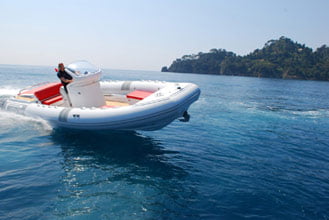
Oceanvolt Pirelli 880 we understand therefore that for motor boats, a motorization 100% electric will be particularly suitable for boats with heavy displacement or semi planing hulls such as small tenders, small fishing boats and for river navigation, or one day trips.
- More information on our page about the different solutions for electric or hybrid motors for passenger boats
- More information on our page about our solutions for electric motorization of motor boats
- More information on our page about solutions for electric motors for boat dinghies and zodiac.
Boats that require high power to be able to go fast and dejauger will be limited by the pack of batteries. For example, for an equivalent 100CV/70 kW. You’ll need 70 kWh of batteries for one hour of navigation at top speed which means high cost and weight. One of the possibilities to explore for these boats is definitely the foil which while sustaining the boat could considerably reduce the fuel consumption.
@ Envoyer une demande d’estimation de puissance
For a sailboat, the choice of an electric motor is different
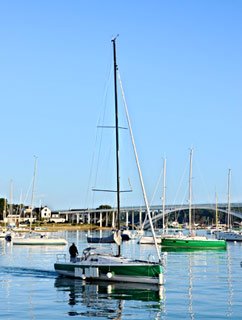
The sailboat is by definition a hybrid boat: motor + sail. Consequently the subject of self sufficiency is not the same, since we can often have photovoltaic production and consequent hydro generation. Several configurations are therefore possible depending on the program and the boat.
A choice with no commitment, 100% electric
It is possible to choose a configuration 100% electric that relies solely on its batteries and its energy production to navigate. This requires careful consideration If you do not want to limit yourself to one trip a day. Several conditions must be met :
- To begin with, you need to have a suitable boat , a boat quickly under sail (even with little wind) and fast when sailing in order to be able to hydro generate, which means produce electricity using the motor as a generator. OCEANVOLT SERVOPROP, for example, allows you to start producing energy from 5 knots and quickly reach 1 kW at 7 knots . The hydro generation is a key point in self sufficiency. By alternating the periods of sailing and navigating with the motor, the self sufficiency is unlimited. With this kind of boat, 5 hours of sailing can easily cover the consumption of one hour with a motor. For a light and fast catamaran, you can even go one hour of sailing for one hour of motor !
- Calculate your precise consumption onboard (excluding the engine) and little or no use of large consumers (induction plates, coffee maker, electric winches etc) when you do not want to come back to the port regularly.
- Installing as many solar panels as possible , even if they can not cover the consumption of the motor, at least they will cover on board consumption.
- Having a compatible program by getting rid as much as possible of the timing obligations and choosing the right weather slots and its route in order to be able to sail and thus hydro generate. Contrary to what you might think, a long trip program where you can take your time is much better than a summer cruise in the Mediterranean with imposed departure and arrival times.
A light and fast catamaran on which you can install a lot of solar panels (flexible or rigid) which has two motors for twice the hydro generation is the ideal boat. A fast SALONA 46 monohull with 2 OCEANVOLT SERVOPROP engines will also be suitable. Not taking into consideration that the use of the engine at mooring place to charge the batteries through a generator is a non-efficient task and is also not good for the engine.
- See the testimony of Graham Balch, owner of the first electric Salona 46
@ Any question ? Contact us
The electric boat with “range extender”
If you want more peace of mind, you can easily install a small AC generator of 4 or 5 kWs which is very light (70 kgs) to recharge the batteries with the charger at the port during a long period without wind. The generator will also allow you to return to the port at a low speed, if the batteries are completely empty. The speed will be limited in this case by the power of the charger and the generator.
The hybrid boat with DC generator in 48 V
In this case, the power of the generator is chosen to guarantee you the cruising speed wanted even when the batteries are empty. The generator will supply directly the motors with 48V, the excess energy will recharge the batteries. It is a very flexible solution that offers you the possibility of sailing only on electric, with the generator or with both depending on the conditions. Experience shows that fuel consumption is reduced by 80%. It also offers the possibility to have all the modern comfort on board (heater, induction plate, ice maker, diving unit etc) without making the traditional diesel engine run for hours a day. Not to mention that using the motor at the dock to recharge the batteries through the alternator has a very low efficiency and is very bad for the motor… and for the neighbors, which will not be the case with a generator set.
- See our solution of hybrid motorization for a 40 to 50 feet, less than 18 tons catamaran
The hybrid boat in parallel
In this configuration, the electric motor and the diesel engine are connected to a common transmission. A clutch system allows you to choose between the diesel engine, the electric motor or both at the same time. The solution seems attractive on paper, but it only works on big boats. The price and the weight of the clutch system are not suitable for pleasure boats yet.
The 50/50 for boats with 2 engines.
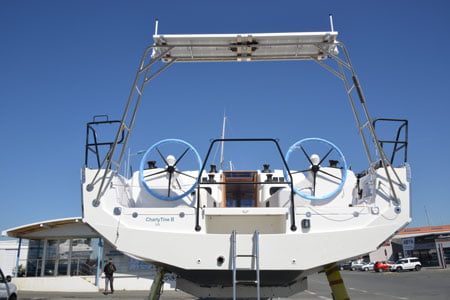
With a 2 engine boat such as a catamaran, some choose to keep a diesel engine for long cruising distances, and an electric motor to enter and go out of the port as well as for coastal traffic. An integral type charging system allows you to use the diesel engine’s available, non-used torque to charge the battery pack. The system works very well even if it needs a certain ability for port maneuvering with two engines that do not react the same way. Keep also in mind that you should increase the power of the internal combustion engine in order to move the boat forward with one motor, while recharging the batteries.
In summary , taking into account the average use of pleasure boats, electric or hybrid motors already cover a large part of their needs, but with solutions that are completely suitable to the programs of each one of them.
The electric motor for boats is not a new technology. The first car to exceed 100 KMH is an electric car, the « Jamais contente ». Many means of transportation (boats, trains etc) operate with an electric motor and a generator set which has a superior efficiency than that of the conventional internal combustion engine.
What has changed is the capacity to store the energy by increasingly efficient batteries and the possibility of producing your own green energy: wind, photovoltaic, hydro generation.
Development projects are under construction for batteries or fuel cells which will help accelerate the transition.

How to Properly Install an Electric Motor on Your Boat

Installing an electric motor on your boat can be a great way to reduce your environmental impact while still enjoying the benefits of boating. However, it’s important to ensure that the motor is installed correctly to avoid any safety hazards or performance issues. In this blog post, we’ll provide a step-by-step guide on how to properly install an electric motor on your boat.
Step 1: Choose the Right Motor
Before you begin the installation process, it’s important to choose the right electric motor for your boat. Consider factors such as the size of your boat, the weight of the motor, and the power output of the motor. Be sure to choose a motor that is appropriate for your boat’s specifications to ensure optimal performance.
Step 2: Prepare the Boat
The next step is to prepare your boat for the motor installation. This may involve removing any existing motor or equipment that will no longer be needed. You may also need to drill new holes for the motor and make any necessary adjustments to the boat’s structure to accommodate the new motor.
Step 3: Install the Motor
Once your boat is prepared, you can begin the installation process. Start by mounting the motor to the boat using the appropriate brackets and hardware. Ensure that the motor is securely attached and that there is no movement or wobbling.
Step 4: Install the batteries
The batteries needed to power the engine must then be installed. Make sure to connect the batteries in the proper sequence and adhere to the manufacturer’s instructions for proper battery installation.
Step 5: Connect the wiring
It’s time to connect the wiring after the motor and batteries have been fitted. This may entail connecting the batteries to the engine as well as any additional electrical devices, such as a controller or charger. To guarantee proper wiring connections, be sure to carefully follow the manufacturer’s instructions.
Step 6: Engine inspection
After installing everything, the engine should be tested. Start the engine and listen for unusual vibrations or noise. Make sure the engine is running efficiently and the electrical system is in good condition.
Step 7: Secure loose ends
Be sure to tie up any loose ends after testing the motor. This includes properly securing all cables, removing debris, and repositioning the motor or battery as needed.
In summary, the correct installation of an electric motor in your boat is an important process that must be performed with care and attention to detail. These procedures will help you install your engine properly and ensure that it operates reliably, effectively and safely.
© 2023 ACEL Power Inc. All rights reserved.
Your survey responses are collected by Acel Power Electronics for analysis, to better serve you. You may refer to the Privacy Notice for more details.
Please proceed only if you accept the terms stated in the Privacy Notice.
Error: This is required.
If so, what specific factor had the biggest impact on your score?
Not listed above (please specify)
please specify
Considering the score and answers you provided earlier, please specify the reason for your score and how we could improve your experience.

Home » Blog » Gear » Buyers guide to electric boat motors (2023)
Buyers guide to electric boat motors (2023)
By Author Fiona McGlynn
Posted on Last updated: August 3, 2023
Considering making the switch to an electric boat motor? With electric vehicles now commonplace on the roads, it’s no wonder so many boaters are curious about electric boats.
While electric boat motors have been around for a while, in the last several years the technology has taken huge leaps, resulting in more powerful motors, longer-lasting batteries, and ultimately more options for recreational boat owners.
Today, many types of boats can be outfitted with an electric propulsion system including pontoon boats, sailboats, jon boats, powerboats, fishing boats, yachts, and trawlers . If your boat’s combustion engine is in the range of 1 to 135 hp (.75 to 100 kW), you should be able to find an electric substitute.
While electric boating hasn’t gone mainstream—it’s estimated that close to 2% of recreational boats are electric—it’s still a great time to be thinking about making the switch, particularly if you own a tender, sailboat, or boat on a green lake where combustion engines are prohibited.
Table of contents
- 1.1 Benefits
- 1.2 Drawbacks
- 2.1.1 Key features of electric outboard boat motors
- 2.1.2 Electric outboard manufacturers
- 2.2.1 DIY electric inboard boat motor conversion
- 2.2.2 Key features of electric inboard boat motors
- 2.2.3 Electric inboard manufacturers
- 2.3.1 Serial vs. parallel hybrids
- 2.3.2 Key features of marine hybrids
- 2.3.3 Marine hybrid manufacturers
- 2.4.1 Electric pod and sail drive manufacturers
- 3 Batteries
- 4 Ready to catch the electric boating wave?
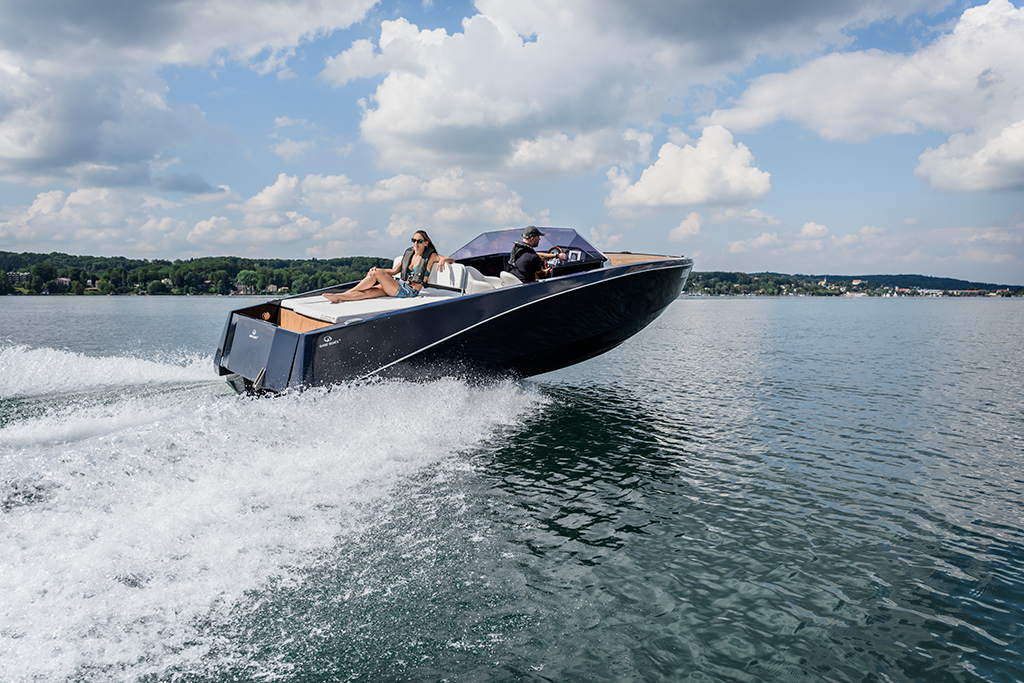
Benefits and drawbacks of electric boat motors
Electric marine motors offer several advantages over internal combustion engines:
- They’re completely silent .
- No noxious fumes or smelly exhaust gases to deal with.
- Instant torque. Electric propulsion provides instant torque, giving you better maneuverability and more consistent speeds in choppy conditions.
- Lightweight. An electric setup (including motor, batteries, and generator) typically weighs less than its diesel counterpart.
- No fuel cost. Charging an electric boat may cost a couple of dollars per charge.
- Easy to maintain. Imagine the maintenance on an outboard with no gas, spark plugs, or oil! Electric motors are simple, more reliable, and virtually maintenance-free.
- Renewable power. Once you’ve gone electric you can get power from renewable sources like wind generators and solar panels.
- Better for the planet. Electric marine motors don’t produce water pollution or produce harmful emissions like carbon dioxide (CO2), nitrogen oxides (NOx), and hydrocarbon (HC).
- Range. The greatest drawback of electric boats is their limited range, which is often measured in the 10s of miles. Range is limited because batteries don’t have the same energy density as fuel — they can’t provide the same energy, pound-for-pound as a tank of gas. A good battery monitoring system, one that displays the remaining range in real-time, can help boaters manage energy consumption and ease range anxiety. For those who want to go farther afield, hybrid propulsion may be a better option.
- Upfront cost. This new technology isn’t cheap. For example, a small electric outboard boat motor may sell for two-and-a-half times the cost of a gas outboard. However, prices are expected to come down as the industry reaches scale.
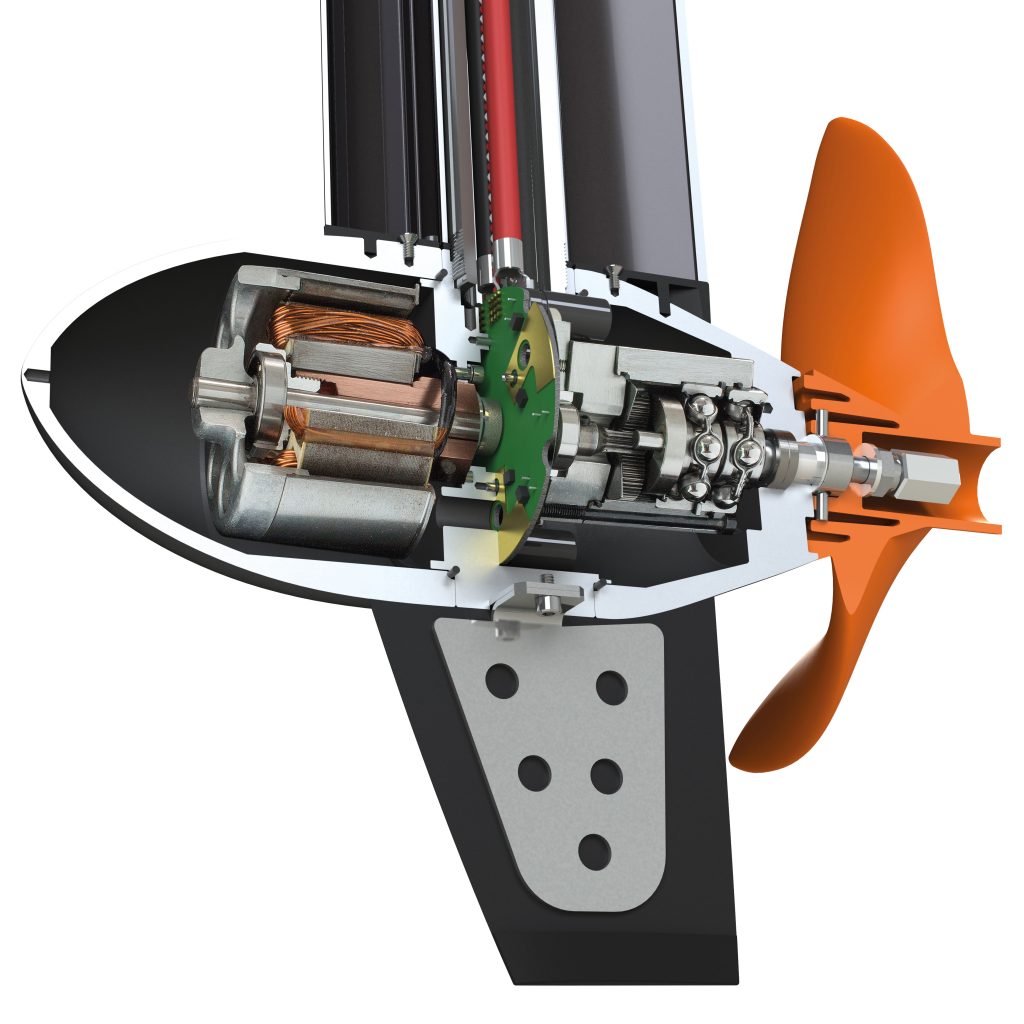
Types of electric boat motors
Electric outboard boat motors.
Some of the first electric outboards to hit the recreational boating market were smaller electric motors, typically used as trolling motors on fishing boats.
Today, it’s possible to buy far more powerful electric outboard motors in the 1 to 80 hp (.75 to 60 kW) range , with ever more powerful versions hitting the market each year. In 2022, Norwegian start-up, Evoy launched the world’s most powerful outboard to date, the 225kW Storm, a 300-hp beast of an electric outboard!
The range on electric outboard boat motors varies dramatically depending on your boat, total weight, propellor, and battery capacity .
The range also depends on how fast you want to travel. If you go slowly you’ll have a much greater range.
For instance, at a slow speed (5 knots) Torqeedo’s Deep Blue 50R , a 50 kW motor (80 hp equivalent) with a 40 kWh battery, has a listed range of 33-100 nm. But at full throttle (20-25 knots), the listed range drops to 16-20 nm.
To get a better sense of what range to expect on your boat (at both low and high speeds), you can look at the manufacturer’s website. See our list of electric outboard brands below.
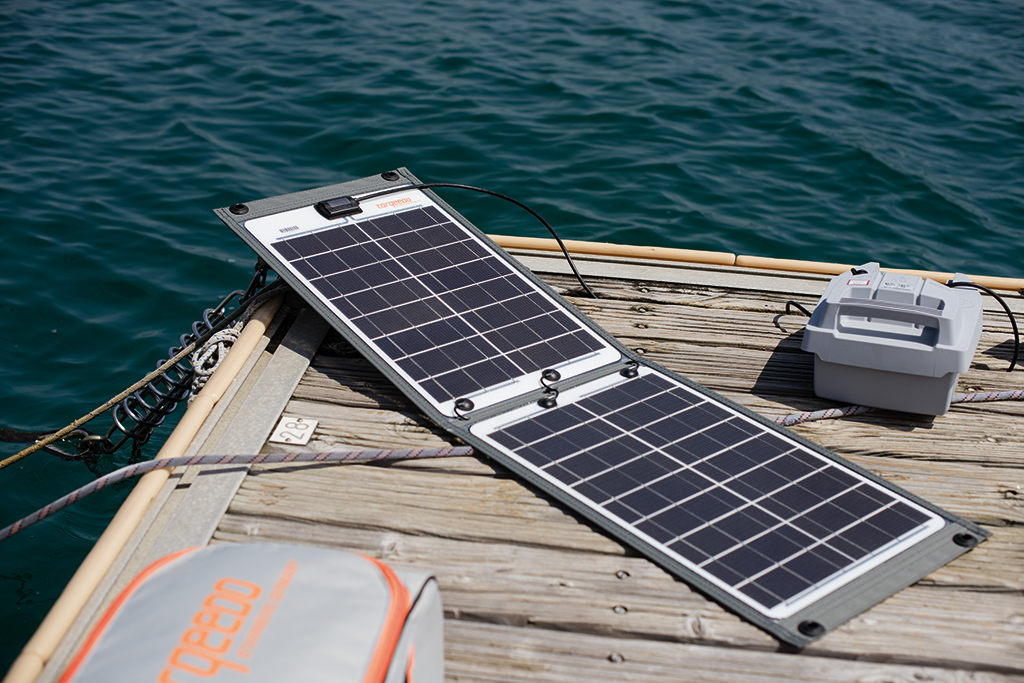
One of the great things about electric outboards is that they can use renewable power sources. So, for instance, you could plug your boat into a portable solar panel while picnicking and get an extra boost for the trip home.
Some electric outboard boat motors can even generate power! Motors with hydro regeneration capabilities can charge the batteries while the boat is being towed or under sail.
While hydro regeneration is a fairly new feature for electric outboards, some manufacturers, like EPropulsion, are offering it across their outboard product line.
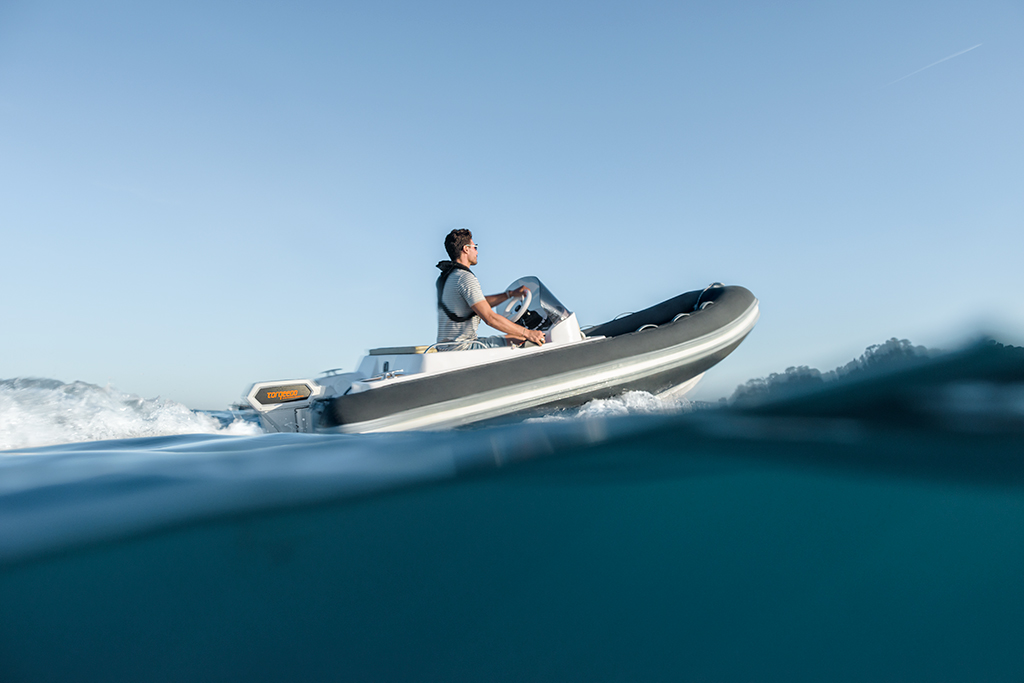
Key features of electric outboard boat motors
Each electric outboard motor brand has slightly different standard offerings and add-on features. Here are some of the key features and options to look for.
- Waterproof. Some electric outboards are fully sealed and designed to withstand immersion
- Remote controls. Choose between tiller and remote throttle controls
- On-board computers . Some electric outboards come with chartplotter connectivity, navigation functions, sonar, GPS anchoring, and autopilot features
- Built-in or stand-alone batteries. Some of the smaller motors come with built-in batteries, while the larger ones have separate battery packs
- Battery monitoring and tracking systems that calculate and display the remaining range in real-time
- Shaft length. Electric outboards come in both short and long shaft lengths to accommodate a variety of applications.
- Hydro regeneration capabilities
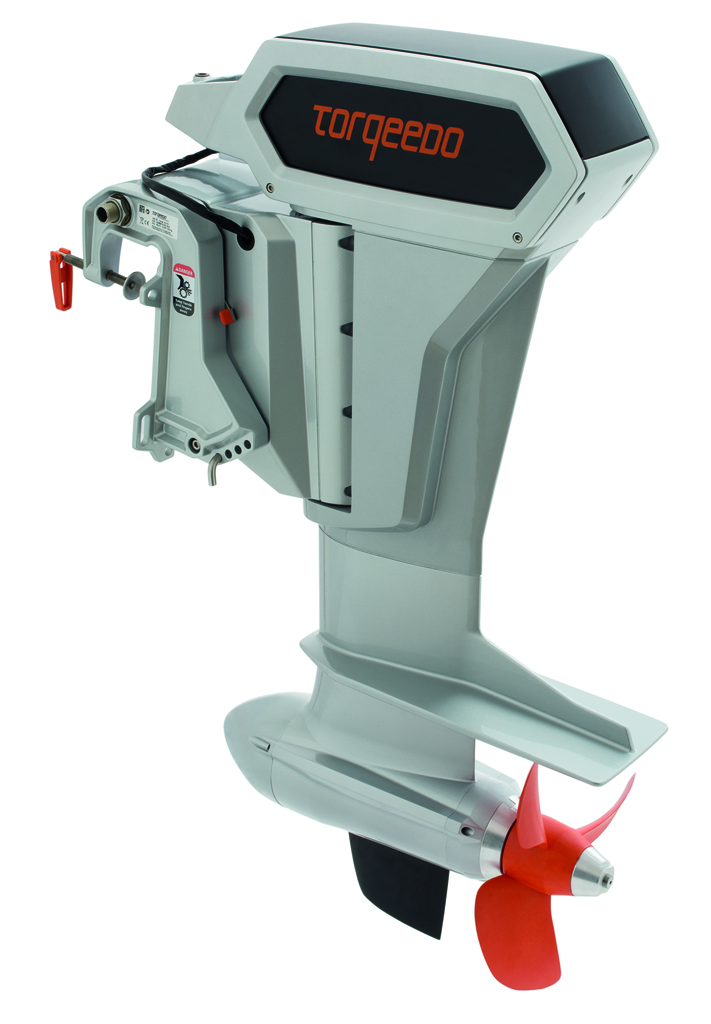
Electric outboard manufacturers
These electric outboard boat motor manufacturers (listed in alphabetical order) range from small startups to large companies and serve the North American market.
If you’re looking to learn more about what each of these companies offers (and how they compare) I’d highly recommend checking out the Plugboats’ electric outboard guides and directories . Jeff Butler, the editor at Plugboats has done a great job of compiling motor specifications from across the market.
Headquartered in San Diego, California, Bixby makes a small electric motor system for kayaks, inflatable boats, canoes, and paddleboards.
Elco has been building electric motors for 125 years and counts the likes of Henry Ford and Thomas Edison among their customers. Their award-winning electric marine motors range from 5 to 50 hp. The company is based in Lake George, New York, and its electric motors can be found on boats around the world.
Flux Marine
Flux Marine was founded by mechanical engineering Princeton grads and offers three outboard models—a 40 hp, 70 hp, and 100 hp. In 2021, they won an award for the best new green product at the Newport International Boat Show.
Joe Grez, a consumer product developer from Washington, invented the EP Carry , a compact, ultralight electric outboard system because he was concerned about exposing his young daughter to the carbon monoxide (CO) emissions produced by gas outboards.
The EP Carry retails for $1,600 and is a great size for small vessels like dinghies, canoes, inflatable boats, and kayaks.
ePropulsion
ePropulsion , based in Guangdong, China, manufactures 3 to 9.9-hp electric motors for sailboats, fishing boats, as well as dinghies and tenders. They all come with hydro regeneration capabilities.
Mercury Marine launched the Avator 7.5 electric outboard (3.5 hp equivalent) in early 2023. The leading outboard manufacturer is currently developing more powerful 20e and 35e models which it plans to release later this year.
In 2023, Newport , a well-known US-based inflatable boat manufacturer, launched three small outboards ranging from 1.8 to 3 hp.
If you’re into fishing, you’re probably familiar with the Minn Kota name, derived from MINNesota North DaKOTA, prime fishing country where the company has its roots. They introduced their first electric trolling motor back in 1934 and they’ve been making them ever since.
Pure Watercraft
Pure Watercraft was founded by CEO Andy Rebele in Seattle in 2011. Their 25 kW (50 hp) motor starts at $16,500.
Ray Electric Outboards
Ray Electric Outboards is a 3rd generation family-owned business based in Cape Coral, Fl. They manufacture one outboard model that can be operated at different power ratings ranging from 10 to 22 hp.
Stealth Electric Outboards
The 50 and 75-hp Stealth electric outboards were developed by Scott Masterston of Houston, Texas.
German manufacturer, Torqeedo , has been leading the propulsion industry for years and sells some of the best e outboard motors in the 1 to 80-hp range
Vision Marine Technologies (formerly The Canadian Electric Boat Company).
Based in Quebec, Canada, Vision Marine Technologies has been in the boating industry for 25 years and produced some very innovative electric boats. In 2021, they launched E-Motion 180E, one of the most powerful electric outboards on the market.
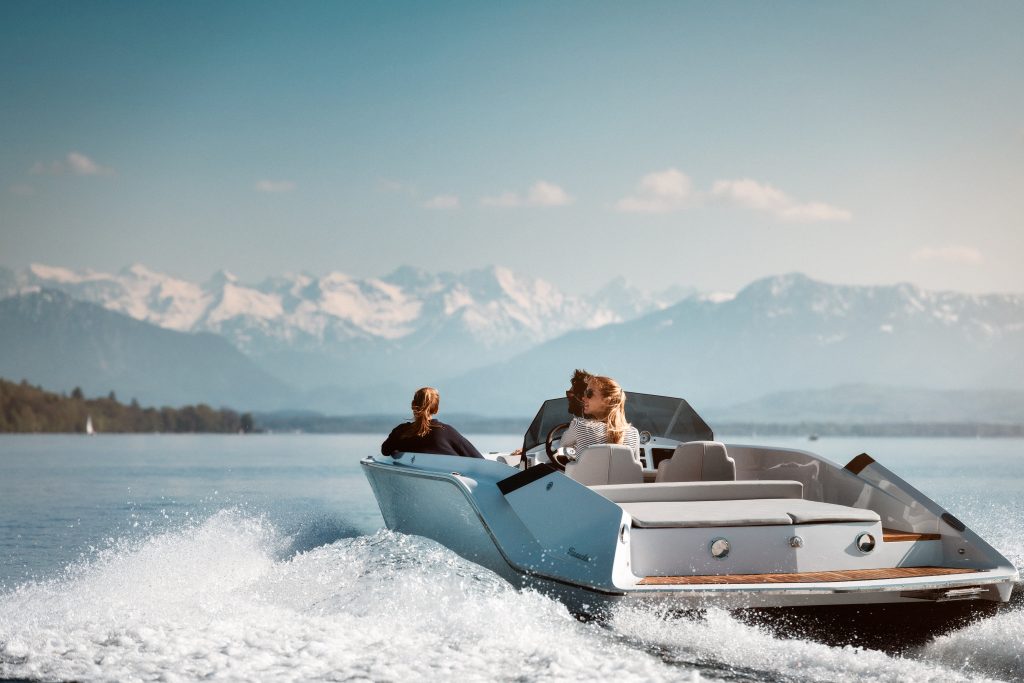
Electric inboard boat motors
Today’s electric inboard motors can provide anywhere from 3- to a whopping 330 hp (2 to 246 kW) and are used in a range of applications from heavy displacement vessels to fast, planing powerboats.
Similar to outboards, the range on electric inboard engines will vary based on your boat, load, battery capacity, and boat speed (among other things).
However, with an inboard electric boat motor, you have the option of a hybrid motor which can significantly extend your range. We’ll discuss the pros and cons of hybrid boat motors later in this post.
Sailors may also want to consider choosing an inboard electric motor with hydro regeneration capabilities. These electric power motors can charge the battery while the boat is under sail.
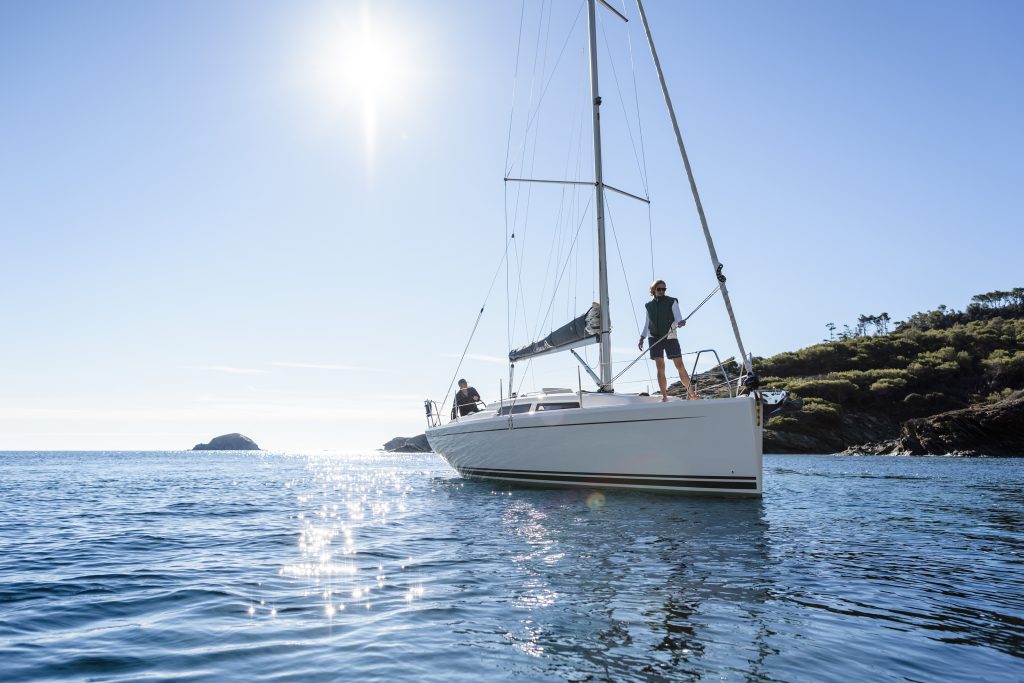
DIY electric inboard boat motor conversion
One way to save money on an electric inboard is to do the installation yourself. There are a few DIY electric inboard boat motor conversion kits available on the market.
I’ve spoken with a few sailors who’ve had great success replacing their inboard diesel engines with these electric boat motor conversion kits from Thunderstruck-EV , an electric drive manufacturer in Santa Rosa, California.
Key features of electric inboard boat motors
Each brand has a slightly different set of electric inboard motor options. Here are some of the key features and options to look for.
- DIY conversion kits
- On-board computers and touchscreen display
- Waterproof system components
Electric inboard manufacturers
US manufacturer, Elco Motor Yachts , has been building electric motors for over 125 years, having gotten their start in 1893, supplying electric boats for the Chicago World’s Fair. They have seven inboards ranging from 6 to 200 hp.
Electric Yacht
Electric Yacht is a US supplier focused on providing plug-and-play electric motors for DIY installations on sailboats. Their electric propulsion systems range from 10 to 30. They’ve had over 450 installs in 10 years of production.
Oceanvolt is a leader in regenerative systems and their electric inboard motors are popular among sailors. They offer shaft drive systems ranging from 6 to 60 hp.
Torqeedo, a German manufacturer, is the world’s leader in electric boat motors. They have two lines of inboards, one for displacement boats and another for fast planing boats. Their Deep Blue inboard systems range from 25 kW to 100 kW (40 to 135 hp)
Hybrid systems
Hybrid systems combine an electric motor and combustion engine, so you can cruise in silence (but know you’ve got enough gas to get home). These systems offer many of the benefits of pure electric motors, without the limited range.
If you want additional power for onboard luxuries like air-conditioning, hybrids can also provide a significant increase in house-side fuel efficiency.
The downside to any hybrid solution is that the systems are far more complex . Not only do they require more equipment, but, for an optimized system, you’ll need highly sophisticated software to manage multiple power sources and switch back and forth between diesel and electric.
Unsurprisingly, the increased complexity adds cost, making hybrids less economical than either a conventional or pure electric install.
Serial vs. parallel hybrids
As with cars, there are two types of hybrid systems: serial and parallel. A serial hybrid uses a generator to power a large electric motor connected to the drive shaft. Whereas, a parallel hybrid has both a conventional combustion engine and a small electric motor connected to the drive shaft.
There are plenty of factors to consider when choosing between a parallel and serial system. Marine mechanics and electrical expert, Nigel Calder, does a great job of explaining serial and parallel hybrids in detail.
In general, serial systems may be a better fit for boats that can get most of their propulsion energy from renewable sources (e.g., a sailing catamaran). Whereas, a parallel system makes more sense on boats that regularly require sustained propulsion (e.g., Greenline’s power yachts ).
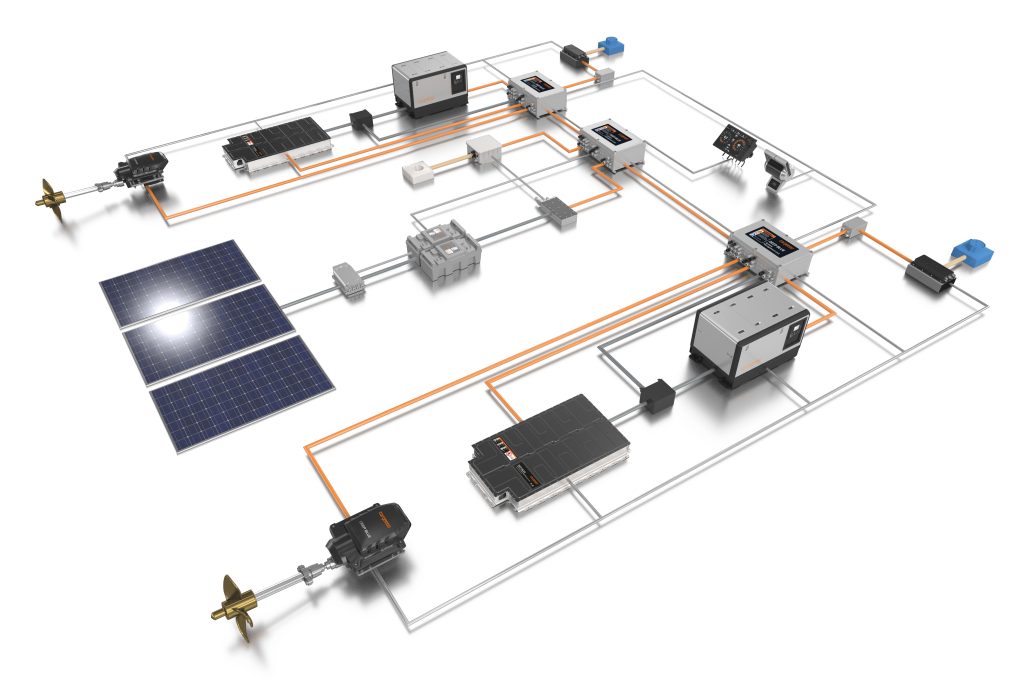
Key features of marine hybrids
- Parallel and serial hybrid options
- Integrated energy management systems
Marine hybrid manufacturers
Elco motor yachts.
Elco manufactures serial, parallel, as well as a combined serial-parallel system. Their systems can be used on sailboats, trawlers, yachts, and boats up to 85′ feet.
Hybrid Marine Ltd.
Hybrid Marine sells parallel hybrid systems in the 10 to 230 hp range. Beta, John Deere, and Yanmar’s hybrids all incorporate Hybrid Marine technology.
Finnish manufacturer, Oceanvolt , offers serial hybrid systems for both sailboats and powerboats.
Torqeedo makes hybrid systems for yachts up to 120 feet as well as powerful motorboats.
Electric pod drive and sail drive
Several manufacturers are now making electric pod and sail drives. These electric drive systems are more efficient and can save space onboard.
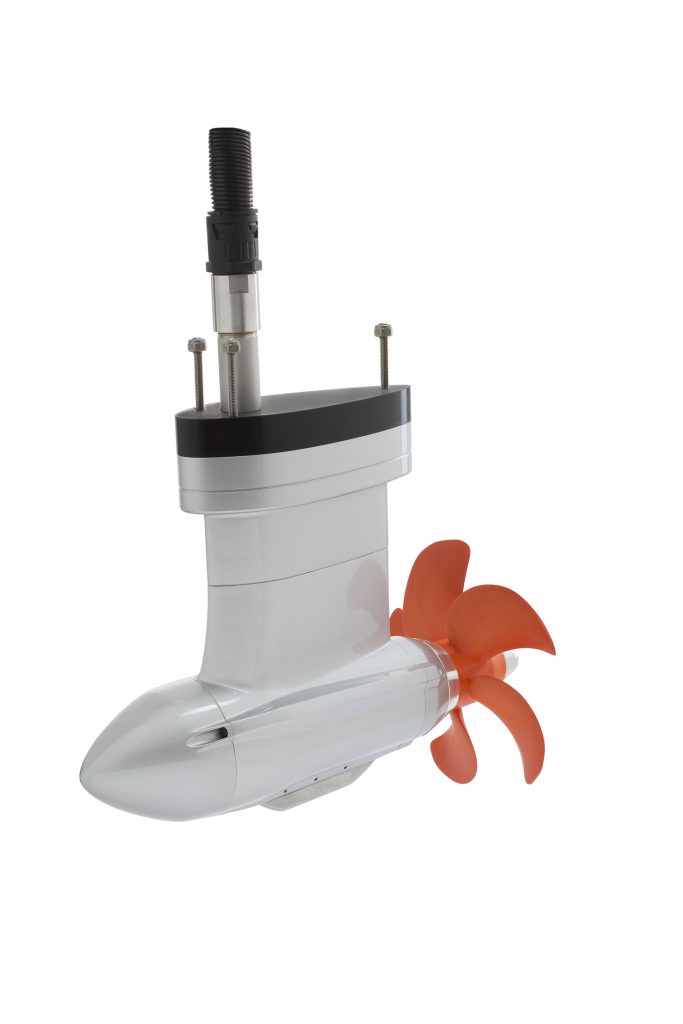
Electric pod and sail drive manufacturers
Electric Yacht produces a range of sail drives that can replace diesel engines up to 75 hp.
propulsion sells a 3 hp, 6 hp, and 9.9 hp fixed pod drive.
Oceanvolt’s sail drives range from 6 kW to 15 kW (8 to 20 hp)
Torqeedo sells a 40 hp and 80 hp equivalent electric sail drive as well as electric pod drives in the 6 to 25 hp range.
While it’s possible to power an electric motor with a conventional lead-acid battery, there are many good reasons to upgrade to lithium-ion batteries.
Their increased usable capacity is roughly double what you can get out similarly sized lead-acid battery. More battery capacity means more range—and hours of fun—on your electric boat.
They also charge more quickly and have a longer life span than lead-acid batteries. Unlike flooded lead-acid batteries, which need to be watered, lithium-ion batteries are practically maintenance-free.
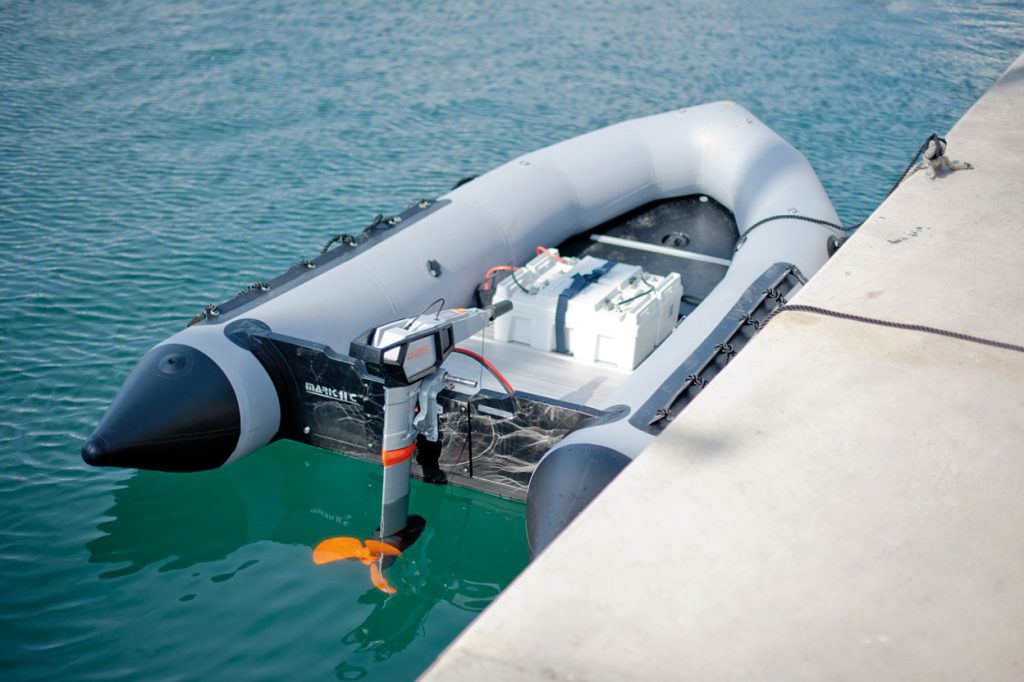
The downside is that lithium-ion batteries are far more temperature-sensitive and can’t be charged much above 113 F (45 C) or below 32 F (0 C).
They can also present major safety issues . Lithium-ion batteries can go into what’s known as thermal runaway—a self-heating process that can cause the battery to catch fire.
Simply put, lithium-ion batteries are NOT a drop-in substitute for lead-acid batteries. They need to be specially designed for the marine environment and paired with a robust battery management system.
Electric motor manufacturers often provide complete solutions (including motor, batteries, and battery management system). It’s a good idea to work with a manufacturer with extensive marine experience and an ABYC-certified technician on any installation.
The other catch is that lithium-ion batteries cost two to four times as much as lead-acid batteries. However, the increased capacity and longer life span may make lithium batteries a better value option over the long run.
Ready to catch the electric boating wave?
With ever more powerful and feature-packed electric options launching each year, it’s an exciting time to be in the market for a new motor or engine. If you have any doubts about whether an electric boat motor is right for you, head to your local boat show and see, first hand, what all the buzz is about.
Fiona McGlynn is an award-winning boating writer who created Waterborne as a place to learn about living aboard and traveling the world by sailboat. She has written for boating magazines including BoatUS, SAIL, Cruising World, and Good Old Boat. She’s also a contributing editor at Good Old Boat and BoatUS Magazine. In 2017, Fiona and her husband completed a 3-year, 13,000-mile voyage from Vancouver to Mexico to Australia on their 35-foot sailboat.
Douglas McQuilken
Sunday 30th of January 2022
Great article!
For those who wish to collaborate with prospective & current electric boaters, highly recommend this forum - https://groups.io/g/electricboats
Thanks for the suggestion, Douglas!
Terms and Conditions - Privacy Policy
An official website of the United States government Here's how you know
Official websites use .gov A .gov website belongs to an official government organization in the United States.
Secure .gov websites use HTTPS A lock ( Lock A locked padlock ) or https:// means you’ve safely connected to the .gov website. Share sensitive information only on official, secure websites.
INVESTING IN AMERICA: Number of Publicly Available Electric Vehicle Chargers Has Doubled Since Start of Biden-Harris Administration
Now, Biden-Harris Administration Awarding $521 Million in Grants to Continue Building Out National Electric Vehicle Charging Network
WASHINGTON D.C. – The Biden-Harris Administration today announced $521 million in grants to continue building out electric vehicle (EV) charging and alternative-fueling infrastructure across 29 states, eight Federally Recognized Tribes, and the District of Columbia, including the deployment of more than 9,200 EV charging ports.
This new EV infrastructure will increase access and reliability to communities across the country and provides EV charging to light-, medium- and heavy-duty vehicles along designated highways, interstates, and major roadways. The funds are a part of the Biden-Harris Administration’s goals to support the growth of a convenient, affordable, reliable and Made-in-America national network of EV chargers so drivers can charge close to home, at work, and along significant corridors throughout the U.S.
Since the start of the Biden-Harris Administration, the number of publicly available EV chargers has doubled. Now, there are over 192,000 publicly available charging ports with approximately 1,000 new public chargers being added each week. This progress is a testament to the Bipartisan Infrastructure Law and the catalyzing effect it has had on private investments for EV charging infrastructure. Through programs like the Charging and Fueling Infrastructure (CFI) Discretionary Grant Program and the National Electric Vehicle Infrastructure (NEVI) Formula Program, the Administration is playing a critical role alongside private industry, to actively expand America’s EV charging network while creating good-paying, union jobs.
Charging infrastructure is being built in rural, suburban, urban, and Tribal communities alike, supplementing private investment and filling critical gaps where charging is needed most. Additionally, this buildout aligns with the National Zero-Emission Freight Corridor Strategy investing in EV charging for trucks along one of the nation's largest freight corridors in America. These investments promote EV adoption, emission reductions, economic development and healthy communities.
"The Biden-Harris Administration has taken action to ensure that America leads the EV revolution, and the historic infrastructure package includes resources to support a nationwide EV charger network so that all drivers have an accessible, reliable, and convenient way to charge their vehicles,” said U.S. Transportation Secretary Pete Buttigieg. “The awards that we’re announcing today will build on this important work and help ensure that the cost savings, health and climate benefits, and jobs of the EV future are secured for Americans across the country.”
"As we build out the EV charging network on our highways, we are also investing in local communities, rural, urban and tribal alike. Today’s grants are a critical part of ensuring every American can find a charger as easily as a gas station, which will decrease pollution from our roadways, lower costs for families, and help people get to where they need to go efficiently,” said U.S. Transportation Deputy Secretary Polly Trottenberg.
“President Biden and Vice President Harris believe in building infrastructure from the bottom up and the middle out. This investment puts public dollars in the hands of states, tribes and communities to build a more accessible national charging network,” said U.S. Secretary of Energy Secretary Jennifer Granholm. "It will deliver good paying local jobs while giving Americans more transportation options no matter their geography or income and allow those looking for a new vehicle to more confidently take advantage of tax credits to purchase new and used EVs.”
“Building new charging infrastructure is already creating good-paying union jobs and modernizing transportation in a way that cleans up the air our kids breathe,” said White House National Climate Advisor Ali Zaidi. “Under President Biden and Vice President Harris’s leadership, we are accelerating private investment to do just that and, at the same time, increasing our capacity to manufacture these technologies in the United States. Today’s announcement helps us move faster to win the future — good jobs, clean air, and a robust manufacturing economy that supports a growing middle class.”
The grants announced today are made possible through the Bipartisan Infrastructure Law’s $2.5-billion Charging and Fueling Infrastructure (CFI) Discretionary Grant Program and a 10 percent set-aside from the National Electric Vehicle Infrastructure (NEVI) Formula Program . Together, these programs have spurred private investments in growing the nation’s EV charging network and are actively deploying chargers across the country and ensuring more drivers can charge their EVs where they live, work, and shop, while also supporting longer trips. These historic investments are going to accelerate the country’s transition to a clean energy economy while reducing pollution and harmful greenhouse gas emissions.
$321 million of today’s investment will be allocated for 41 “community” projects that expand EV charging infrastructure within communities across the country, while $200 million will go towards 10 “corridor” fast-charging projects that build out the national charging and alternative-fueling network along designated Alternative Fuel Corridors.
The awards also support the President’s Justice40 Initiative, which aims for 40% of the overall benefits of federal investments to flow to disadvantaged communities, with over half of the funding going to sites located in disadvantaged communities. Investing in these communities creates jobs, reduces transportation costs, and helps mitigate healthcare costs caused by air pollution, while also ensuring all equitable access to EV charging infrastructure.
“As we reach this important milestone in building out the national EV charging network, FHWA remains steadfast in our continued work supporting the deployment of hundreds of thousands of EV chargers over the next several years,” said Federal Highway Administrator Shailen Bhatt. “The EV charging and alternative fueling projects receiving awards today will deliver clean transportation in communities nationwide and put America on a path to lead the world in zero-emission transportation technology while creating good-paying jobs and reducing our carbon footprint.”
“Most EV charging will happen at homes, workplaces, or other destinations while vehicles are already parked, providing a safe, reliable, and vastly more convenient way for anyone to fuel,” said Gabe Klein, Executive Director of the Joint Office of Energy and Transportation. “Today’s investments in public community charging fill crucial gaps and provide the foundation for a zero-emission future where everyone can choose to ride or drive electric for greater individual convenience and reduced fueling costs, as well as cleaner air and lower healthcare costs for all Americans.”
Community project selections in this round of grants include:
The City of Milwaukee will receive nearly $15 million to install EV chargers at 53 sites citywide. During the site selection process, the city prioritized sites in areas that lack existing EV infrastructure, low-to-moderate income communities, and neighborhoods with high ratios of multifamily housing units. This project will support the city’s climate and equity goals by expanding the network in areas that currently lack public infrastructure, or lack the ability to charge at home, making residents more comfortable with switching to an EV, and increasing rates of EV adoption.
The Standing Rock Renewable Energy Power Authority, on behalf of the Sioux Reservation in North Dakota, will receive nearly $3.9 million to install publicly accessible community EV charging stations in eight locations. The sites were selected because they are spread throughout the Reservation’s eight districts, and because they serve as gathering spots where Tribal members can access services.
Corridor project selections in this round of grants include:
The Fort Independence Indian Community in California will receive over $15 million to install a reliable, resilient, and sustainable EV charging hub along U.S. Route 395 corridor, a designated Alternative Fuel Corridor, and the only north-south passage along the Eastern Sierra Nevada range. This project will contribute to emissions reductions by encouraging the use of EVs and powering the charging hub through a solar micro-grid with combined heat and power generation and battery backup.
The City of Atlanta will receive nearly $11.8 million to install a DC Fast Charging Hub at the Hartsfield-Jackson Atlanta airport with 50 DC fast chargers. The DC Fast Charger Hub would provide critical charging for rental car companies, ride-share drivers, airport shuttles for hotels, employees, the City's growing electric fleet of light- to heavy-duty vehicles, as well as regional and local EV drivers coming to the airport or driving along the nearby major highway systems. The project aims to improve asthma-related issues in predominantly Black and underserved neighborhoods and would engage underserved communities to ensure widespread adoption of EVs.
A full list of grant recipients can be found here .
On May 30, 2024, FHWA published a Notice of Funding Opportunity (NOFO) for applications for the second round of funding through the CFI Program. The NOFO announced FHWA’s intent to make additional awards for applications submitted under the Fiscal Year 2022 and 2023 CFI Round 1 NOFO issued on March 14, 2023, that were not previously selected. The CFI Round 2 application period will close on September 11, 2024.
In response to the NOFO, FHWA received requests for consideration from 277 applicants requesting a combined $2.1 billion in funding, nearly double the amount of funding available. This round of funding expands the total number of states with an awarded CFI project to 38, in addition to the District of Columbia and Puerto Rico, with 14 states and the District of Columbia receiving their first CFI award.
FHWA is working closely with the Joint Office of Energy and Transportation, providing technical assistance on planning and implementation of a national network of EV chargers and zero-emission fueling infrastructure. Information on technical assistance from the Joint Office is available at driveelectric.gov .
For more information on President Biden’s Bipartisan Infrastructure Law and investments in electric vehicles, visit FHWA’s BIL website .
DMV Introduces Chinese Language Option for No-Fail eLearning Driver’s License Renewal Course
Contact: Office of Public Affairs 2415 First Avenue Sacramento, CA 95818 (916) 657–6437 | [email protected]
FOR IMMEDIATE RELEASE August 29, 2024
New Option Expands Accessibility to Mandarin-Speaking Californians
Sacramento – The California Department of Motor Vehicles (DMV) today announced the expansion of its no-fail eLearning driver’s license renewal course, now available in Traditional Chinese with audio in Mandarin. This new language option offers Mandarin-speaking Californians the opportunity to renew their driver’s license with greater ease and convenience.
The eLearning course, previously available in English and Spanish, can be accessed 24/7 on any internet-enabled device, including computers, laptops, tablets, and mobile devices. The course consists of seven interactive modules, each followed by a quiz, all of which can be retaken multiple times, ensuring a no-fail experience.
“Expanding our services to include a Chinese language option is part of our ongoing commitment to serve all Californians,” said DMV Director Steve Gordon. “We are dedicated to providing flexible and accessible options for DMV services, allowing our customers to complete their transactions when, where, and how it is most convenient for them.”
Since its introduction in 2022, the eLearning renewal course has become a popular choice among Californians, with nearly 50,000 participants completing the course each month. The course takes approximately 45 minutes to complete and is designed to accommodate individuals who may prefer a non-traditional learning method or who may have difficulty with standard exams. Upon completion, some customers may need to visit a DMV office to finalize their renewal by taking a photo, providing a thumbprint and undergoing a vision screening.
In addition to the eLearning course, the DMV continues to offer its online knowledge test in 35 languages. The online test can be taken on a computer or laptop with a webcam and is available Monday through Friday from 8 a.m. to 4 p.m., excluding state holidays. Participants are required to verify their identity and agree to monitoring throughout the exam as a measure to prevent fraud.
Before Going to an Office – Try Online First!
The DMV has taken many steps to offer more digital services. Most DMV tasks do not require an office visit, including simple self-service transactions that are no longer available in offices. The DMV encourages customers to use its online services and other service channels to complete transactions, including eligible driver’s license and vehicle registration renewals. Customers can also use the Service Advisor on the DMV website to learn their options to complete DMV tasks.
To sign up for paperless vehicle registration and driver’s license renewal notices, customers must sign in or create a secure online account at dmv.ca.gov , and then opt in.
Sign up to receive the latest DMV News Alerts: DMV NEWS ALERTS – California DMV
General Disclaimer
When interacting with the Department of Motor Vehicles (DMV) Virtual Assistant, please do not include any personal information.
When your chat is over, you can save the transcript. Use caution when using a public computer or device.
The DMV chatbot and live chat services use third-party vendors to provide machine translation. Machine translation is provided for purposes of information and convenience only. The DMV is unable to guarantee the accuracy of any translation provided by the third-party vendors and is therefore not liable for any inaccurate information or changes in the formatting of the content resulting from the use of the translation service.
The content currently in English is the official and accurate source for the program information and services DMV provides. Any discrepancies or differences created in the translation are not binding and have no legal effect for compliance or enforcement purposes. If any questions arise related to the information contained in the translated content, please refer to the English version.
Google™ Translate Disclaimer
The Department of Motor Vehicles (DMV) website uses Google™ Translate to provide automatic translation of its web pages. This translation application tool is provided for purposes of information and convenience only. Google™ Translate is a free third-party service, which is not controlled by the DMV. The DMV is unable to guarantee the accuracy of any translation provided by Google™ Translate and is therefore not liable for any inaccurate information or changes in the formatting of the pages resulting from the use of the translation application tool.
The web pages currently in English on the DMV website are the official and accurate source for the program information and services the DMV provides. Any discrepancies or differences created in the translation are not binding and have no legal effect for compliance or enforcement purposes. If any questions arise related to the information contained in the translated website, please refer to the English version.
The following pages provided on the DMV website cannot be translated using Google™ Translate:
- Publications
- Field Office Locations
- Online Applications
Please install the Google Toolbar
Google Translate is not support in your browser. To translate this page, please install the Google Toolbar (opens in new window) .

COMMENTS
Install an Electric Motor in a Sailboat. If you own an enginless sailboat, the electric sailboat motor conversion is much easier for you. All you need to do is to find a reliable electric sailboat motor and install it in simple steps. The whole process can be easily done, even for beginners. Here we take the popular 6 HP electric sailboat motor ...
I have installed an electric inboard in my Catalina 30 sailboat. This is a handy installation guide to help you with your own install, or to help satisfy you...
This channel is about how to design and install an electric motor in a sailboat. We're planning to show every step of the way, from the desicion to how we de...
Cheoy Lee Clipper on Lake Superior. Jan 2, 2023. Sailing with an Electric Motor In 2021 we installed the QuietTorque™ 10.0 Electric Motor by Electric Yacht on our 1972 Cheoy Lee Clipper Sailboat, which we use for day charters from May through October on Lake Superior. We have been extremely satisfied with the...
We are converting our 38' sailboat into a fully electric boat. We received our electric motor and are working to install it in the engine room. This has been...
Cost - Reason 1. The cost of going electric is comparable to that of fitting an ICE (internal combustion engine). The total cost was less than Au$8 000. This included the sailboat kit consisting of a: 10kW engine, electronics for the motor, gear reducer, display unit, speed control, 9.5kWH of usable battery storage.
Whether quietly maneuvering through a harbor or motor-sailing on low-wind days to create your own apparent wind, our electric solutions will enhance and extend your sailing enjoyment. Oceanvolt offers Hybrid or Electric systems as a power & propulsion option in partnership with many leading monohull boat builders - adding new partners continuously.
Step 3: laying out the setup of all the components. More space is needed for your Electric Sailboat Conversion than its diesel counterpart. space for battery banks, chargers, cooling system, monitors, lots more wiring & the electric motor. laying out were everything is going to go ahead of time. will insure a smoother installation.
Electric Boat Motors Are Far More Efficient Than Gas or Diesel. When it comes to efficiency, electric boat motors outshine their gas and diesel counterparts by a wide margin. Electric motors convert electrical energy into mechanical energy with an efficiency rate of up to 90 percent, significantly higher than the approximately 25 percent ...
OUR BOAT DISPLACES 13,500 POUNDS. SO, 13,500 / 1500 = 9HP ELECTRIC MOTOR. NOW 1HP (OF ELECTRIC) DRAWS ABOUT 750 WATTS. SO, 9HP X 750W = 6.75KW ELECTRIC MOTOR. At 48V, our motor should give us 6.3kW, which is slightly less than what we would need to push our boat to hull speed in calm conditions.
Powerflow Marine provides electric propulsion systems, batteries, and accessories for displacement boats. Whether you're just starting in your sailing journey or you're a seasoned sailor, we have designed our electric motor systems so that you can start sailing smarter, quieter, and cleaner.
While the idea of an electric motor driving your sailboat seems like a green idea and saving the planet action, the realities are a bit different. Many of the needed infrastructure are not in place. The actions taken today may actually speed up the issues that are used to blame diesel fuel as a bad thing. This snipet from " Producing batteries ...
Sailboat Kits & Accessories. Supporting Electric Marine Conversions Since 2007. When we're not at the race track you may find us out on the water! Convert your sailboat to a clean, quiet electric drive! Eliminate noxious diesel fumes and the cost of filling up at the pump. Enjoy your sailboat to the fullest, with a quiet drive and truly fresh ...
Sailing with an Electric Motor In 2021 we installed the QuietTorque™ 10.0 Electric Motor by Electric Yacht on our 1972 Cheoy Lee Clipper Sailboat, which we use for day charters from May through October on Lake Superior. ... A friend of mine has had one in his lighter 30' racing sailboat for over 10 years and I was always impressed with how ...
In this episode I give a breakdown of my electrical system and show the installation of my electric motor!
Krautler has 3 lines of electric inboard motors. The WAd and WAz lines are direct drive and run from powers of 2.0kW to 25kW (WAd) and 6kW to 37kW (WAz). The WA line is made up of motors from 30kW to 100kW, for high speed / planing boats. Krautler WAd and WAz line. WAd - 11 Models.
The 5KW Brushless Kit featuring a Motenergy brushless motor and a 48V Sevcon Controller that can produce up to 5KW continuous and is often used to replace 10-15hp combustion engines. This system is best for boats up to 6,000 pounds displacement. All our systems have reverse on-the-fly and contactor disable features.
For a sailboat, the choice of an electric motor is different. The sailboat is by definition a hybrid boat: motor + sail. Consequently the subject of self sufficiency is not the same, since we can often have photovoltaic production and consequent hydro generation. Several configurations are therefore possible depending on the program and the boat.
Step 3: Install the Motor. Once your boat is prepared, you can begin the installation process. Start by mounting the motor to the boat using the appropriate brackets and hardware. Ensure that the motor is securely attached and that there is no movement or wobbling. Step 4: Install the batteries.
Based in Quebec, Canada, Vision Marine Technologies has been in the boating industry for 25 years and produced some very innovative electric boats. In 2021, they launched E-Motion 180E, one of the most powerful electric outboards on the market. Frauscher 740 Mirage Air with Torqeedo Deep Blue 100i 2400.
Wiring schematics, pictures, best practices and tips to get your boat's electrical systems in shape. How To Wire (or re-wire) a boat I know what you're thinking. "How is this lunatic going to cover such a complex topic as - how to wire a boat - in one post?" Well - you're right - We won't be able to cover every situation, or every possible ...
The Fort Independence Indian Community in California will receive over $15 million to install a reliable, resilient, and sustainable EV charging hub along U.S. Route 395 corridor, a designated Alternative Fuel Corridor, and the only north-south passage along the Eastern Sierra Nevada range. This project will contribute to emissions reductions ...
Installing an electric motor in a Catalina 30 sailboat in 4 minutes.
To determine how powerful your motor needs to be, start with your boat weight. The rule of thumb is at least 2 pounds of thrust for every 100 pounds of fully loaded boat weight (people and gear included) is recommended. If things like wind or current are major factors where you fish, extra thrust helps give you extra control.
Contact: Office of Public Affairs2415 First AvenueSacramento, CA 95818(916) 657-6437 | [email protected] FOR IMMEDIATE RELEASEAugust 29, 2024 New Option Expands Accessibility to Mandarin-Speaking Californians Sacramento - The California Department of Motor Vehicles (DMV) today announced the expansion of its no-fail eLearning driver's license renewal course, now available in ...
The Role General Motors has needs for qualified Industrial Electrician Journeypersons. Working under minimal supervision, the skilled trades Electrician Journeyperson is responsible for layout, installation, repair and preventative maintenance of complicated electrical equipment and circuits, troubleshooting and technical expertise on control systems. Primary Responsibilities: Follow ...
I spend a couple days preparing my free sailboat to go out sailing. I pressure wash years of grime off the deck, switch from hatch-boards to doors and instal...
The Candela P-12 measures 40 feet (12 meters) in length with a 15 foot (4.5 meter) beam and can carry up to 30 seated passengers. It has a top speed of 30 knots and a 50 nautical mile range at 25 ...